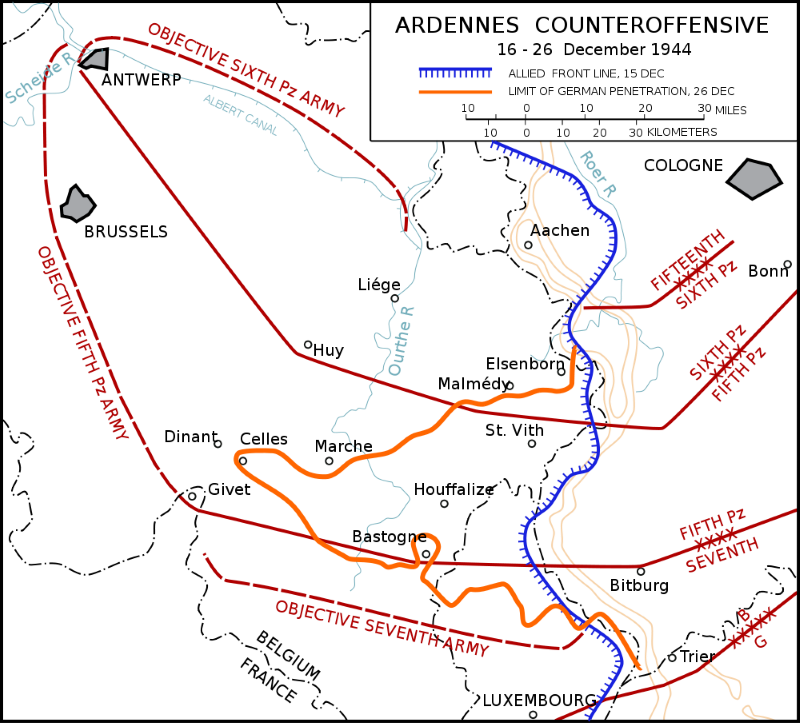16. WORLD WAR – ROUND TWO

THE WESTERN FRONT
CONTENTS
 A Western front opened in Normandy, A Western front opened in Normandy,
France, (June 1944)
 The Allies liberate Paris at the end of The Allies liberate Paris at the end of
August
 The German V-1 and V-2 missiles The German V-1 and V-2 missiles
 The Allies swing north into Belgium and The Allies swing north into Belgium and
Holland ("Market Garden")
 Then the Germans strike back – Then the Germans strike back –
producing the "Battle of the Bulge"
The textual material on page below is drawn directly from my work
A Moral History of Western Society © 2024, Volume Two, pages 183-188
... although the page below generally goes into greater detail.
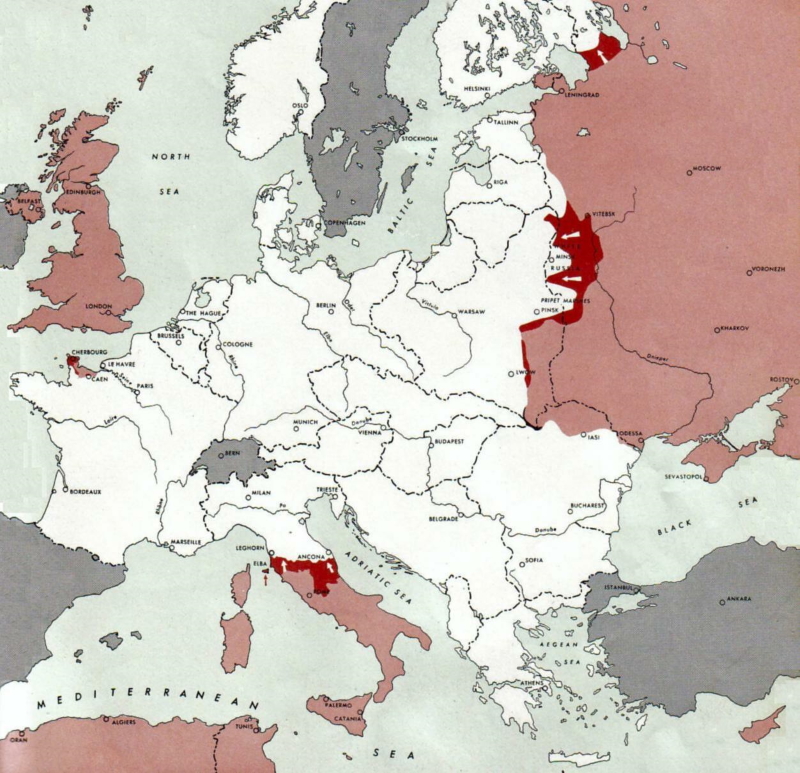
The battlefronts as
of July 1, 1944
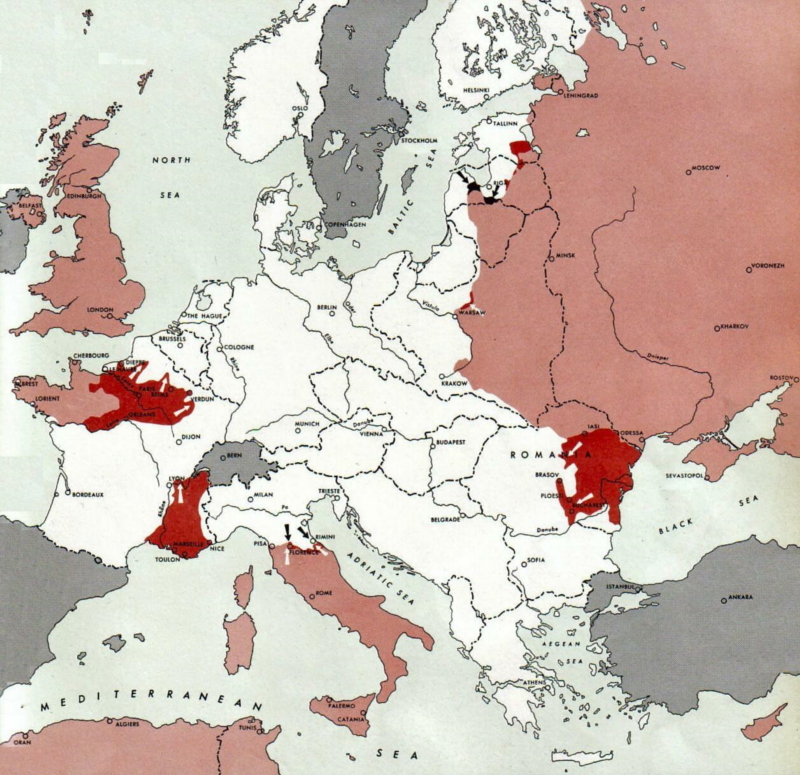
The battlefronts as of September
1, 1944
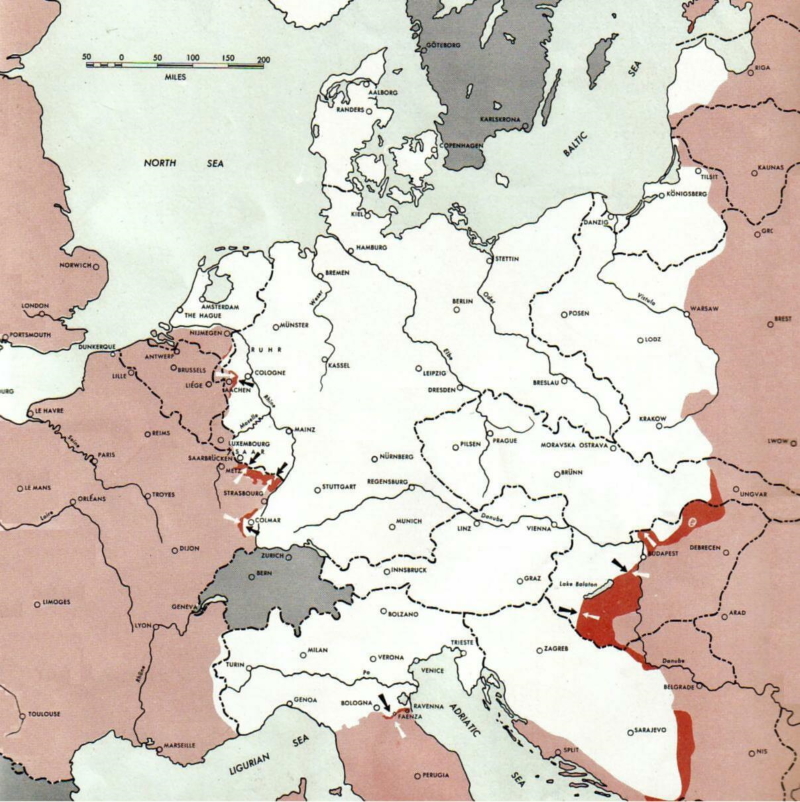
The battlefronts as of December
1, 1944
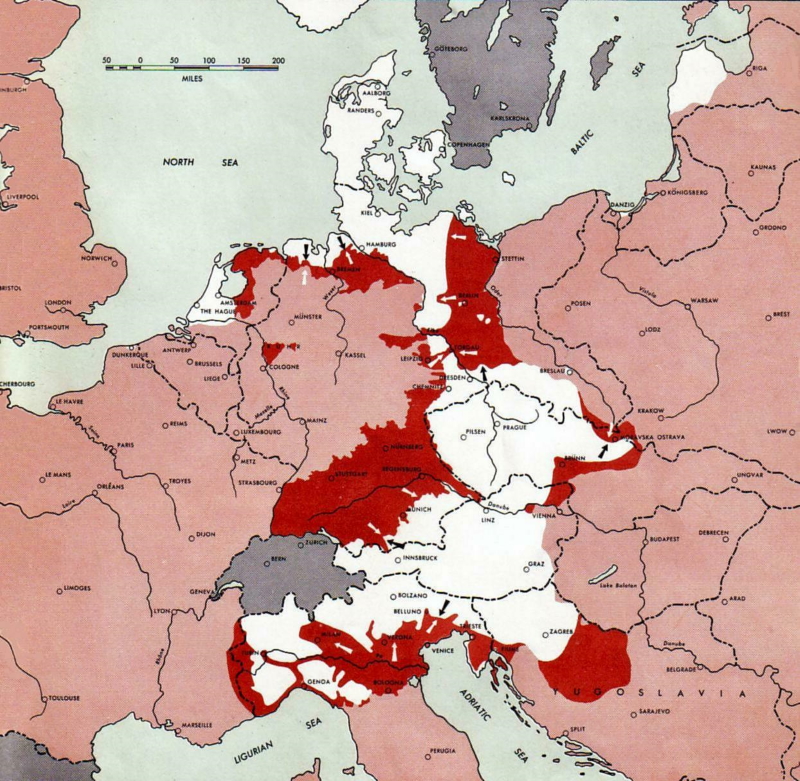
The battlefronts as of May
1, 1945
A
WESTERN FRONT OPENED AT NORMANDY IN FRANCE (JUNE 1944) FORCES THE GERMANS BACK IN THE WEST ("OPERATION OVERLORD") |
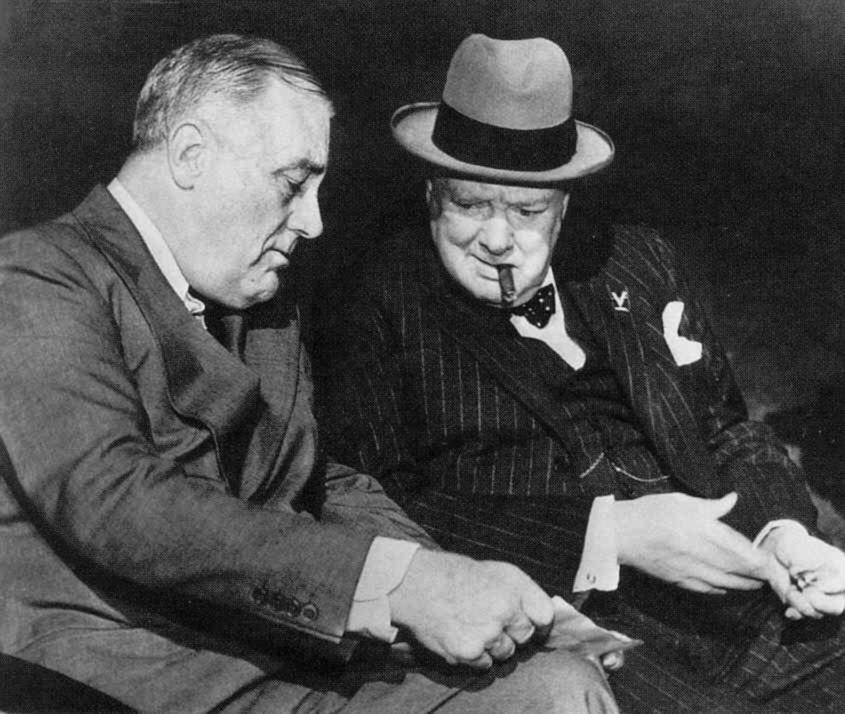 Roosevelt and
Churchill
Roosevelt and
Churchill
 The German military Enigma
machine
The German military Enigma
machine
The
plugboard, keyboard,
lamps, and finger-wheels of the rotors emerging from the inner lid of a
three-rotor German military Enigma machine
National Security
Agency
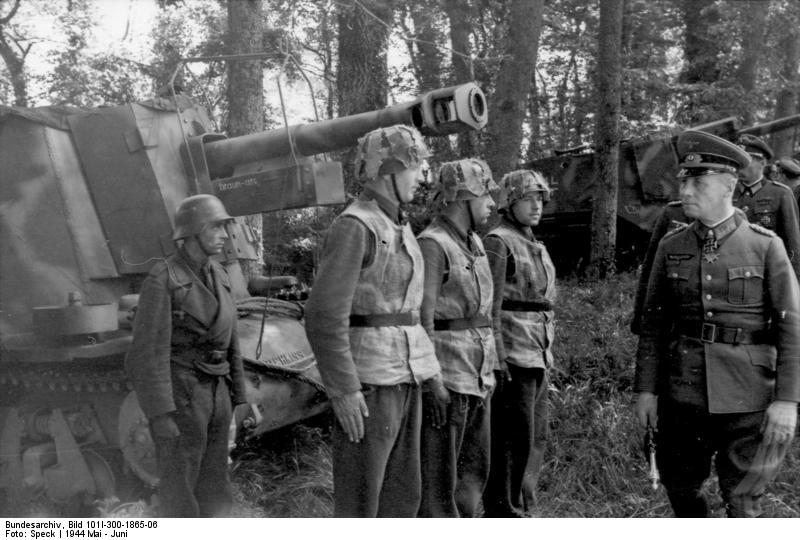 Erwin Rommel inspecting elements
of the 21 Panzer Division, May 1944
Erwin Rommel inspecting elements
of the 21 Panzer Division, May 1944
Deutsches Bundesarchiv

Eisenhower addressing troops
prior to Normandy invasion
U.S. Army
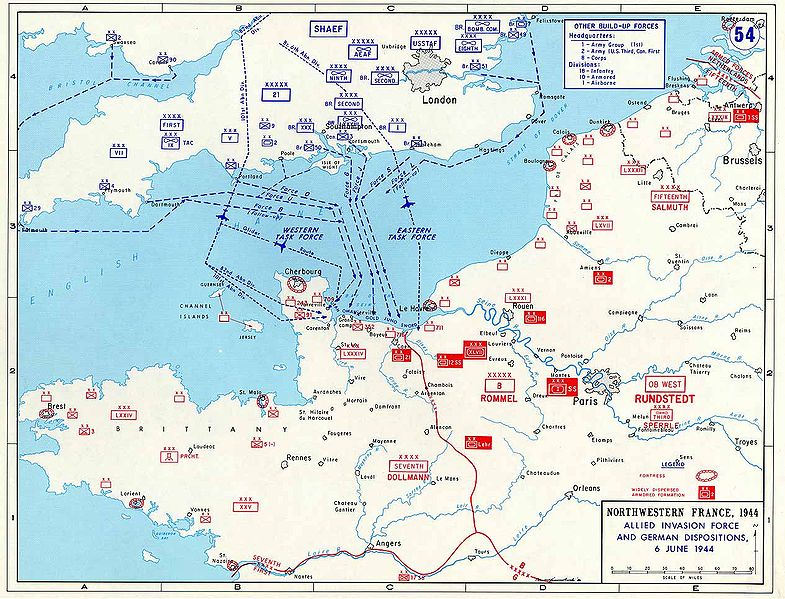
Allied invasion plans and
German positions in Normandy on D-Day (June 6, 1944)
U.S. Department of Defense
|
The Normandy landing begins the Battle of France (June 1944)
Stalin had long been pressing for the Allies to
open a front in the West in France, to relieve the pressure on the
Russians fighting the Germans in Eastern Europe. The Western
Allies’ focus on Italy seemed to Stalin to be simply a waste of assets
designed solely to serve the commercial (and military) interests of
Britain ... or worse, to position the Allies so as to be able to head
off a Russian movement into southeastern Europe (where Stalin was
hoping to establish a foothold that would allow Russia finally to
fulfill its long-held dream of direct access to the Mediterranean).
But the mishap at Dieppe had put serious
caution in the plans of the British and American allies.
Likewise, after Dieppe the Germans had seen to the emplacement of
concrete bunkers housing artillery and machine guns all along the
German’s Atlantic Wall. Going ashore against the German defenses
would be murderous for the Allies.
The Allies hoped to weaken the German line of
defense along the Atlantic Wall by convincing the Germans that the
crossing would occur way to the North of the area actually selected for
the landing. They thus created in the area just above the narrowest
point in the English Channel (just across from French Calais) a huge
phony army of dummy tanks and trucks and false radio communications –
ones that they were hoping German intelligence was analyzing. The fact
that Patton was appointed head of this phony army was thought
(correctly) to be the most convincing part of the ploy (Hitler and the
Germans were convinced that Patton was the Allies’ best general). And
indeed, Hitler was certain that the channel crossing of the Allies
would be happening at Calais. But in fact the Allied intentions were to
head their troops not east from England – but instead to a section of
the Normandy shoreline directly south of England … at a substantial
distance from Calais. The point of invasion was a highly-kept secret
all the way up until the time it was actually launched.
Training for the channel crossing
(Operation Overlord) took place over many months. But as the summer of
1944 approached, General Eisenhower knew it was time to move if they
were to cross France and reach Germany before winter set in. But bad
weather delayed the first date chosen for the crossing. Then a very
brief break in very bad weather finally gave Eisenhower the conditions
he needed before the tides began to change and the crossing would have
to be delayed by weeks. Because of that bad weather however the Germans
were not expecting any action from the Allies. In fact, Rommel took
those days off to head back to Germany for a visit to his wife.
Thus in the early hours of June the 6th,
160,000 American, British, Canadian and French troops went ashore along
a fifty-mile strip of the coast of southern Normandy. The Normandy
landing area was divided into five sectors: Utah (American), Omaha
(American), Gold (British), Juno (Canadian) and Sword (British and some
French). Omaha Beach and the Point de Hoc landing of Rangers (next to
Omaha Beach) were the sectors with the highest Allied casualties
because this area was defended by strong German emplacements atop very
tall cliffs. Juno was almost as bad, due to the German network of
bunkers along the seawall. Utah Beach produced the lightest Allied
casualties. The Airborne divisions dropped behind German lines also
suffered very high casualty rates.
|
The
Airborne attempt to hit
the Germans from the flanks and from behind the Atlantic wall
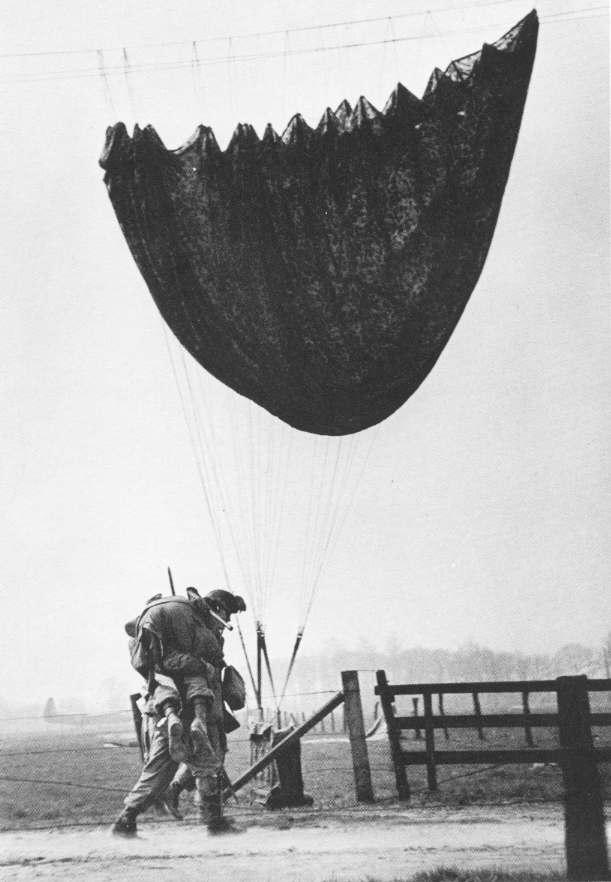
A paratrooper helping a fallen
buddy
Battleships attempt to soften
up the German resistance by hitting them with a heavy barrage
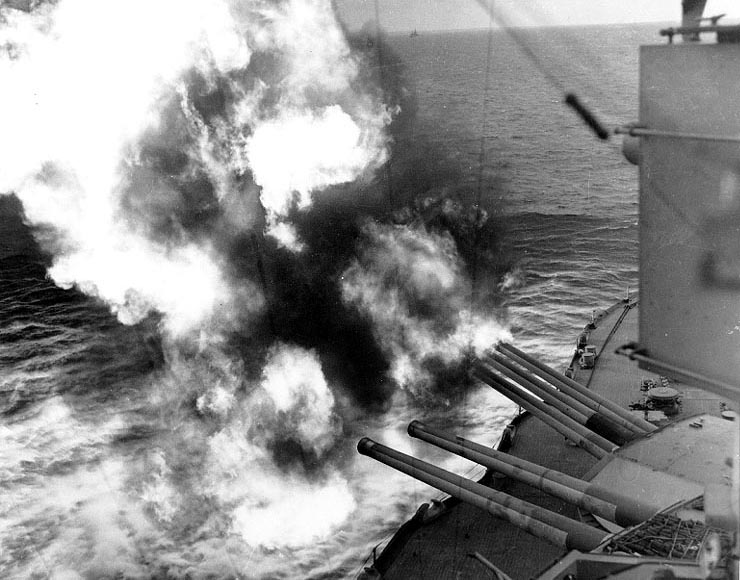 Forward 14"/45 guns of USS
Nevada (BB-36) fire on positions ashore, during the landings
Forward 14"/45 guns of USS
Nevada (BB-36) fire on positions ashore, during the landings
on "Utah"
Beach, 6 June 1944.
National Archives
Omaha Beach
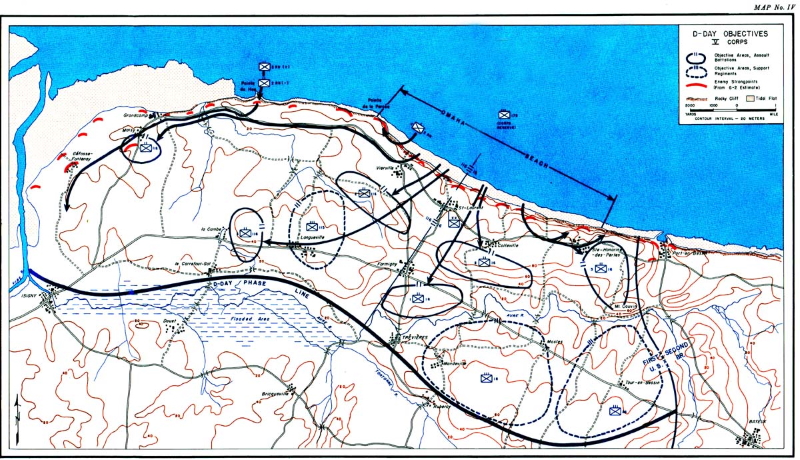
Official history map showing
the V Corps objectives for D-Day (Omaha Beach and Pointe du Hoc)
U.S. Department of Defense
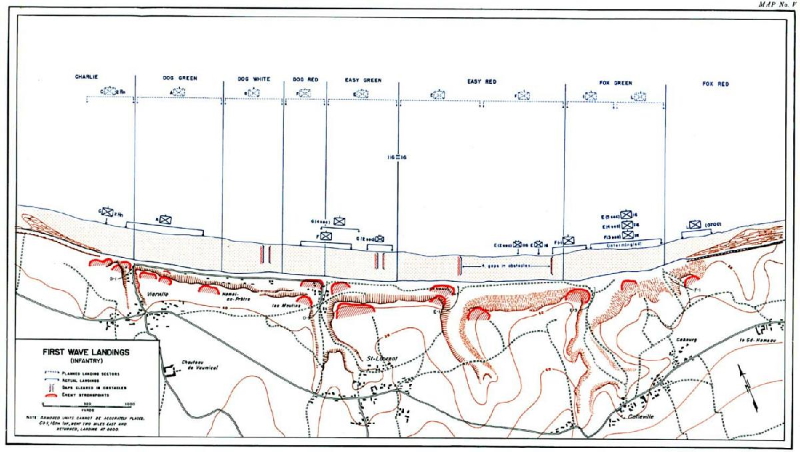
Omaha Beach - initial
landings
U.S. Department of Defense
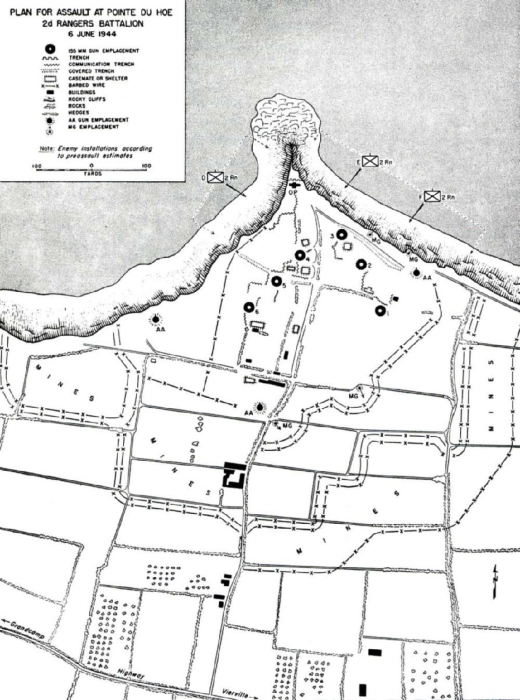
Map of Pointe du Hoc
U.S. Department of Defense
|
That night Roosevelt went on the radio to call the American nation to prayer:
My fellow Americans: Last
night, when I spoke with you about the fall of Rome, I knew at that
moment that troops of the United States and our allies were crossing
the Channel in another and greater operation. It has come to pass with
success thus far.
And so, in this poignant hour, I ask you to join with me in prayer:
Almighty God: Our sons, pride
of our Nation, this day have set upon a mighty endeavor, a struggle to
preserve our Republic, our religion, and our civilization, and to set
free a suffering humanity.
Lead them straight and true; give strength to their arms, stoutness to their hearts, steadfastness in their faith.
. . .
Some will never return. Embrace these, Father, and receive them, Thy heroic servants, into Thy kingdom.
And for us at home fathers,
mothers, children, wives, sisters, and brothers of brave men overseas
whose thoughts and prayers are ever with them help us, Almighty God, to
rededicate ourselves in renewed faith in Thee in this hour of great
sacrifice.
. . .
With Thy blessing, we shall
prevail over the unholy forces of our enemy. Help us to conquer the
apostles of greed and racial arrogancies. Lead us to the saving of our
country, and with our sister Nations into a world unity that will spell
a sure peace a peace invulnerable to the schemings of unworthy men. And
a peace that will let all of men live in freedom, reaping the just
rewards of their honest toil.
Thy will be done, Almighty God. Amen
|
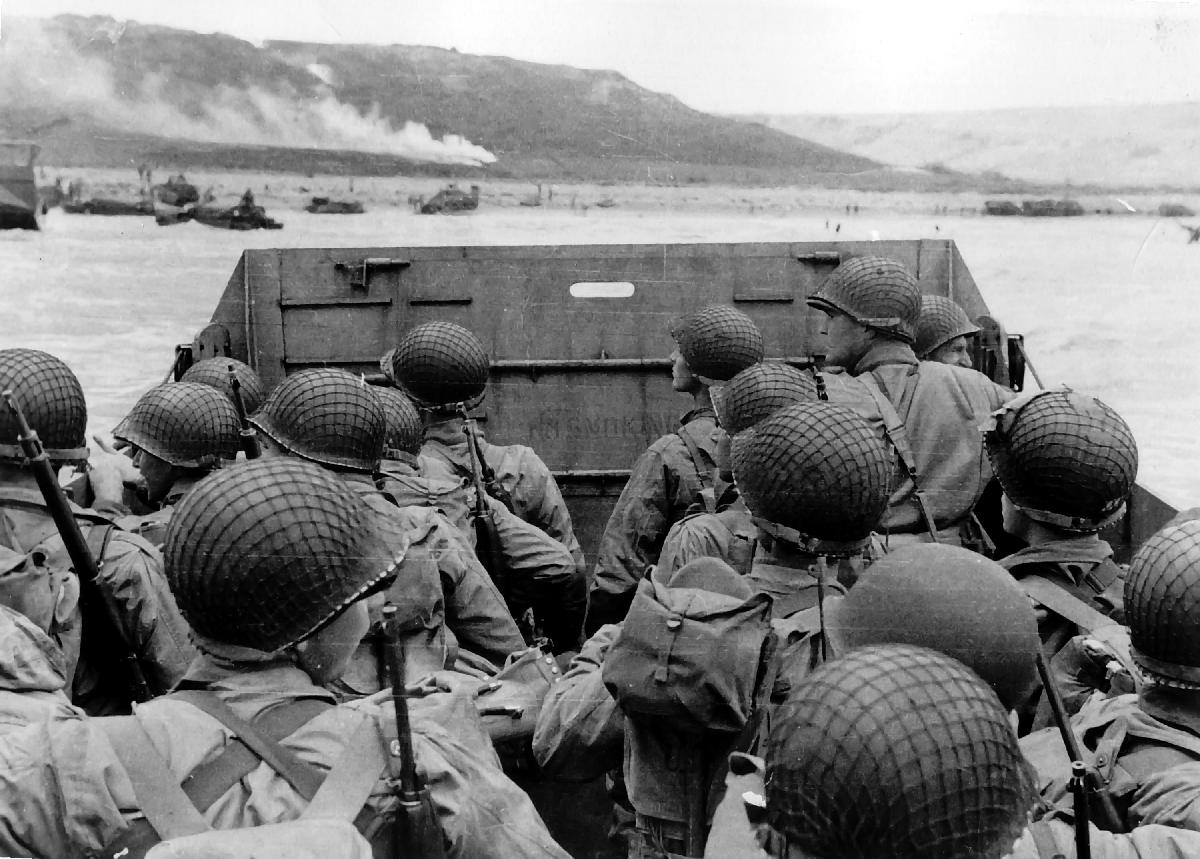
"Troops in an LCVP ('Higgins boat')
landing craft approaching 'Omaha' Beach on 'D-Day,' 6 June 1944. Note helmet netting, faint "No Smoking"
sign on the LCVP's ramp,
and M1903 rifles and M1 carbines carried by some
of these men."
US Army Signal Corp - National
Archives
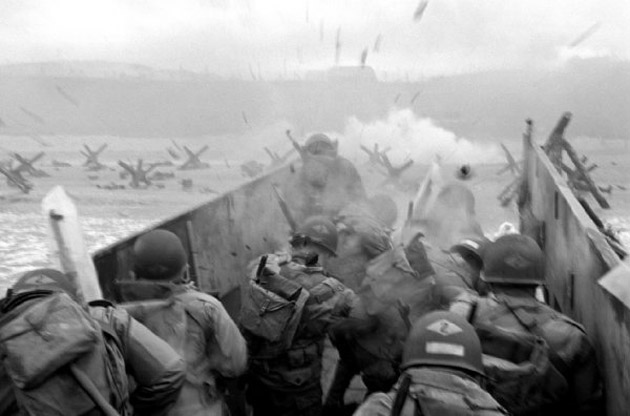 Soldiers taking direct hits from a German
machine gunner as the ramp drops down for unloading.
Soldiers taking direct hits from a German
machine gunner as the ramp drops down for unloading.
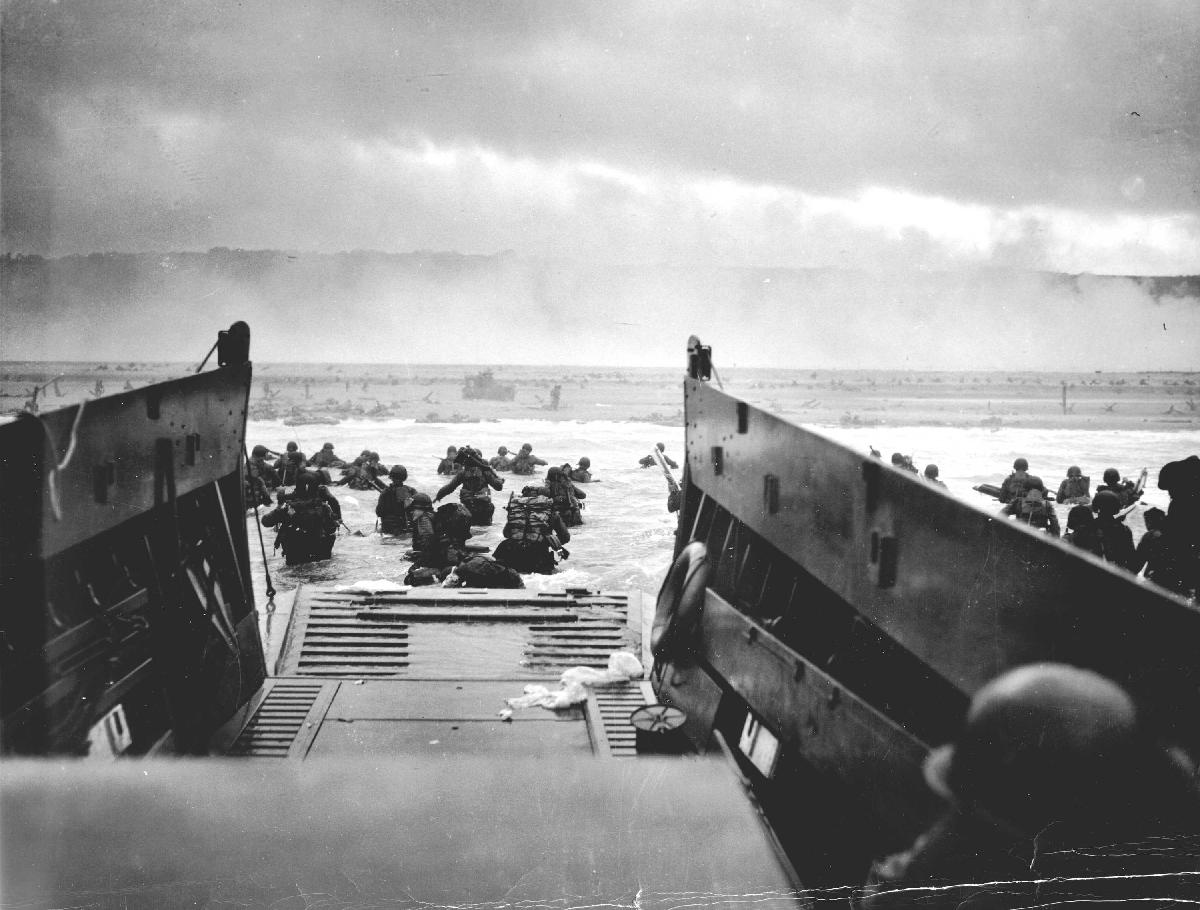
"Landing on the coast of
France under heavy Nazi machine gun fire are these American soldiers, shown
just as they left the ramp of a Coast Guard landing boat."
By CphoM. Robert F. Sargent,
June 6, 1944
National Archives
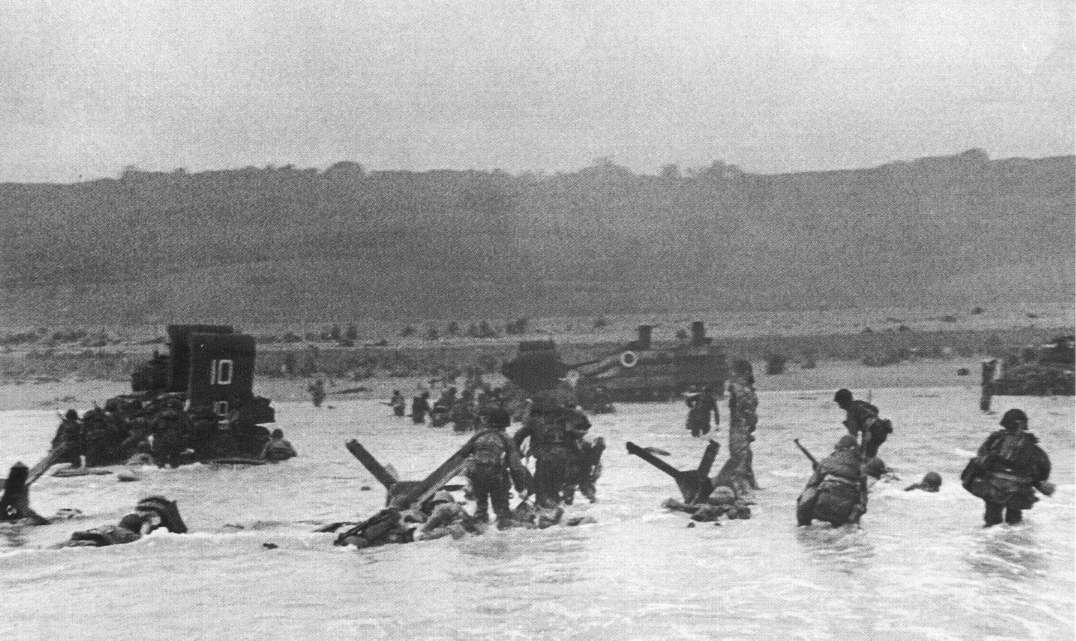
Normandy landing -
D-Day (June 6, 1944)
 "Members of an American landing
party lend helping hands to other members of their organization.
"Members of an American landing
party lend helping hands to other members of their organization.
Their landing craft was
sunk by enemy action off the coast of France.
These survivors reached
Omaha Beach by using a life raft." Photographer: Weintraub, 6 June 1944
Department of Defense
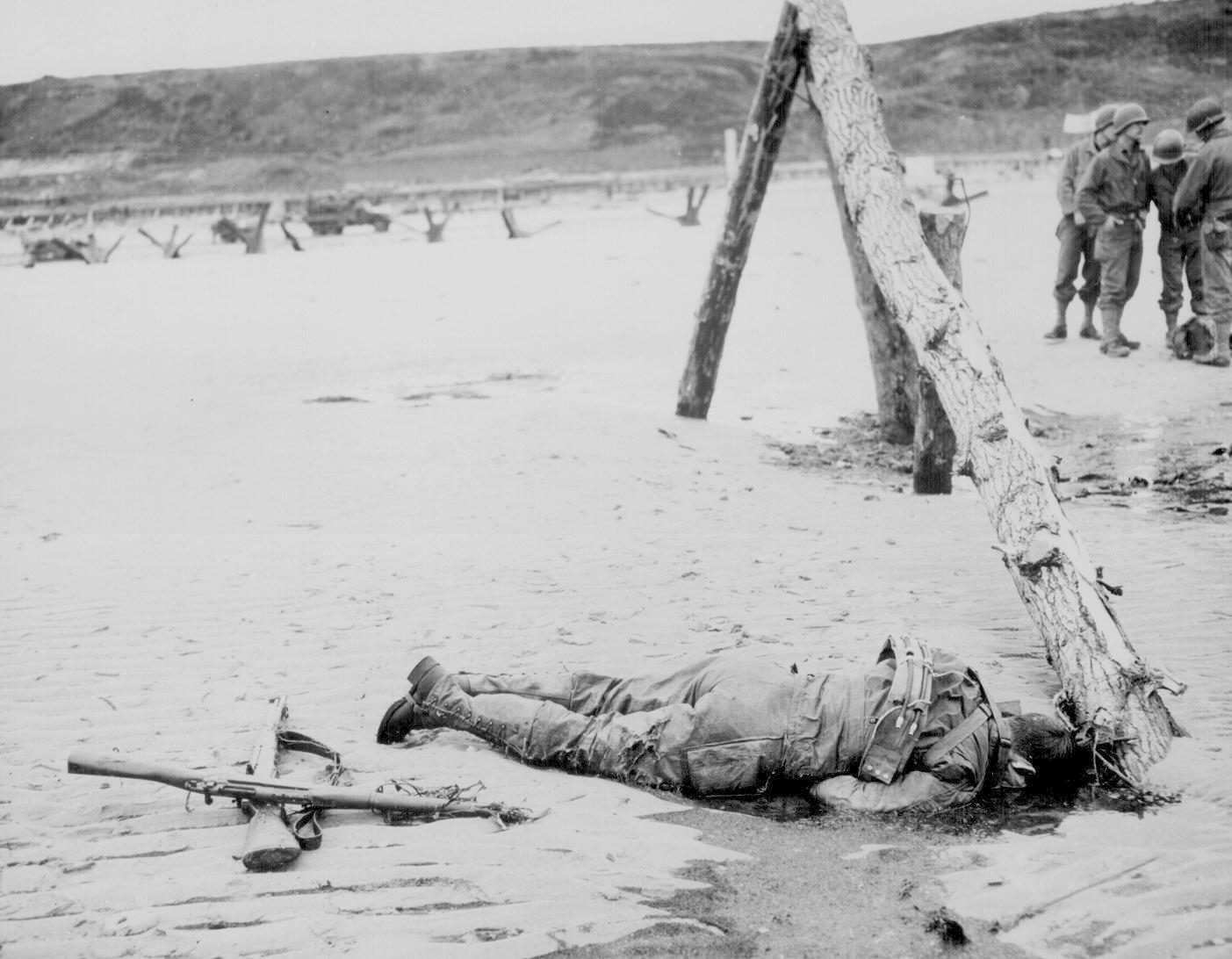
"Crossed rifles in the sand are a comrade's
tribute to this American soldier who sprang ashore from a landing barge
and died at the barricades of Western Europe." 1944.
National Archives 26-G-2397
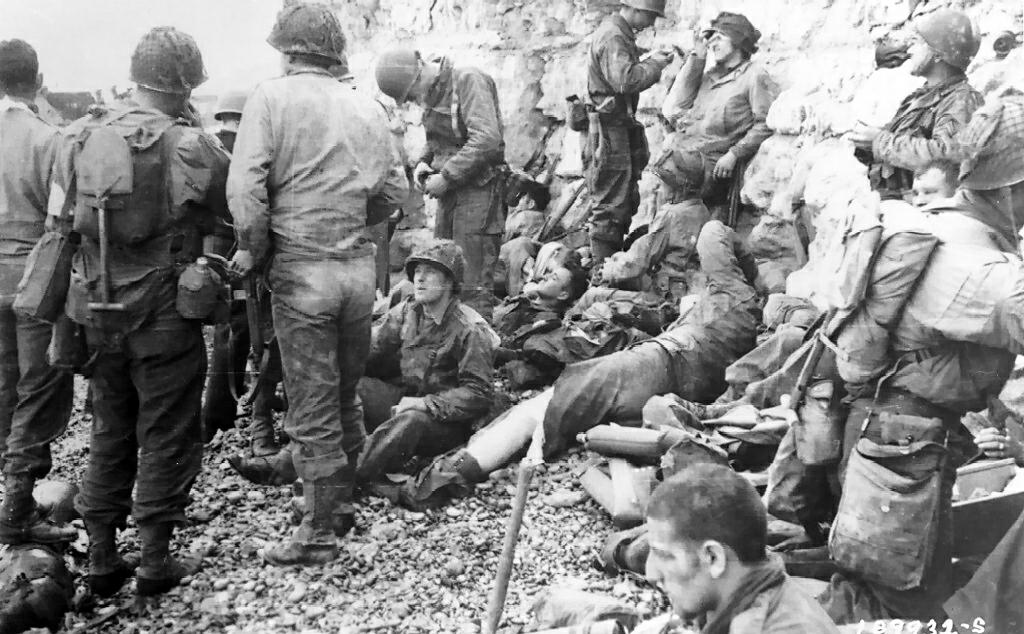
"American assault troops of
the 3d Battalion, 16th Infantry Regiment, 1st U.S. Infantry Division which landed in the first two waves,
sheltering at the foot of the chalk cliffs.
The cliffs indicate this was
in the area of Fox Red sector. Having gained the comparative
safety
offered by the chalk cliff at their backs, they take a 'breather' before
moving onto the continent at Colville-Sur-Mer, Omaha
Beach, in Normandy, France. Medics who landed
with the men treat
them for minor injuries." 8 Jun 1944.
U.S. Army
Utah
Beach
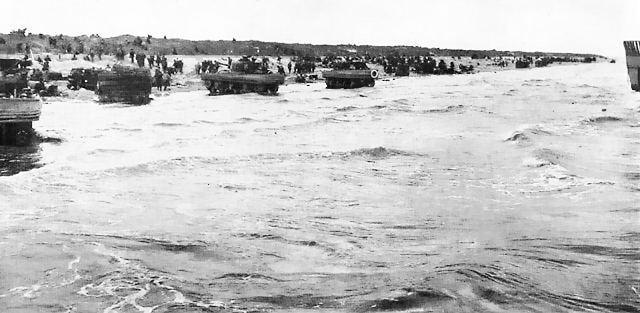
Going ashore on Utah Beach,
D-Day - 1944. Assault elements of Force U, including
DD tanks, were still on the beaches when this photo was
taken shortly after
H Hour. The amphibious tanks await the blowing of breaches in the sea wall.
U.S. Army
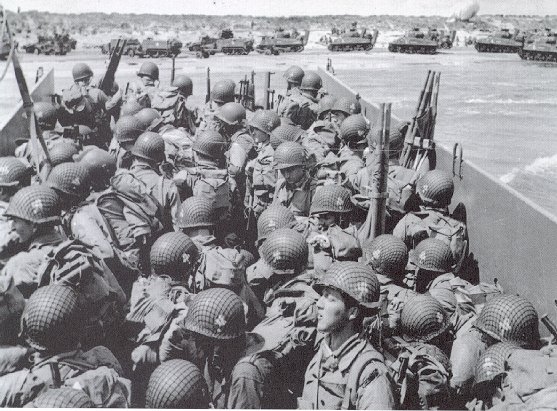
Going ashore on Utah Beach,
D-Day - 1944
U.S. Army
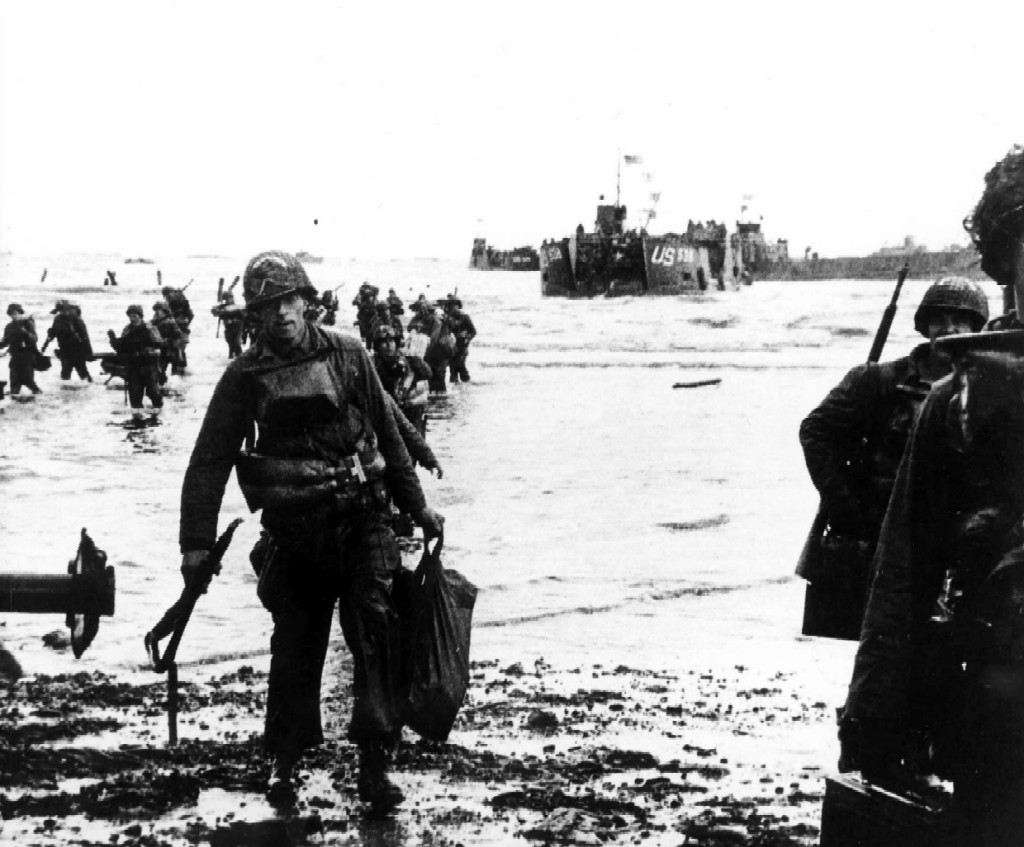
Going ashore on Utah Beach,
D-Day - 1944. Carrying a full equipment, American
assault troops move onto Utah Beach on the northern
coast of France. Landing
craft, in the background, jams the harbor. 6 June 1944.
U.S. Army
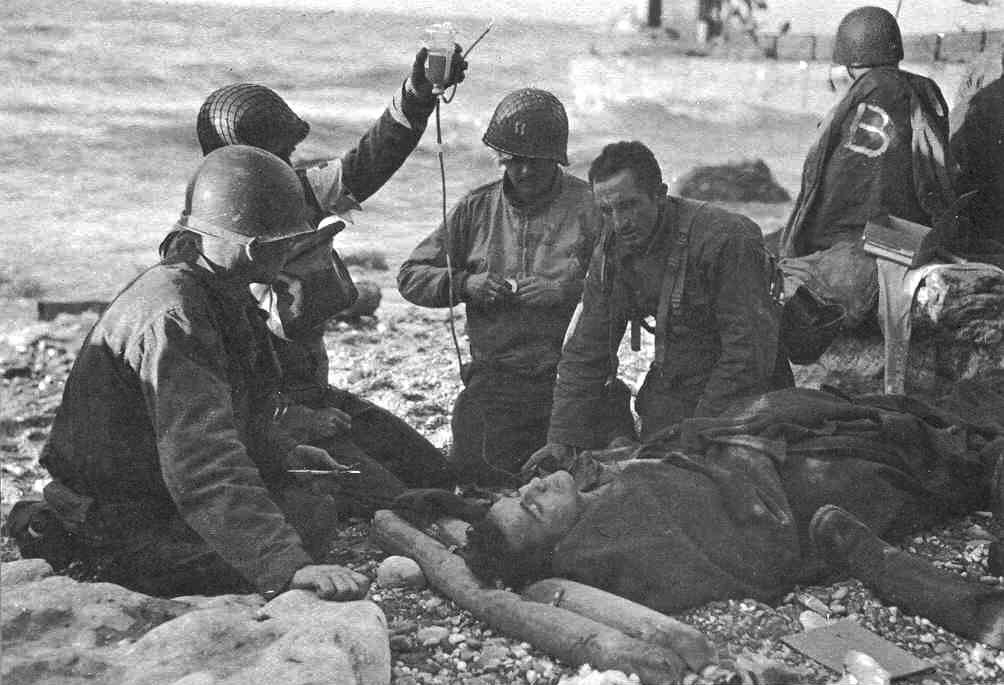
American wounded on Utah
Beach, D-Day - 1944
Department of the Army
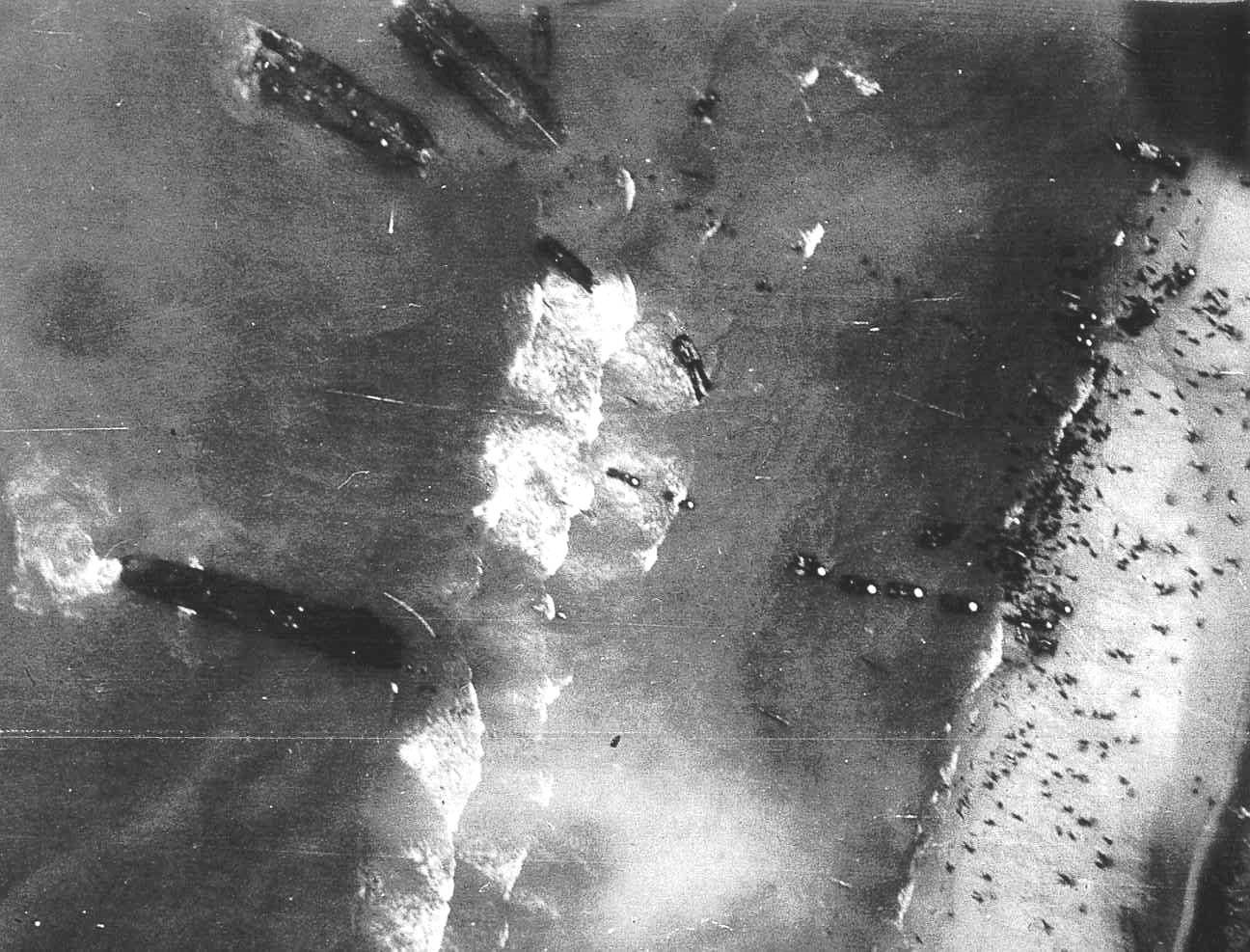
Utah Beach
National Geographic
– June 2002, pp. 25-26
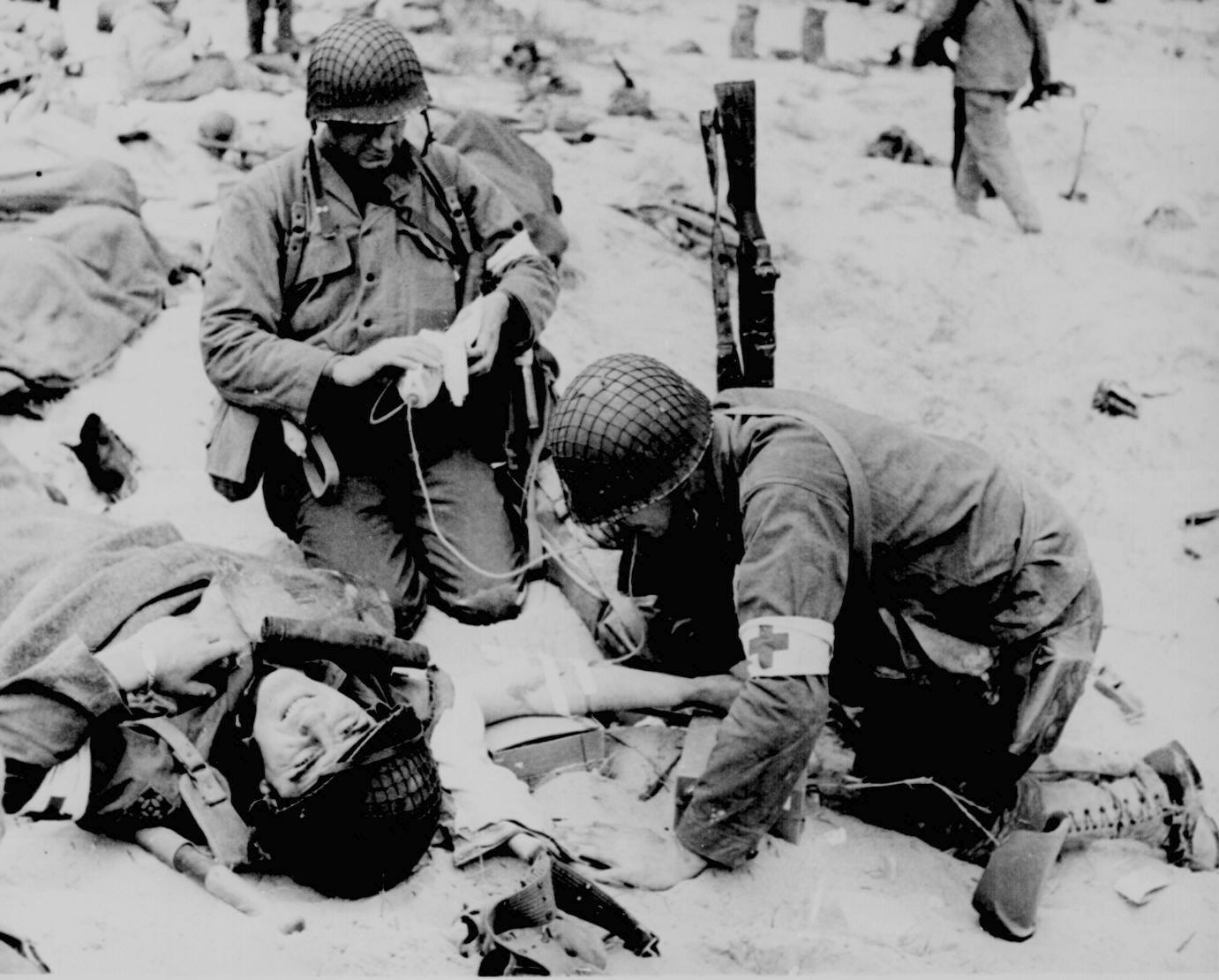
Medics helping injured soldier, France,
1944.
National Archives 208-YE-22
Sword, Juno and Gold Beaches
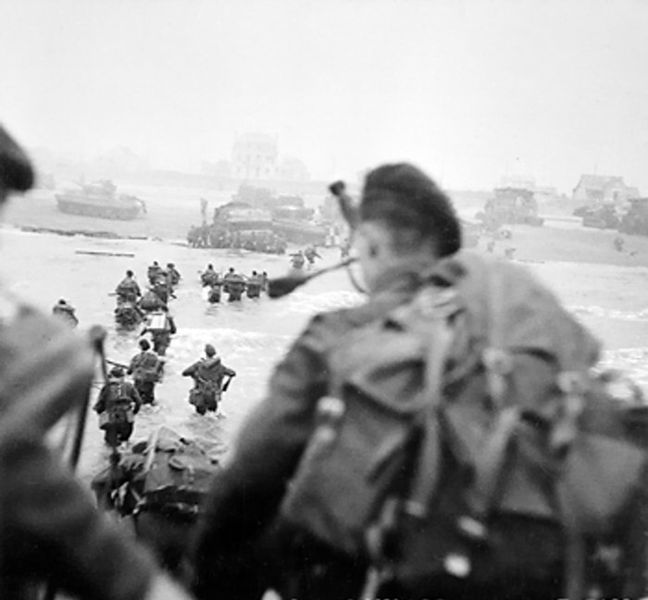
|
British troops going ashore
at Sword Beach, D-Day - 1944
"The
British 2nd Army: Commandos
of 1st Special Service Brigade landing from an LCI(S) (Landing Craft
Infantry
Small) on 'Queen Red' Beach, SWORD Area, at la Breche, at approximately
8.40 am, 6 June. The brigade commander, Brigadier the Lord Lovat DSO
MC, can be seen striding through the water to the right of the column
of men.
The figure nearest the camera is the brigade's bagpiper, Piper Bill
Millin"
Imperial War Museum,
London
|
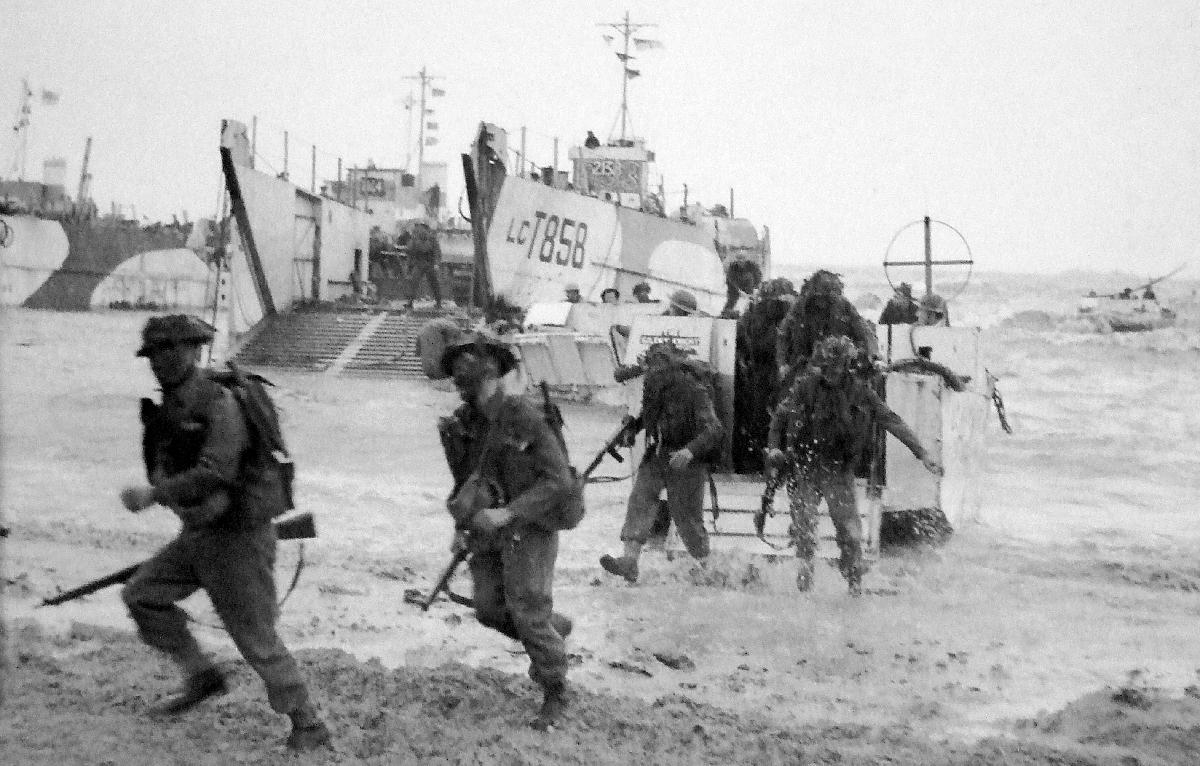
British Commando troops of
the 50th (Northumbrian) Infantry Division coming ashore from LCIs
(Landing
Craft Infantry) Gold Beach, D-Day -
1944
Imperial War Museum,
London
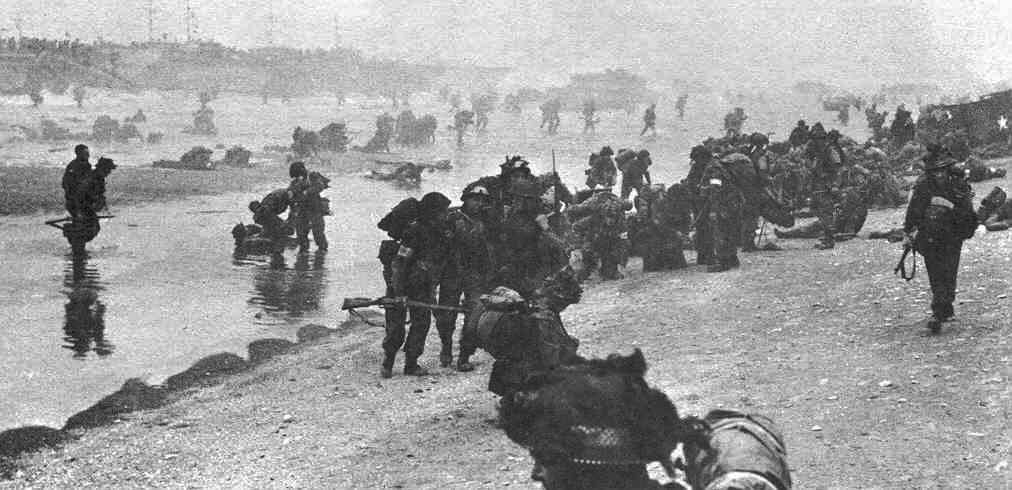
British troops advancing
toward Caen, D-Day - 1944
Imperial War Museum,
London
The German defense begins
to weaken
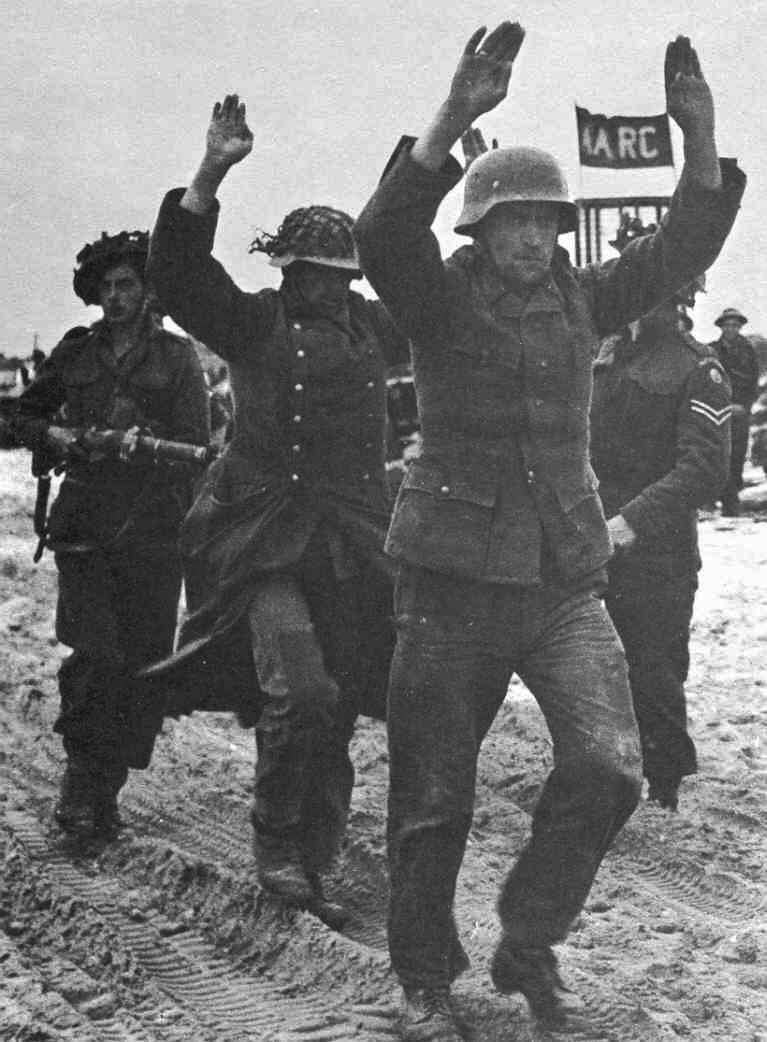
British soldier and captured
Germans, D-Day - 1944
Imperial War Museum,
London
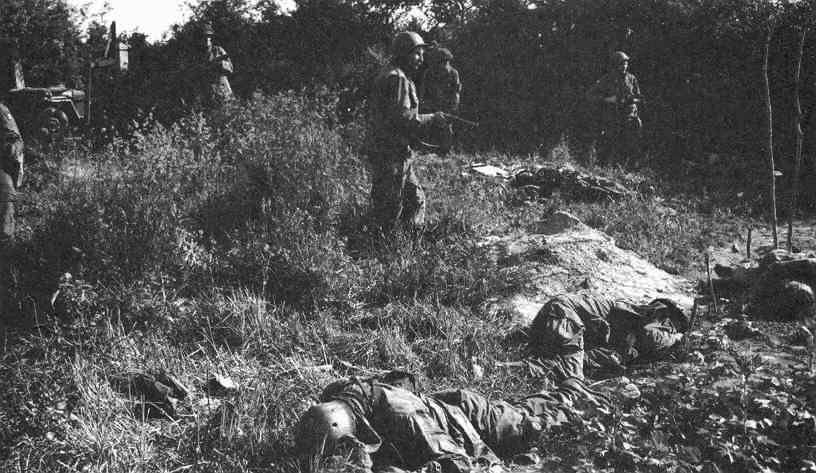
US airborne troops behind
German lines on D-Day - 1944
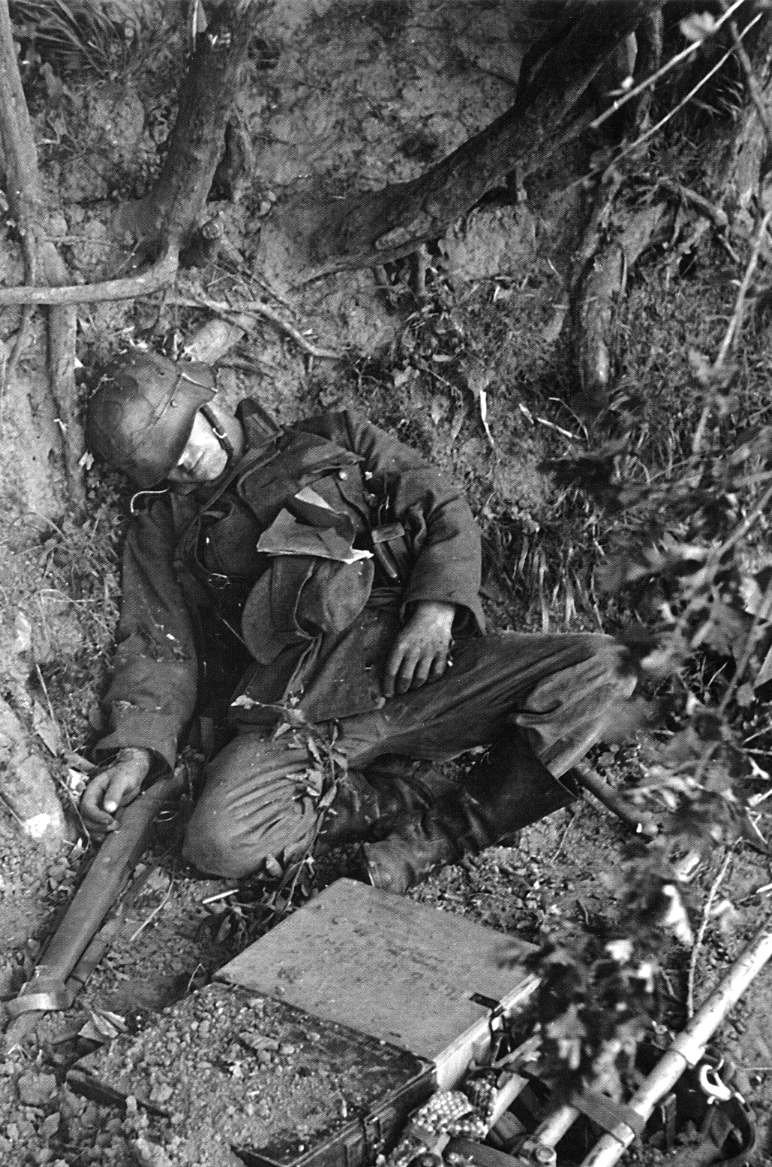
German D-Day
casualty
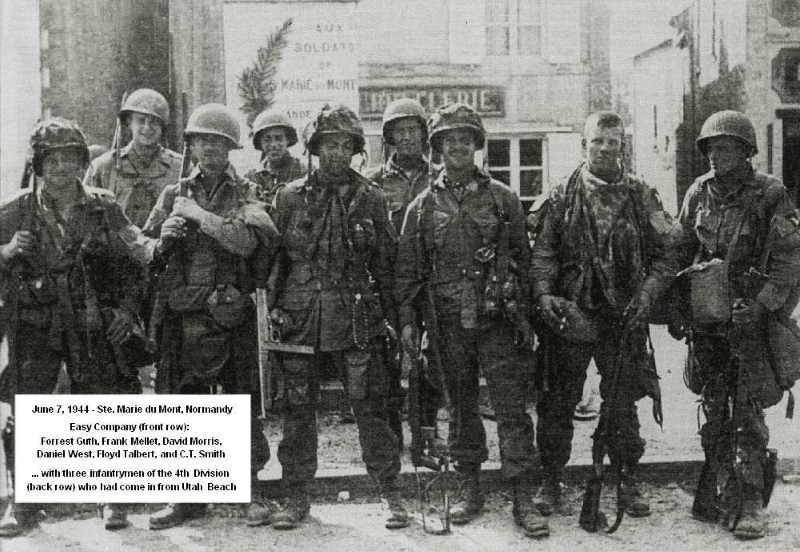
Paratroopers of Easy Company,
506th Regiment of the 101st Airborne Division after having seized Ste.
Marie du Mont from the Germans (June 7, 1944)
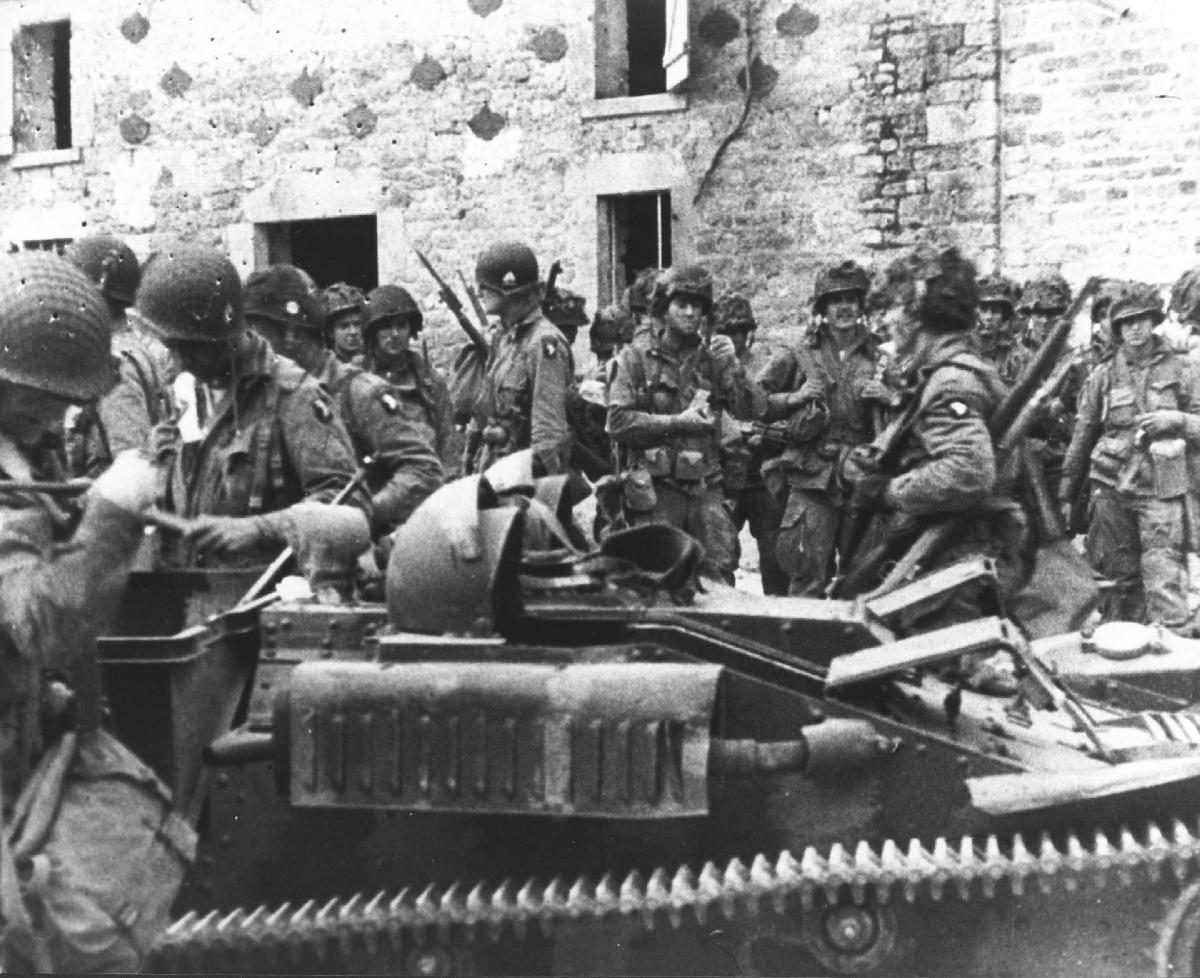
A group of paratroopers in
a French village at St. Marcouf, Utah Beach, France. From here they will move
on into the continent, accomplishing their assigned objectives. 8 June
1944.
U.S. Department of Defense
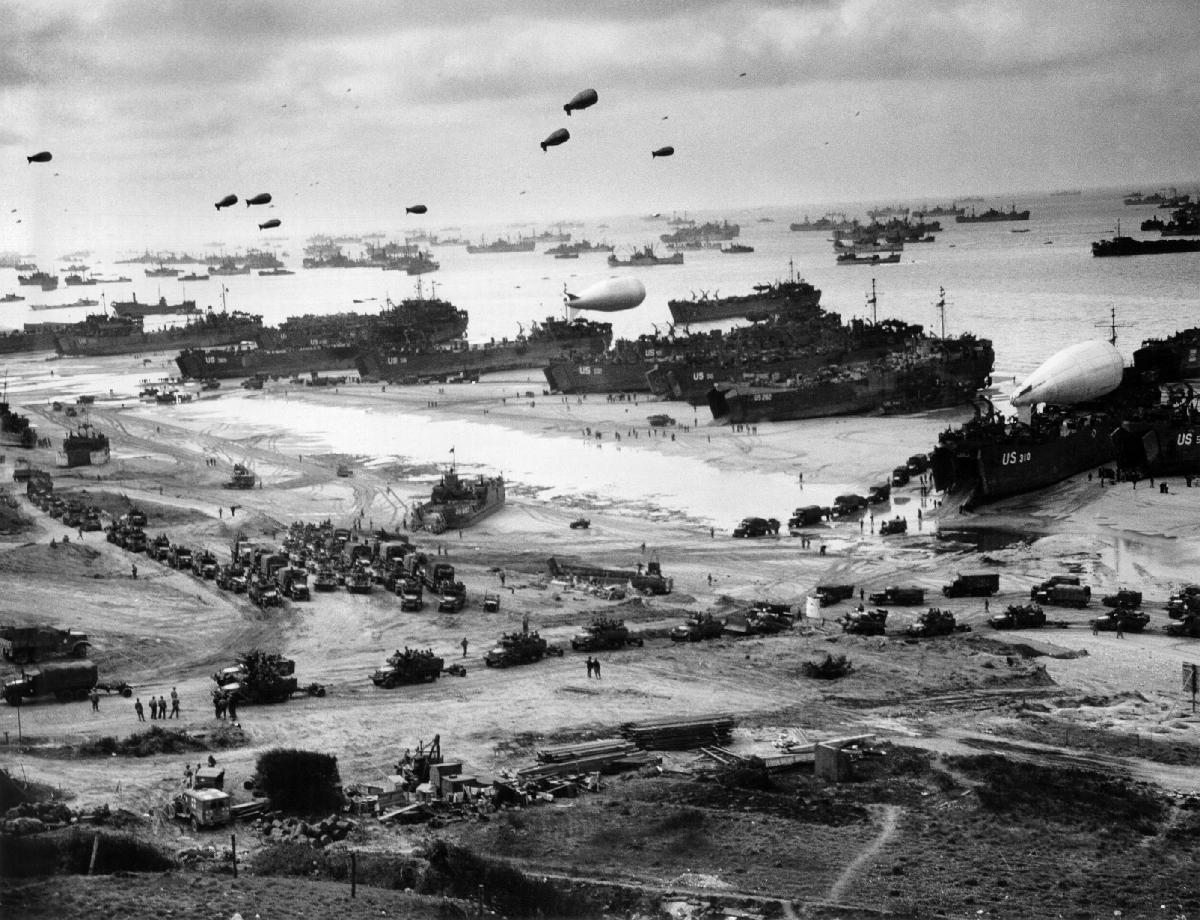
|
Landing ships putting
cargo ashore on Omaha Beach, at low tide during the first days of the operation,
mid-June, 1944. Among identifiable ships present are LST-532 (in the center
of the view); USS LST-262 (3rd LST from right); USS LST-310 (2nd LST from
right); USS LST-533 (partially visible at far right); and USS LST-524.
Note barrage balloons overhead and Army "half-track" convoy forming up
on the beach. The LST-262 was one of 10 Coast Guard-manned LSTs that participated
in the invasion of Normandy, France.
United States Coast Guard
Collection
|
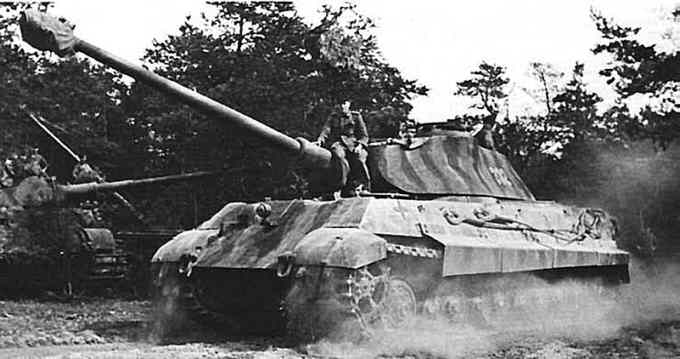 Tiger II tank
Tiger II tank
|
The Allies’ greatest fear was that
Rommel would reposition his tanks from Upper to Lower Normandy (where the
Allies had actually come ashore). But Hitler considered the landing
there merely a diversionary tactic to draw his tanks away from the real
landing area … and would not give Rommel permission … until it was too
late
|
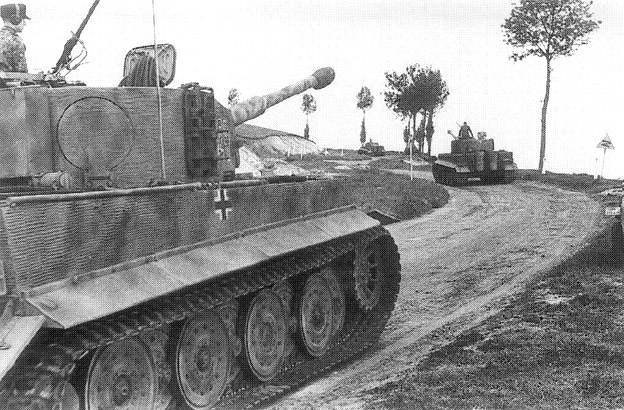 A German Tiger II tank nears
Normandy
A German Tiger II tank nears
Normandy
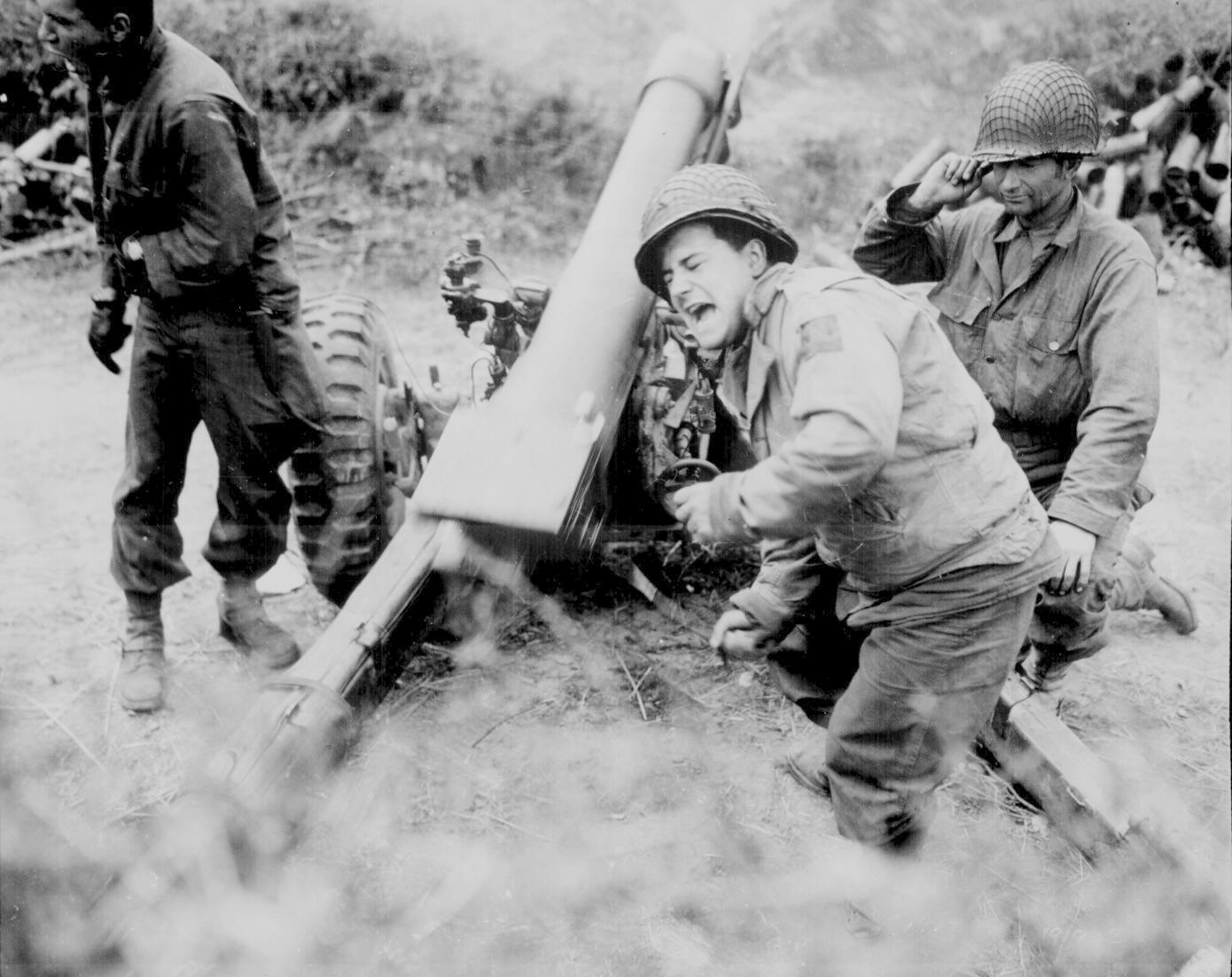
"American howitzers shell
German forces retreating near Carentan, France." - July 11, 1944.
National Archives
111-SC-191933.
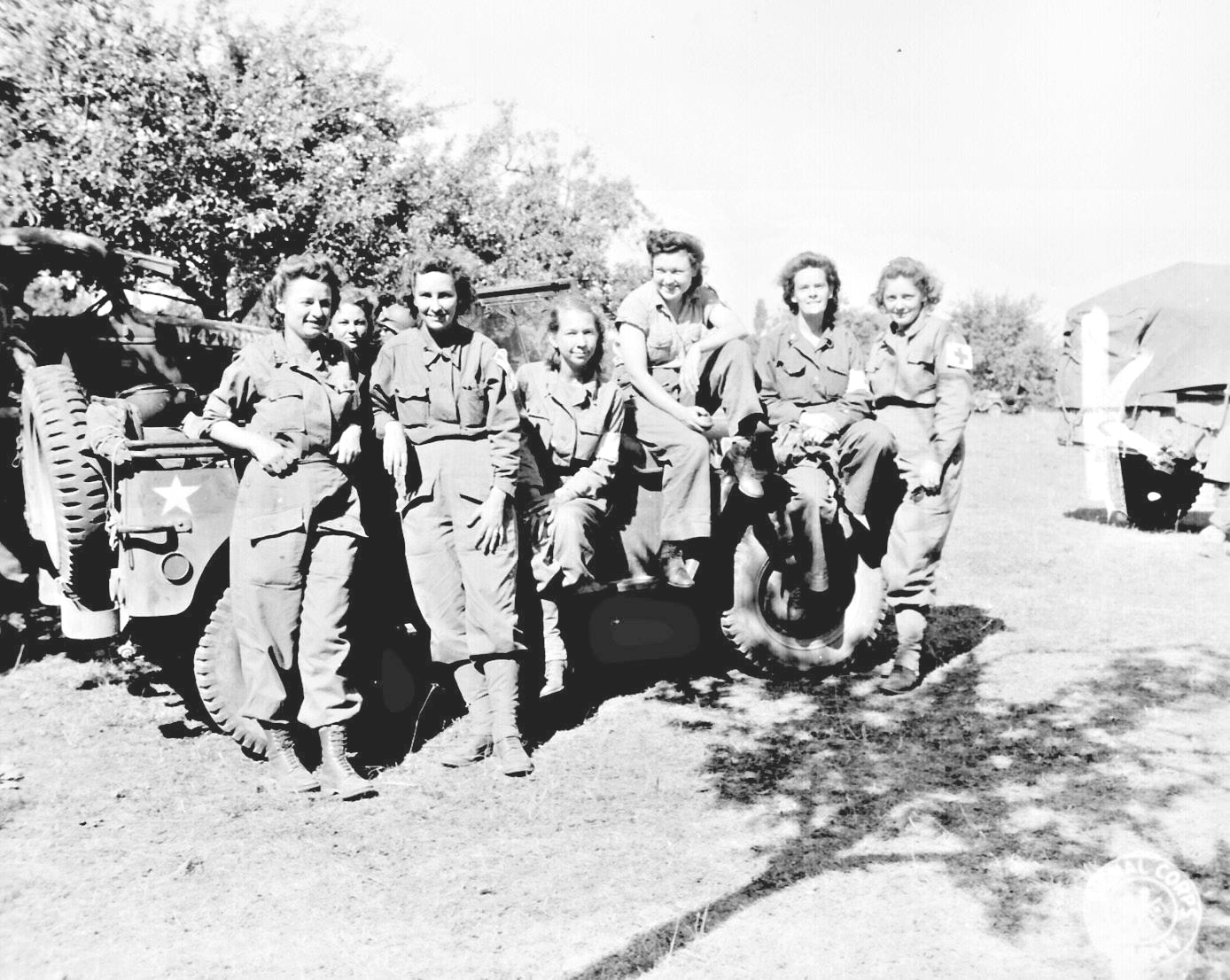
"Nurses of a field hospital who arrived
in France via England and Egypt
after three years service." August
12, 1944.
National Archives
112-SGA-44-10842
|
The advance again Hitler’s forces in
France
The landing ultimately proved to be a
success. Hitler at first refused to reposition his troops gathered
further north at Calais, considering the Allied landing to be merely a
feint designed to draw troops away from Calais so as to make Patton's
invasion easier (there was, of course, no such Patton invasion). For
days Hitler hesitated before he finally came to the realization that
this was the massive assault that the Germans had long been expecting.
But by that time the Allies were well planted in Normandy and moving
inland fairly quickly.
Several problems however complicated the
Allied advance. The British were expected to liberate the city of Caen
almost immediately. Their landing had been largely unopposed, but in
reaching the outskirts of Caen the Germans showed themselves prepared
to put up a major fight. Consequently, this key hinge point took
two months to bring under Allied control. Also the farms of Normandy
were outlined not by fences but by huge, thick centuries-old hedges
that gave the Germans great defensive opportunities and made progress
of the Allied tanks and infantry almost impossible, until an immense
steel fork was created to be placed on the front of the tanks, allowing
them simply to plow through the hedges. With that innovation, the
advance against the Germans proceeded much more quickly.
At one point a huge German army was
nearly surrounded by the advancing Allies. But failure to close quickly
a gap in the circle allowed most of the Germans to escape and
reorganize further east against the Allied advance. Nonetheless, the
Germans were tiring and running out of men and supplies. At this point
(August) the Allied move across France towards Germany was advancing
quickly.
FROM
NORMANDY THE ALLIES MOVE QUICKLY TOWARD PARIS, LIBERATING THAT CITY AT THE END OF AUGUST |
The decision to liberate Paris
rather than head directly to a Rhine crossing
The decision to head from Normandy straight to Paris seemed a logical
idea - especially to the French. But Eisenhower had other thoughts.
Supplies were short. The Allies had only the shore landings at Normandy
to bring supplies ashore and had not yet captured a major French
seaport where they could bring in the masses of supplies needed to
support the offensive against the Germans. Thus Eisenhower wanted to
waste no effort to get to the German border defenses at the Rhine as
soon as possible, certainly before the autumn season ended (and bad
weather would bog down the Allied offensive) and then head quickly on
to Berlin. The hope was to bring Hitler to defeat in Berlin before
Christmas. To divert forces to remove the Germans from Paris (rather
than just encircle them and slowly strangle them to submission) would
be costly in terms of supplies, and would delay considerably the effort
to get across the Rhine before the bad late fall weather set in.
But there were other considerations that weighed heavily in favor of a
direct effort to liberate Paris. The French Resistance, including tens
of thousands of irregular militia or Partisans, stood ready ... though
greatly divided among themselves politically in a range of various
subgroups loyal to different commanders. The biggest divide within the
Resistance was between the Communist Partisans, led by Henri Tanguy,
and the Free French Partisans led by an uneasy Free French alliance of
General Charles de Gaulle and General Jacques Phillippe Leclerc (the
Americans and British had favored Leclerc rather than the
self-promoting de Gaulle, with whom they had constant difficulties).
Tanguy and his Communist Partisans stood ready not only to expel the
Germans, but bring Paris (and thus France) under Communist dominion.
That was something that neither the Americans nor the British wanted to
see happen. Thus they were forced to support de Gaulle in his move to
get himself and some of his Free French army into Paris to join the
Free French Partisans before Tanguay and his Communist Partisans could
grab control.
Considerable risk accompanied this decision to advance on Paris. The
Allies were really not ready to waste Paris in order to bring the
Germans to defeat - handicapping greatly their military effort. Hope
was that the Germans were not ready to do the same in their own
defense, though the fact that Hitler had sent Major General Dietrich
von Choltitz to Paris to take charge of the German defense of the city
made them nervous. Von Choltitz was known to be a ruthless Prussian
commander who had been greatly responsible for the thorough destruction
of both Rotterdam in Holland and Sebastapol in Russia. The Allies did
not know that he had instructions from Hitler to completely demolish
Paris (leave not one Paris church, bridge, monument or landmark
standing) rather than surrender the city intact - but they rather
suspected something like that was bound to happen given Hitler's move
to send von Choltitz there.
Speed, surprise, and caution in handling the situation were all called
for. But de Gaulle and his Free French were already rapidly on the move
toward Paris before Eisenhower finally came to the decision to divert
the offensive away from the Rhine and toward Paris. De Gaulle had to
get his troops into Paris before Tanguy's Communist Partisans could get
themselves in position to take the city.
This meant that a lot of blood was going to be spilled in getting to
the city. Paris was surrounded by a lot of artillery, though the German
troops themselves were scattered and were not themselves
battle-hardened soldiers, having lived the good life as Paris occupiers
for four years. Choltitz even turned the anti-aircraft guns into field
artillery since he suspected that the Allies would not try to take
Paris from the air through bombardment of the city but on the ground
through infantry and tanks. And he was right.
But the Free French were so charged up with the thought of taking Paris
from the Germans that their tanks kept pressing forward against the
withering fire of the Germany artillery, simply overruning the German
guns in the process (and losing a lot of troops). And on to Paris
center (August 25, 1944) they headed, catching the thinly spread
Germans unready to offer serious resistance. Pockets of entrenched
Germans (and snipers) put up a valiant last-ditch effort to hold the
city, though there was little hope for their success - as the Parisians
took to the streets and the Communist and Free French Resistance rose
up and took the Paris districts by force. The Germans were brought
quickly to surrender.
De Gaulle was quick to lead the victory march of his troops down the
broad main street of Paris, the Champs-Elysées, putting himself out
front prominently as the "Liberator" of Paris. The Communists were
forced to settle for second place (a major political setback for them).
And when then a few days later a long line of American tanks and troops
also came down the Champs Elysées, there was no longer any possibility
that the city would go Communist, but instead would go center-right in
political orientation.
Why did von Choltitz not follow his orders to blow up Paris? Explosives
were planted everywhere in the city, ready to crumble the city to the
ground. Von Choltitz would later claim that it was his own conscience
that prevented him from doing such a dastardly deed. The
collaborationist French mayor of Paris, Pierre Charles Tattinger, also
took credit in stating that he had made a very strong personal appeal
to von Choltitz to go down in history not as the man who destroyed
Paris, but as the one who had the opportunity to do so and chose to go
against his Führer and not destroy the City of Light. Others claim that
the Resistance moved so quickly in removing the demolition planted by
the Germans that von Choltitz's order to destroy Paris would have had
little impact. No one really knows the full story. But aside from the
hold out of a few German troops and snipers located here and there, the
city that most people considered the most beautiful in the world was
given over to Allied hands without a major catastrophe befalling it.
On the other hand, the cost of the decision to delay the Rhine crossing
in order to liberate Paris was very, very high. This gave Hitler time
to reorganize his troops in the West, snuf out British General
Montgomery's hope to quickly cross the Rhine in the North in Holland
before the Germans could react (and thus open a very direct and lightly
defended path to Berlin), even give the Germans the time to organize
enough for one last push to throw the Allied effort back to the
Atlantic (a combination of V-2 bombs and the German winter offensive
known in the West as the "Battle of the Bulge") ... and worst of all,
give him that much more time to try to complete the eradication of the
entire European Jewish community with his "Final Solution." Thus a lot
of lives were lost elsewhere because of the decision to redirect the
Allied war effort toward Paris.
In short, a precious, precious price was paid to spare a precious, precious Paris ... a hard but momentous decision. |
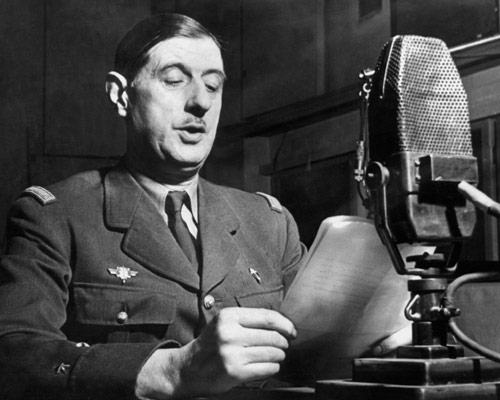 Charles de Gaulle on BBC
radio during the war
Charles de Gaulle on BBC
radio during the war
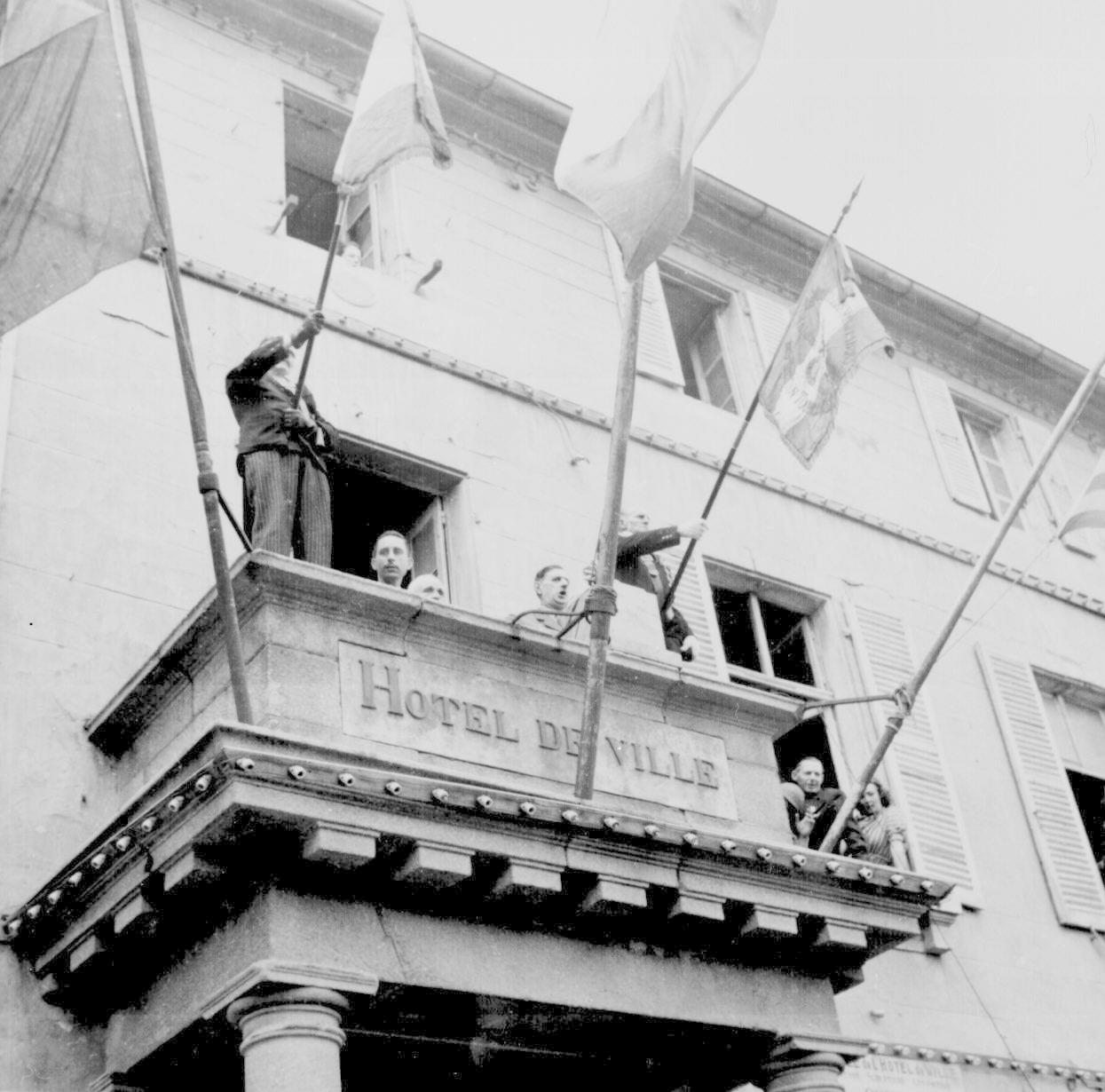 "General Charles de Gaulle
speaks to the people of Cherbourg from the balcony of the City Hall during his visit to the
French port city on August 20." 1944.
"General Charles de Gaulle
speaks to the people of Cherbourg from the balcony of the City Hall during his visit to the
French port city on August 20." 1944.
National Archives
208-MFI-5H-1
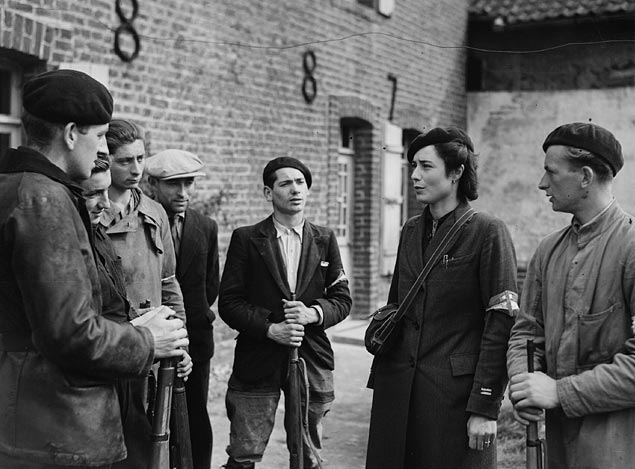 Members of the Maquis
(French Resistance) in La Tresorieie - Boulogne, France, 14 September
1944
Members of the Maquis
(French Resistance) in La Tresorieie - Boulogne, France, 14 September
1944
Library and Archives Canada
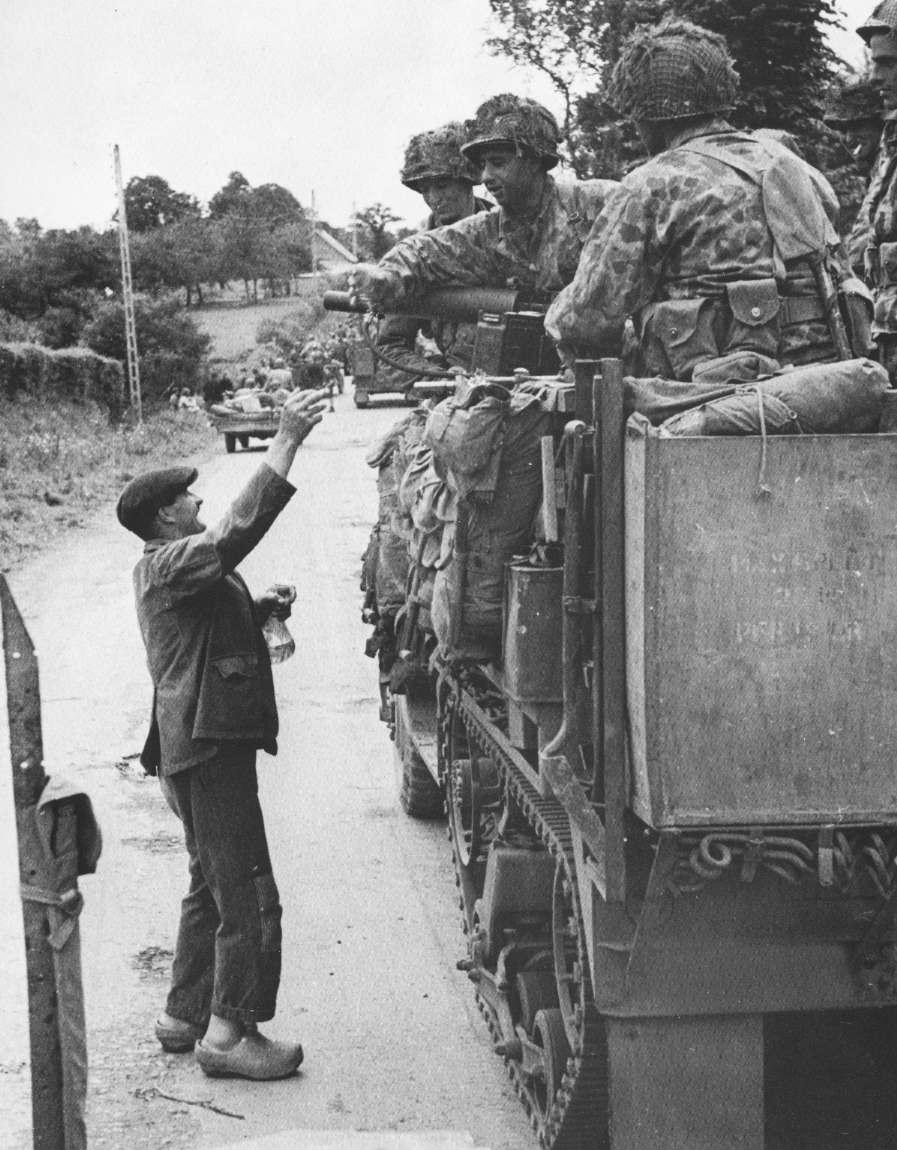
A Frenchman offering a drink
to GIs on their way to Paris
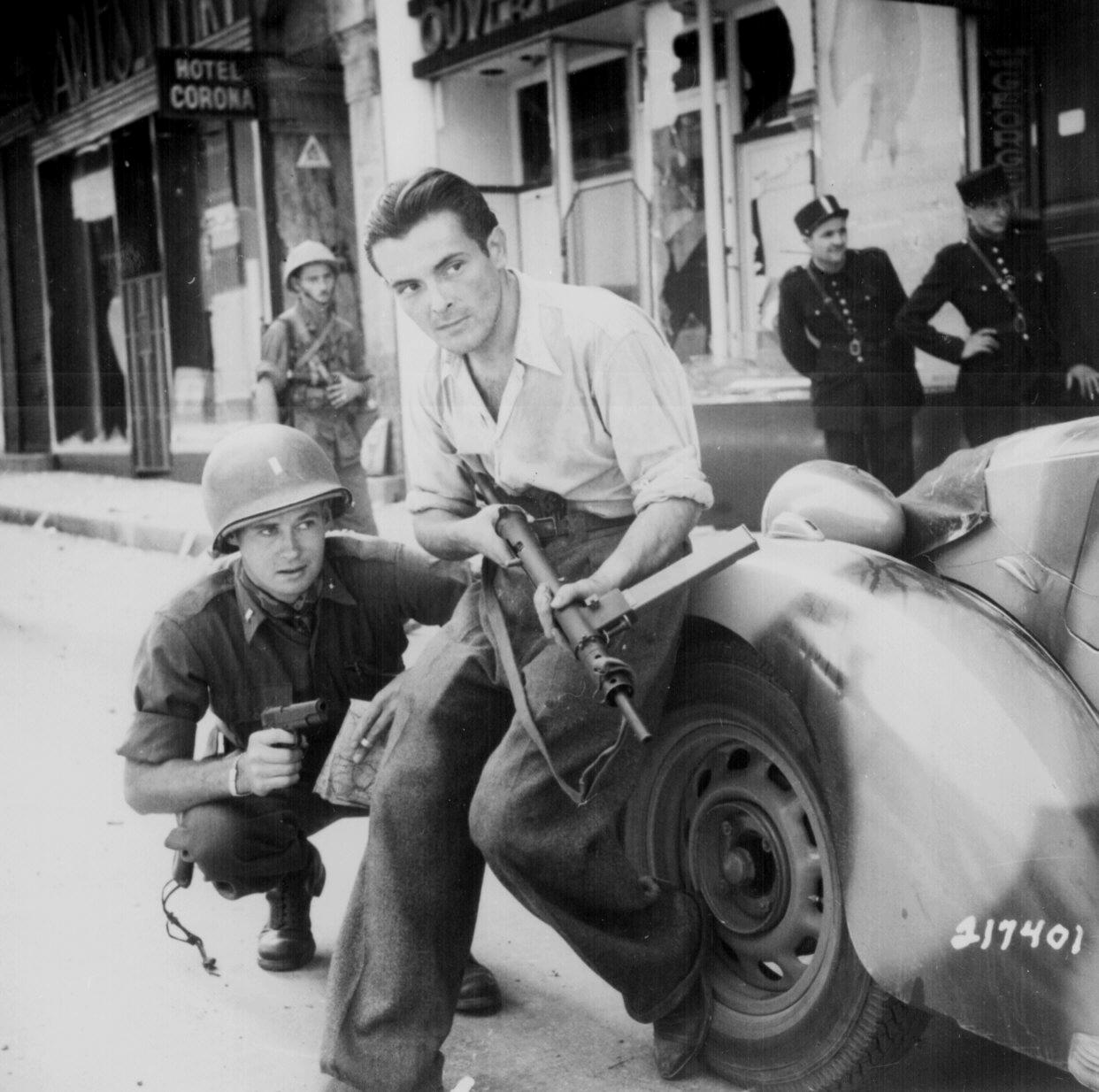
An American officer and a
French partisan crouch behind an auto during a street fight
in a French city. 1944.
National Archives
111-SC-217401
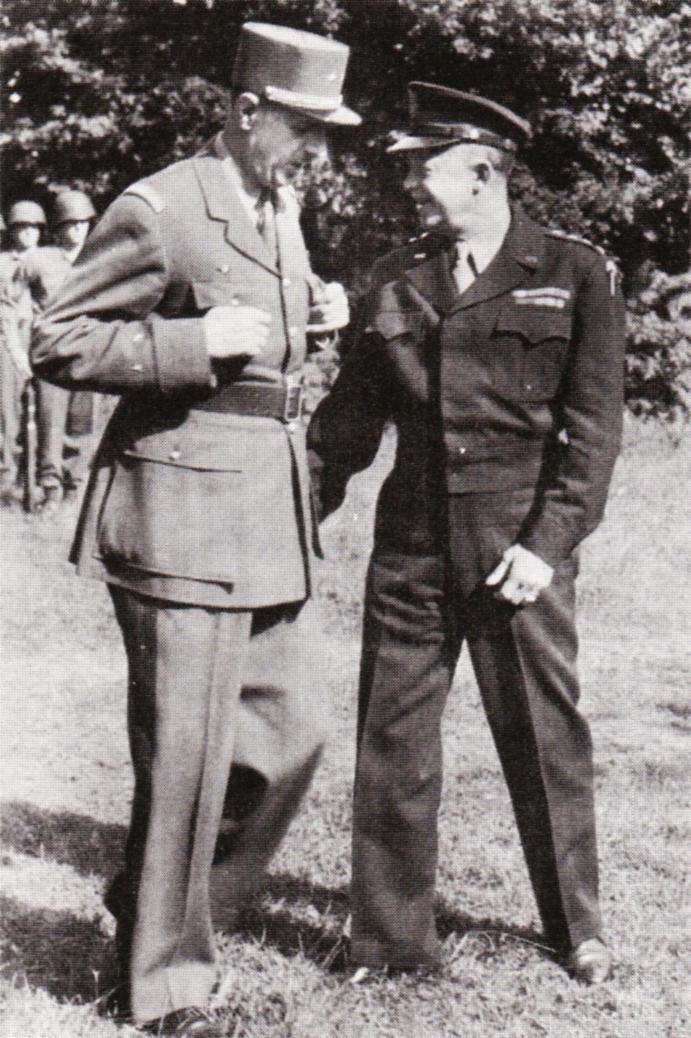
De Gaulle and Eisenhower
conferring
National Archives
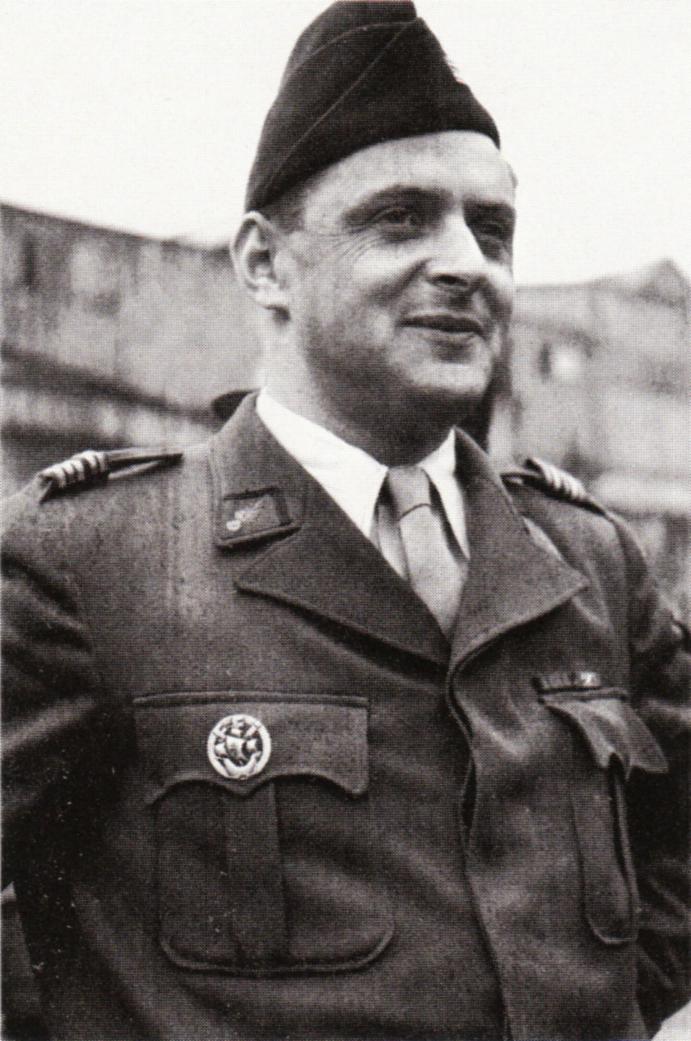
Henri Tanguy - leader of
the Communist Partisans
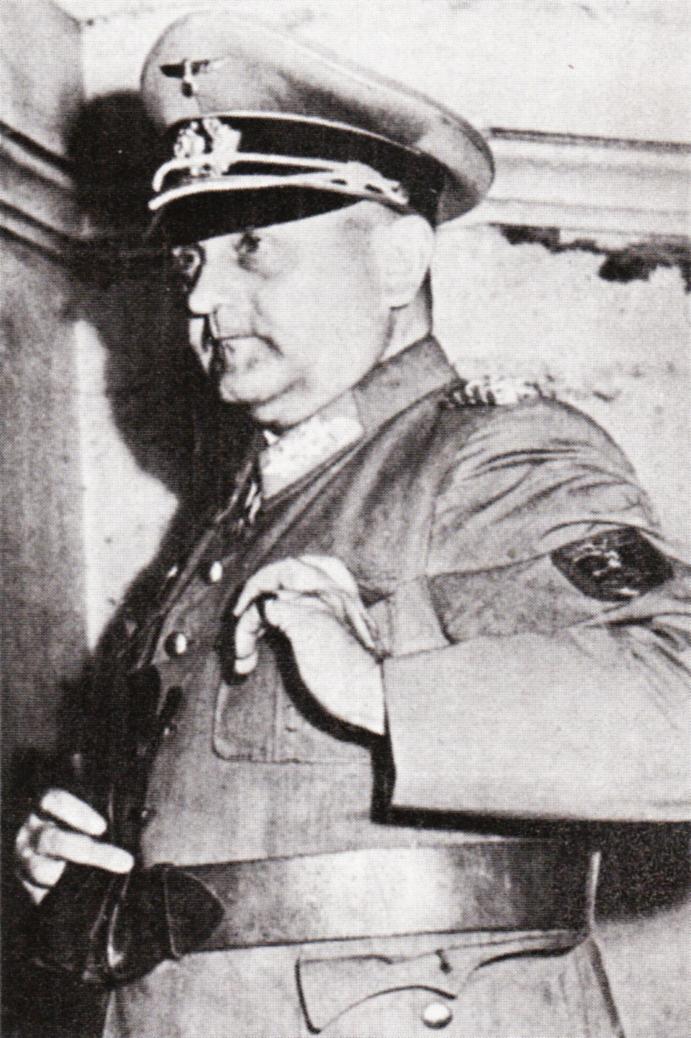
Major General Dietrich von
Choltitz, German Commander in Paris
National Archives

Free French Partisans - members
of the Resistance in Paris
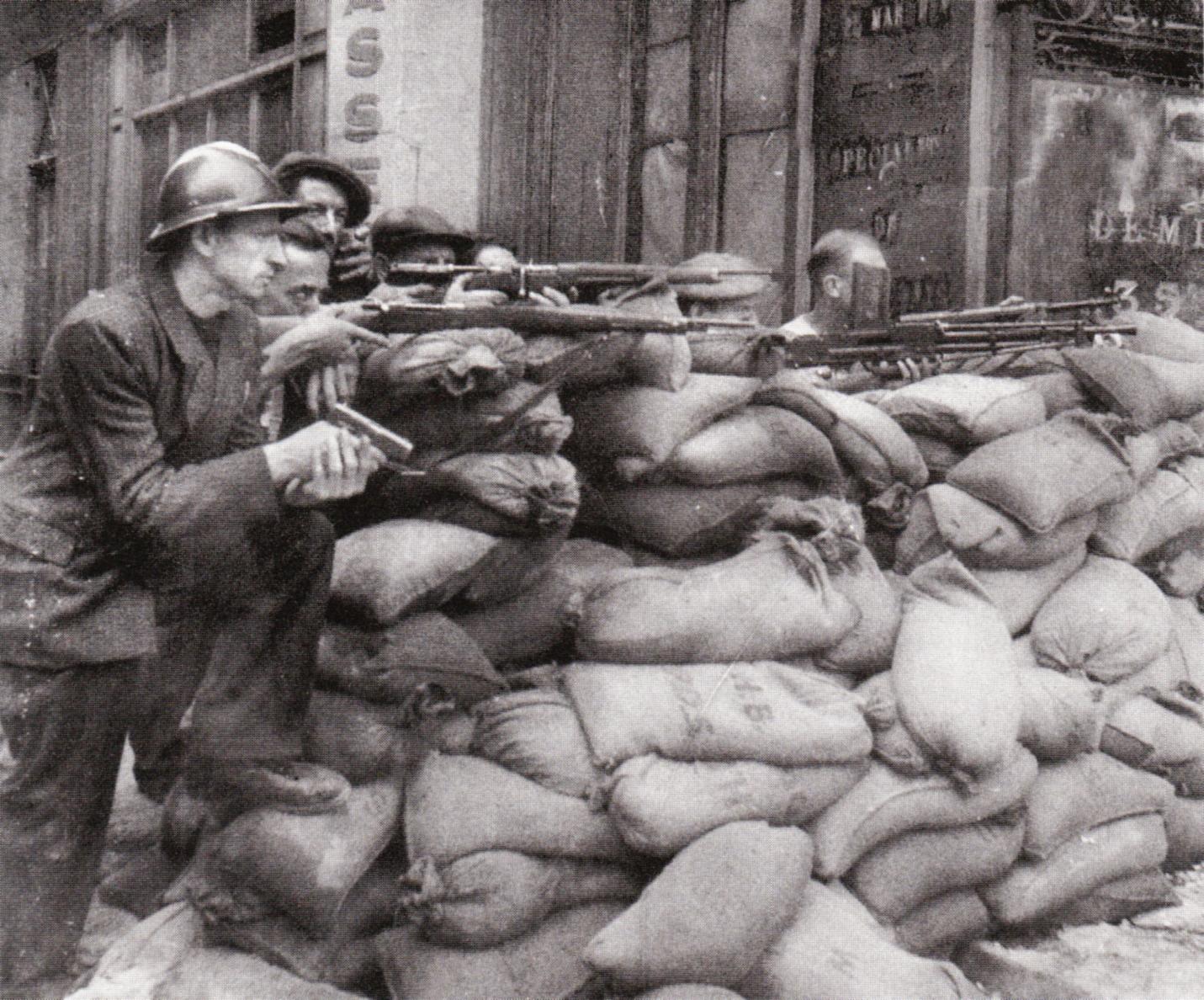
Free French Partisans taking
a stand at one of the 'barricades' in Paris
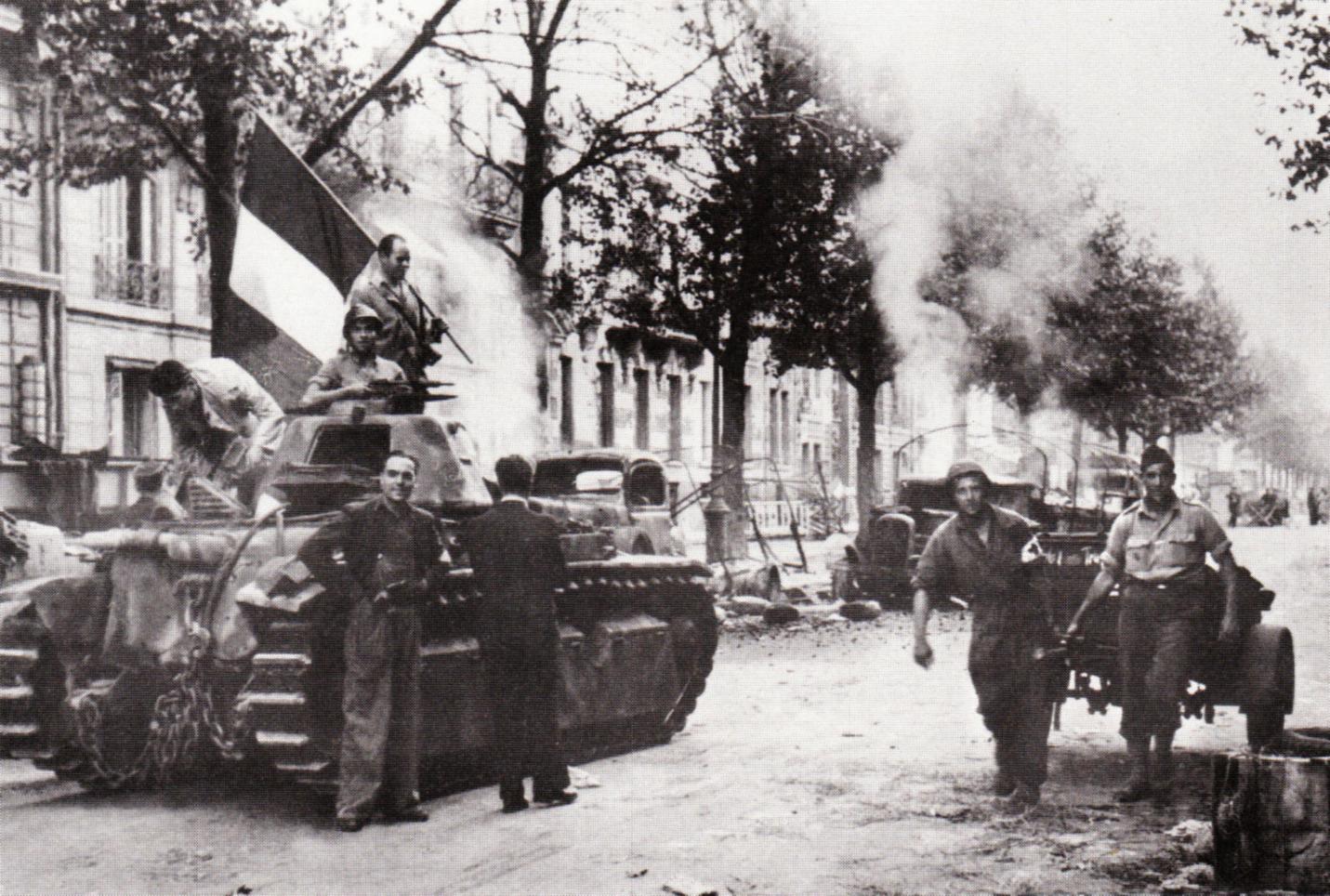
Waving the French tri-colored
flag in victory atop a captured German tank
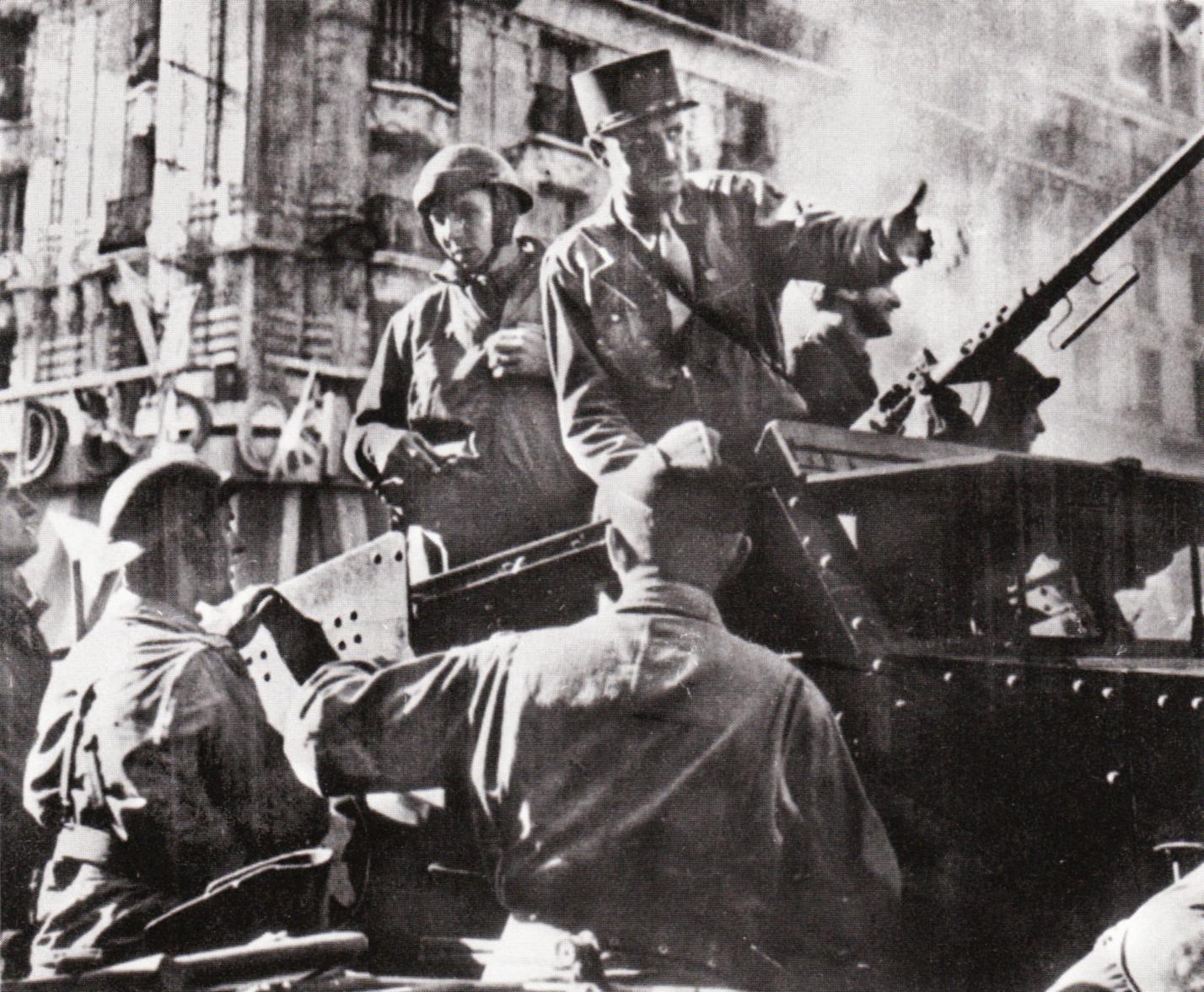
General Jacques Phillippe
Leclerc directing French action in Paris from his half-track.
National Archives
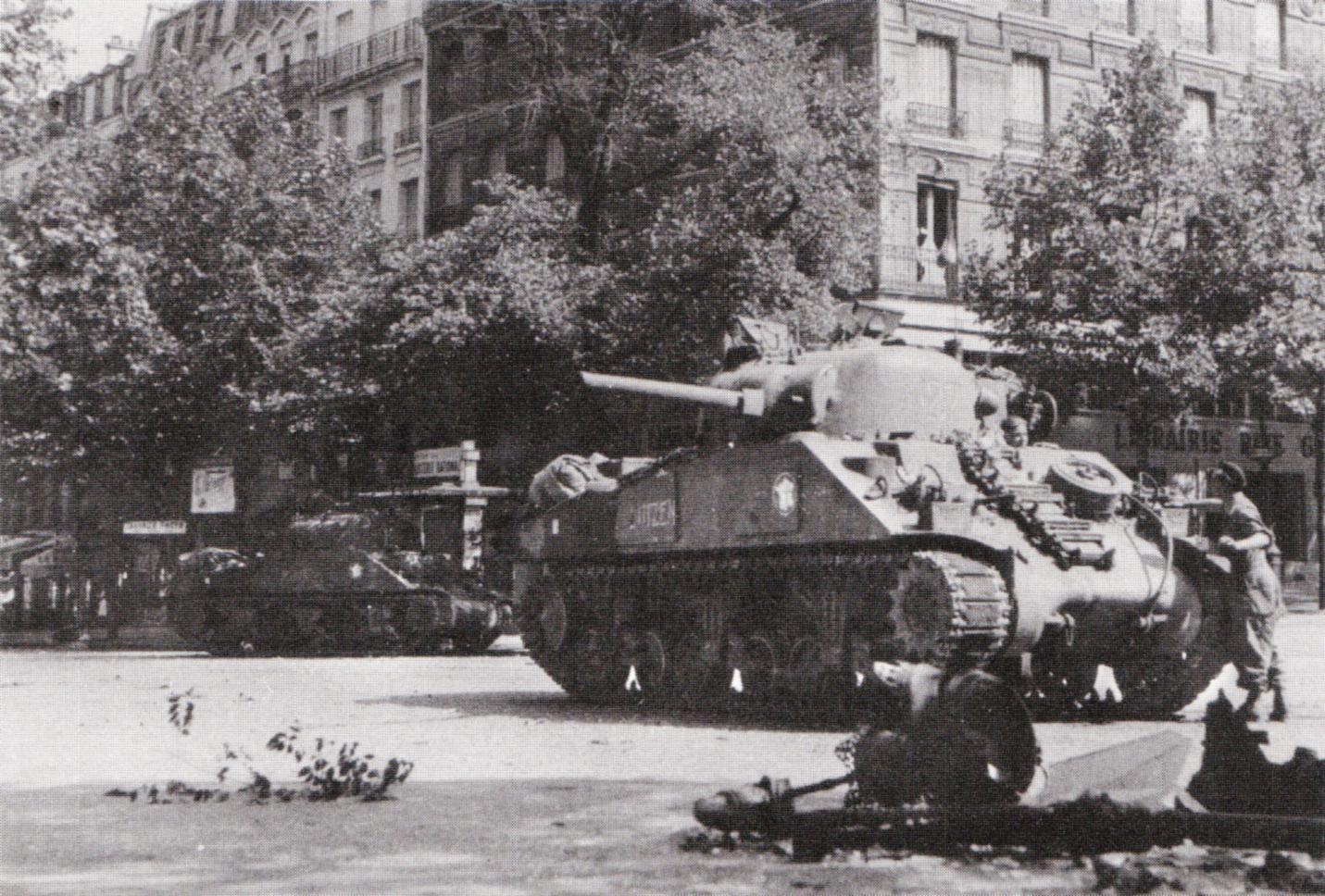
Tanks of Gen. Leclerc's 2nd
Armored Division moving down the Boulevard St. Michel (August 25)
National Archives
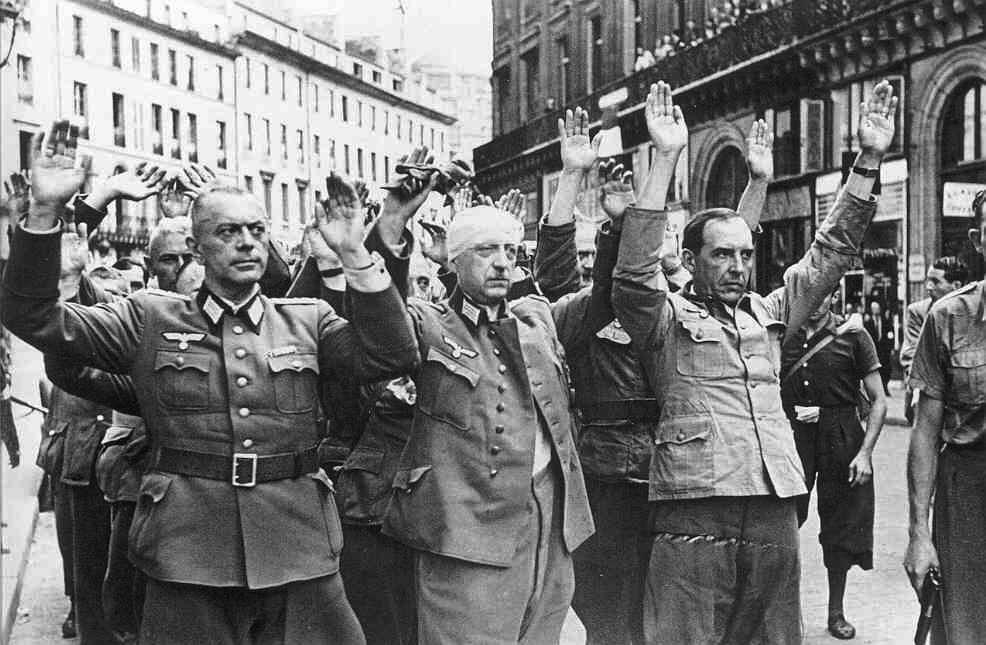
Germans surrender in Paris
- August 25, 1944
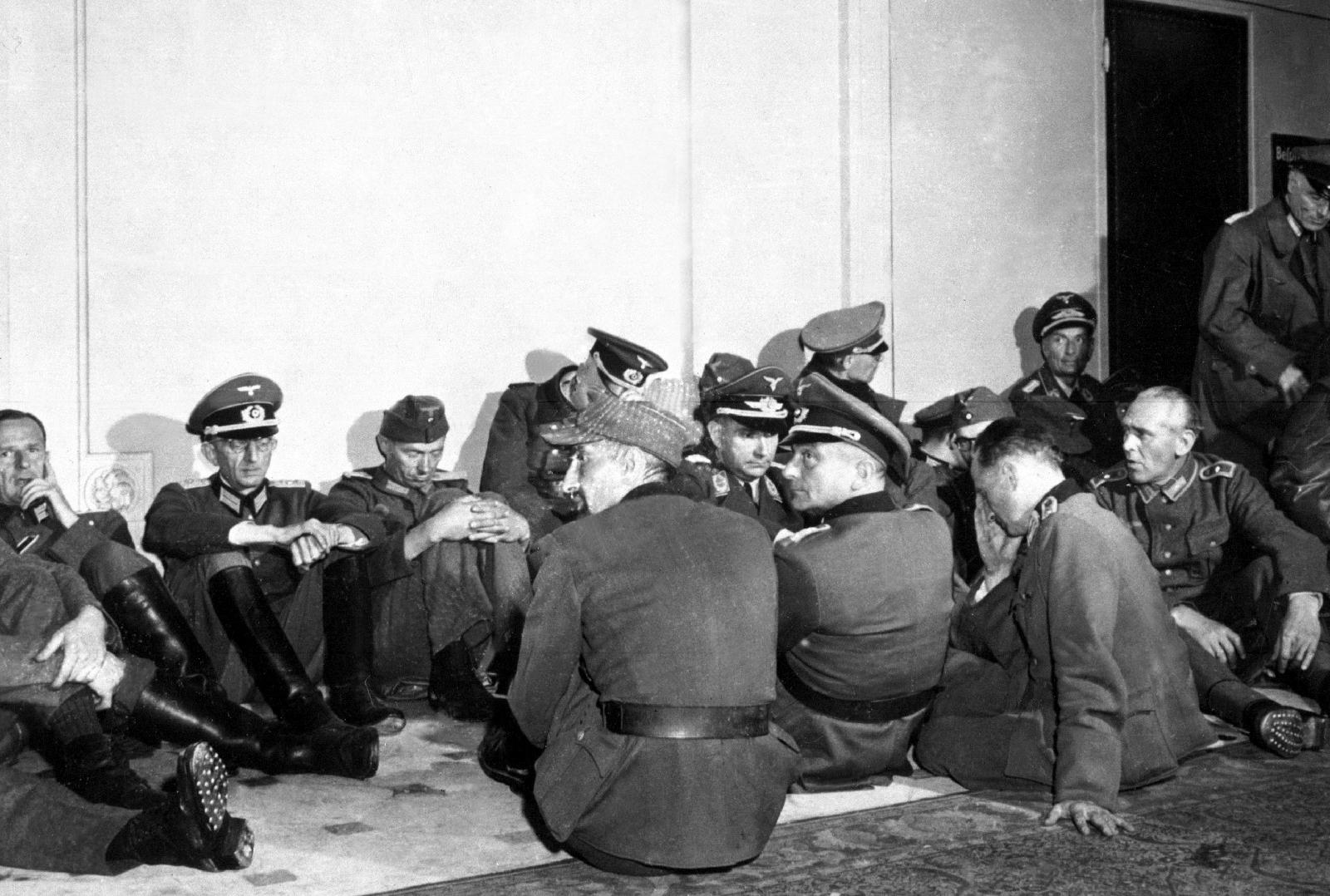
High ranking German officers
seized by Free French troops which liberated their country's headquarters for the Wehrmacht
in the days of the
Nazi occupation, Paris, France.
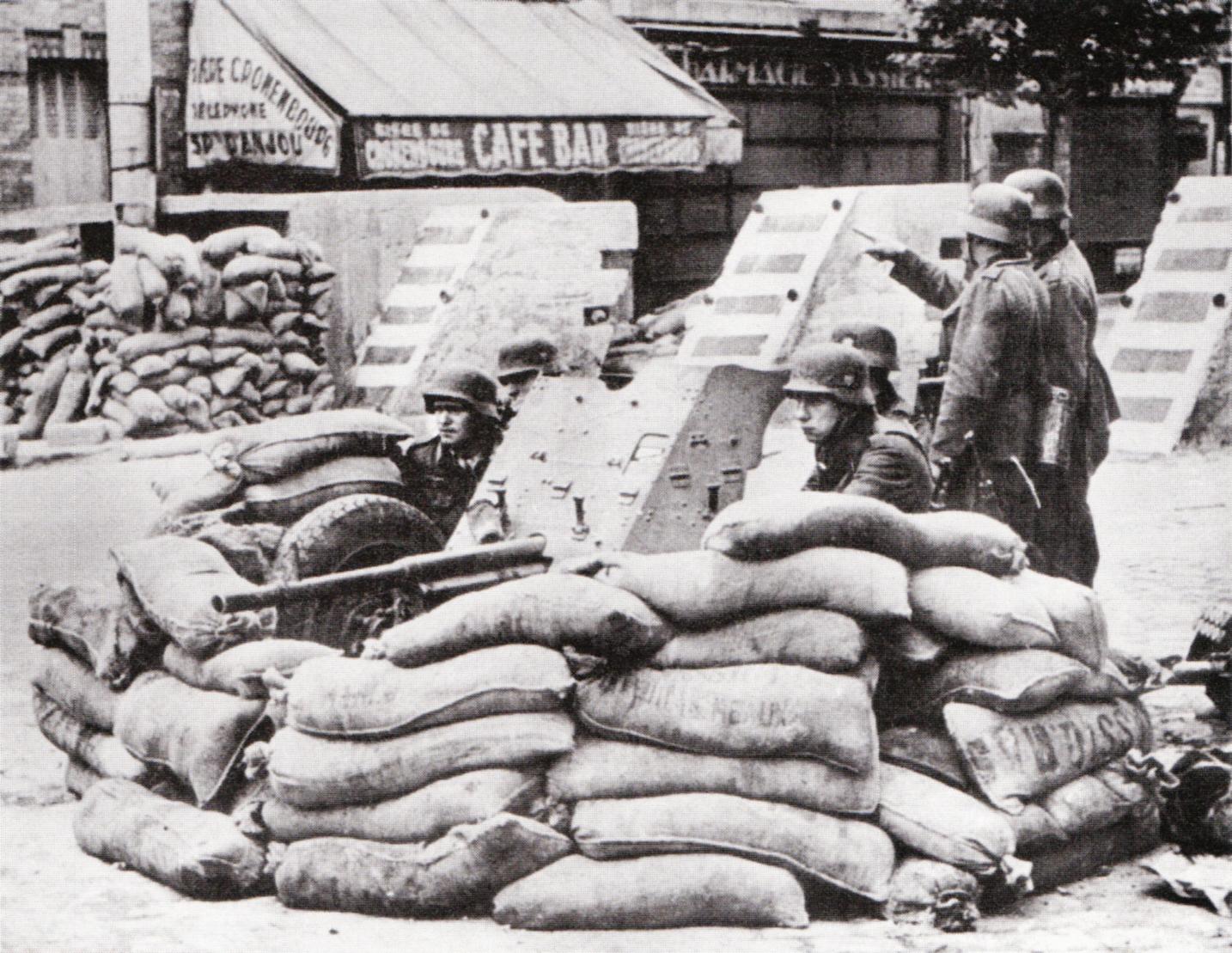
Small pockets of German resistance
would hold out here and there
in the Paris suburbs for the next week
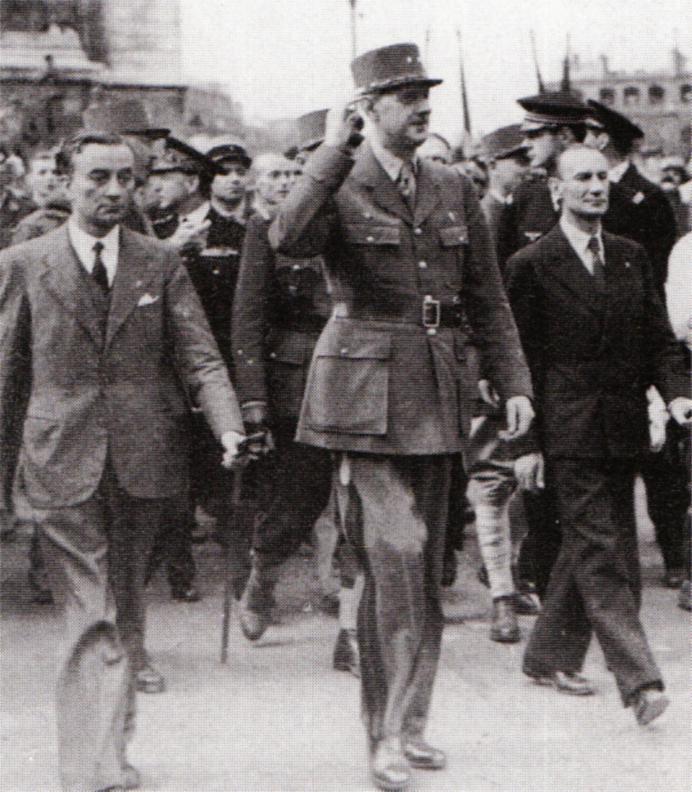 De Gaulle leading the victory
march down the Champs Elysées - March 26
De Gaulle leading the victory
march down the Champs Elysées - March 26
National Archives
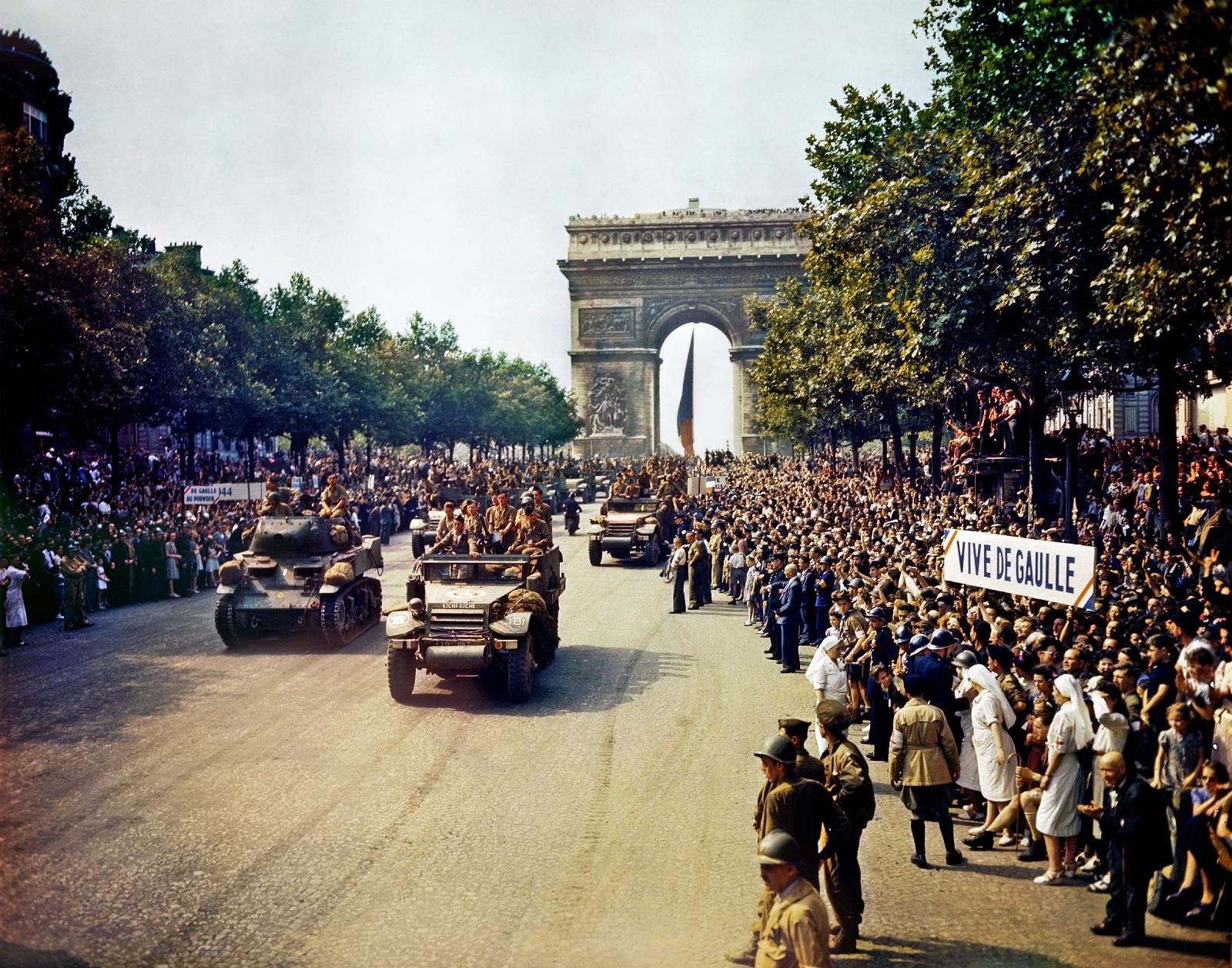
Free French tanks and half-tracks
of General Leclerc's 2nd Armored Division pass through the Arc du Triomphe, down the Champs Elysées,
after Paris was liberated. August 26, 1944
Library of Congress

American troops in tank passing the
Arc de Triomphe after the liberation of Paris, August 1944.
National Archives 208-YE-68
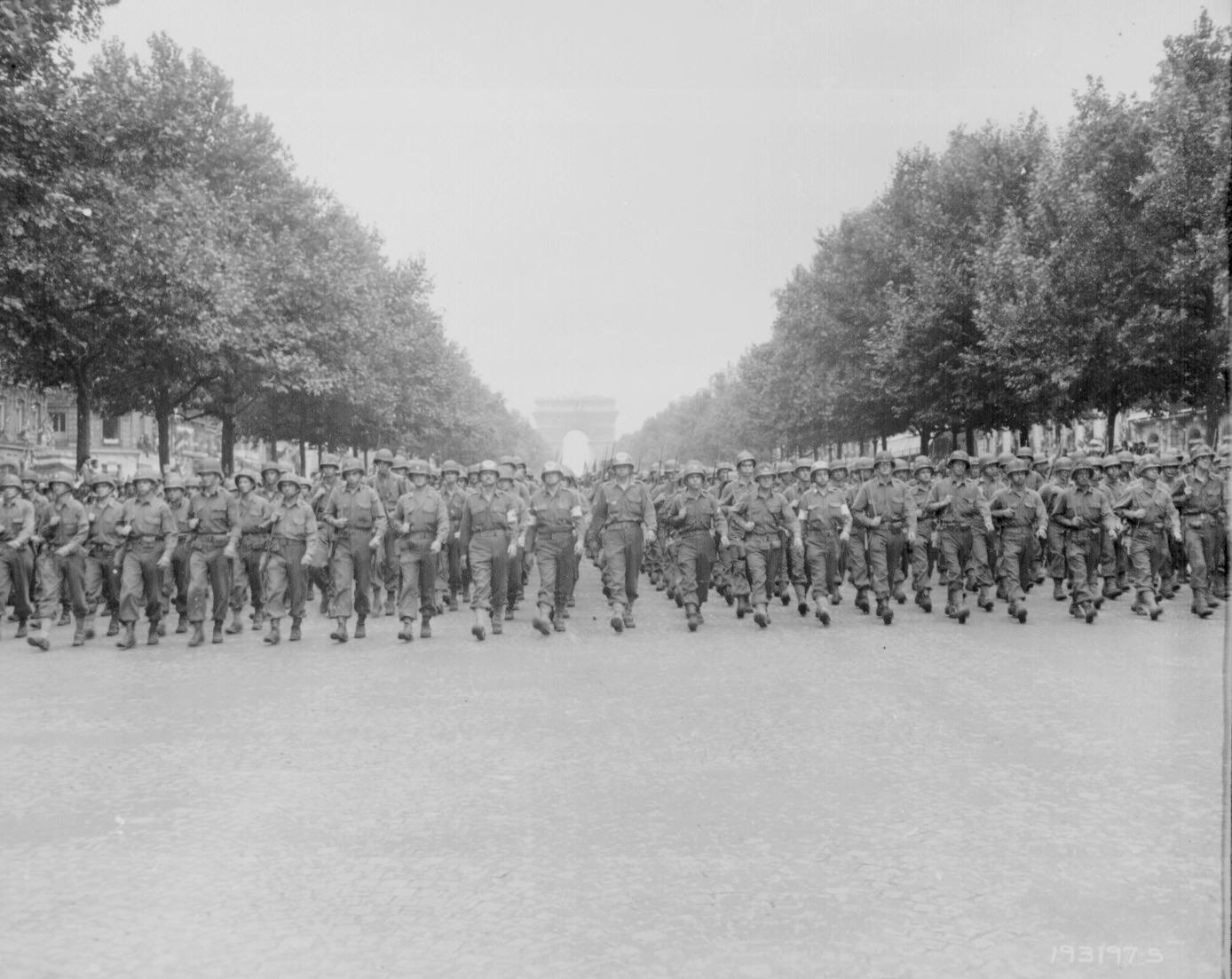
"American troops of the 28th
Infantry Division march down the Champs Elysees, Paris,
in the `Victory' Parade."
Poinsett, August 29, 1944.
National Archives
111-SC-193197
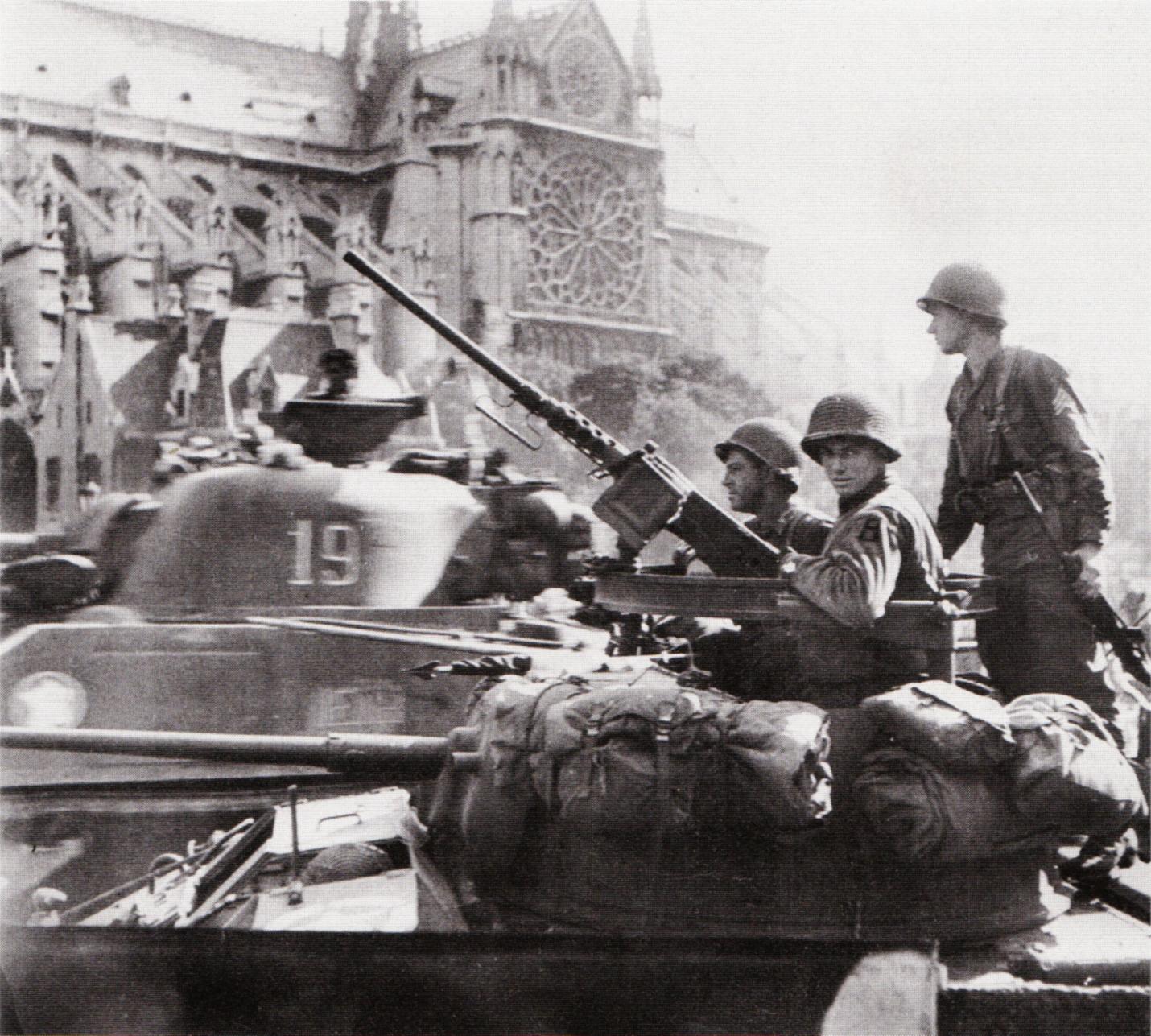
An American tank crew in
front of the Notre Dame Cathedral standing ready to defend Paris from German
holdouts
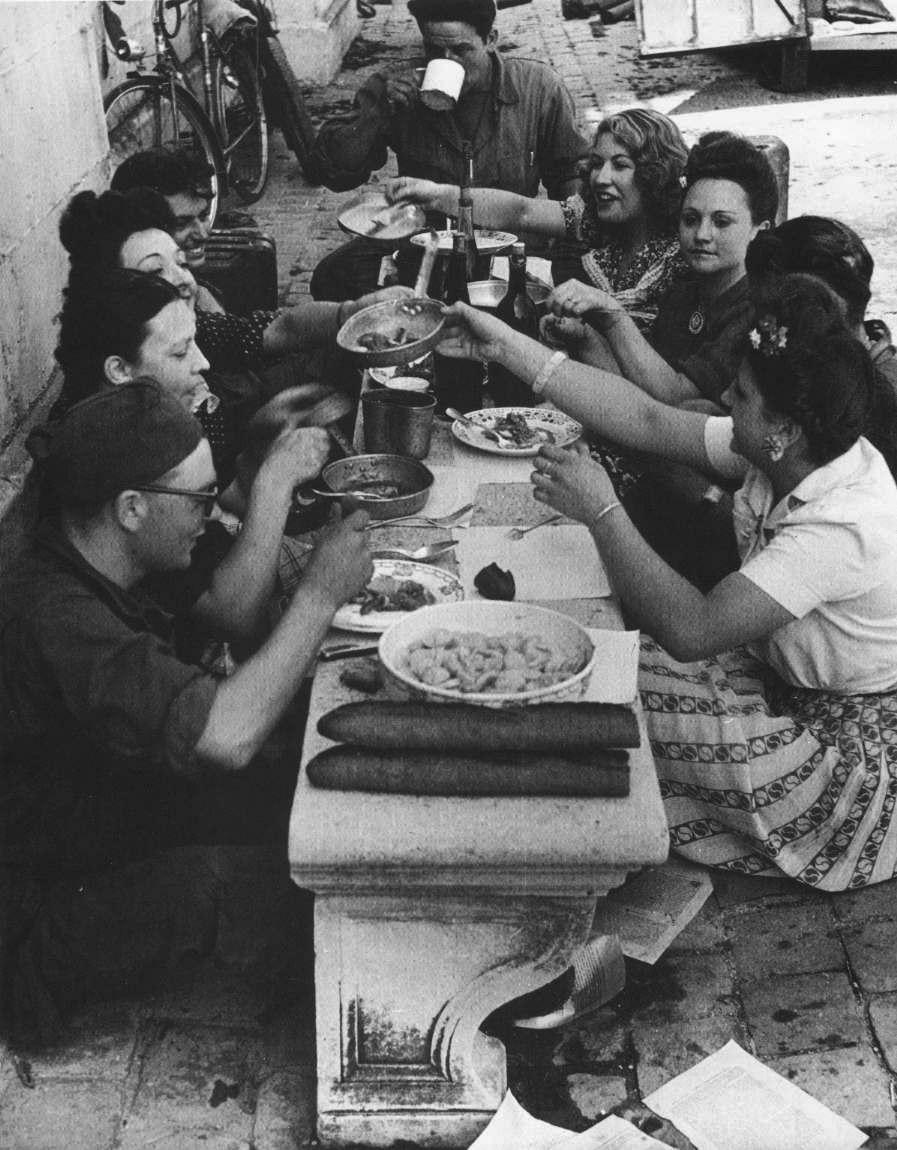
GIs sharing a streetcorner
feast with the French in Paris

"Bing Crosby, stage, screen and radio
star, sings to Allied troops at the opening of the London stage door canteen in Piccadilly, London,
England." Pearson, August 31, 1944.
National Archives
111-SC-193249
For some of the French, the
"Liberation" of their country comes as bad news
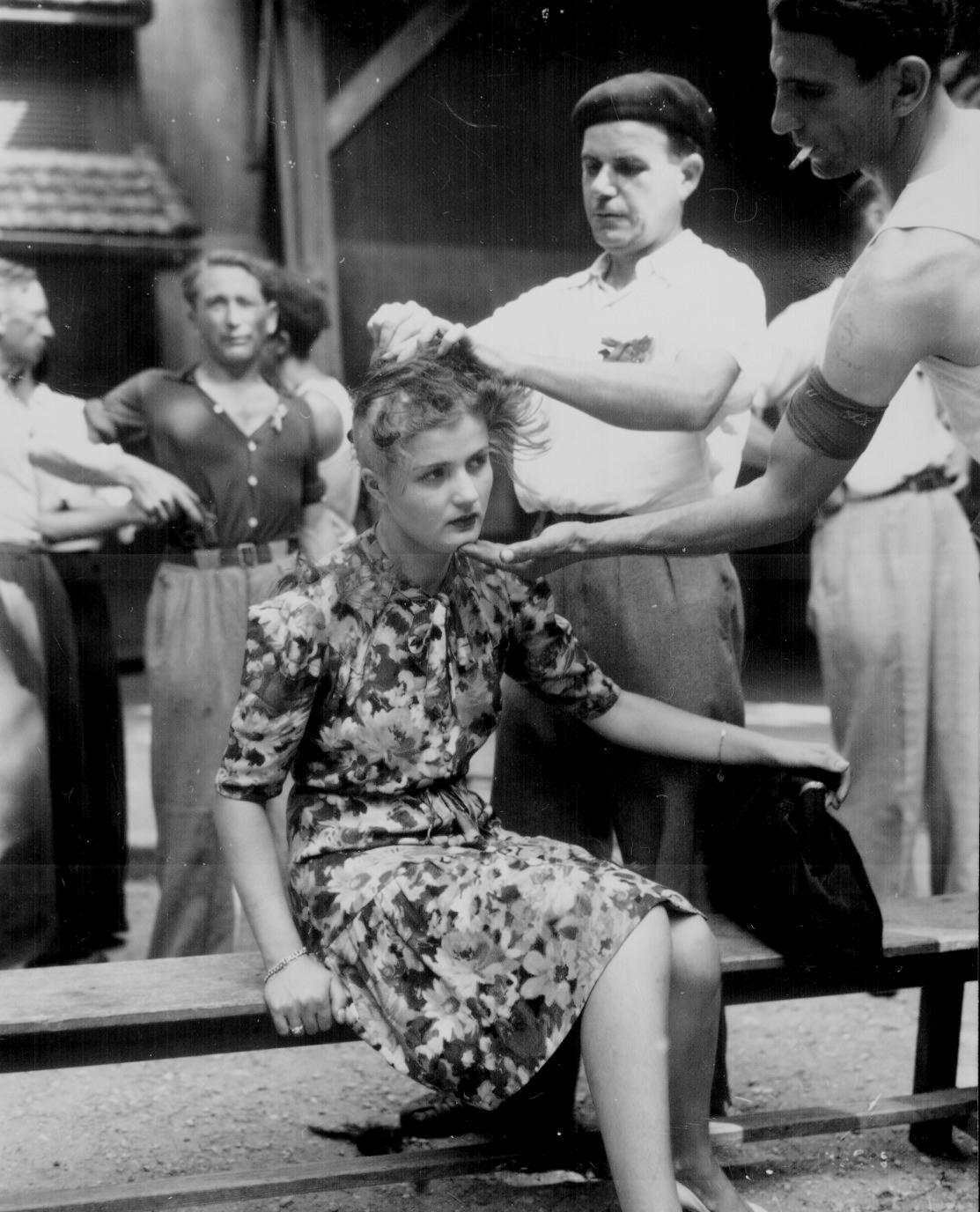
"This girl pays the penalty
for having had personal relations with the Germans. Here, in the Montelimar
area, France, French civilians shave her head as punishment." August 29,
1944.
National Archives
111-SC-193785

"Photo taken at the instant bullets
from a French firing squad hit a Frenchman who collaborated with the Germans. This execution
took place in Rennes, France." Himes, November 21, 1944.
National Archives
111-SC-196741
THE GERMAN V-1 AND V-2 MISSILES |
The
Germans pushed hard for the development of long-range jet-propelled
missiles, promised as "revenge" (Vergeltung) for the Allied bombing of
German cities ... even though the work in developing such German
missiles had begun well before the Allied bombings of Germany (which
itself was undertaken as reprisal for Germany's bombing or Blitz of
England). Thus the Vergetlungswaffe was developed ... appearing
in two increasingly sophisticated forms: The Vergeltungswaffe 1
(V-1) and Vergetlungswaffe 2 (V-2).
The V-1 was initially launched from the Atlantic coastline of
German-occupied France, the operation beginning in June, 1944, soon
after the Allies landed at nearby Normandy. The V-1 missiles were
aimed principally at London, timed to come crashing down on the British
exactly when the V-1 ran out of its precisely calculated fuel. It
was loud ... but even more unnerving when the missile's engine stopped
... because those below knew that a huge bomb was coming its way.
But the British developed anti-aircraft fire capable of bringing down
many of nearly 10,000 V-1s headed their way (roughly three out of every
four missiles were knocked out). Nonetheless, the 2,500 V-1s that
did hit, terrorized the London population so profoundly that 1.5
million Londoners fled the city ... seeing their capital experiencing
the horror of a "Second Blitz."
they
did considerable damage not only to London, but also the port of
Antwerp, their primary target (the Allied needed a large port to bring
in supplies for their troops), Liege, and other European cities
However, against the V-2, launched several months later (September) from
German sites in the Netherlands, the British had no defense. Flying
three times the speed of sound, and dropping noiselessly from the
heights, V-2s were aimed at London (over 1,300 V-2s) ... but also
at Antwerp (some 1,600 V-2s) – the Allies' principal supply port.
But Liege and other European cities received V-2 attacks. The
attacks ceased only in late March of 1945 when Germany found itself
nearly completely overrun.
The V-2s
certainly terrorized Germany's Western enemies. But ultimately,
considering the expense involved (they alone consumed a third of
Germany's fuel capacity), strategically they were of no serious help to
a collapsing Germany.
But they did however, give the victors (American, British and Russian)
a huge pool of German scientists to draw from in developing their own
post-war missile systems ... weapons of mass destruction (WMDs) that became
centerpieces (along with atomic explosives) in the Cold War that was
soon to develop. |
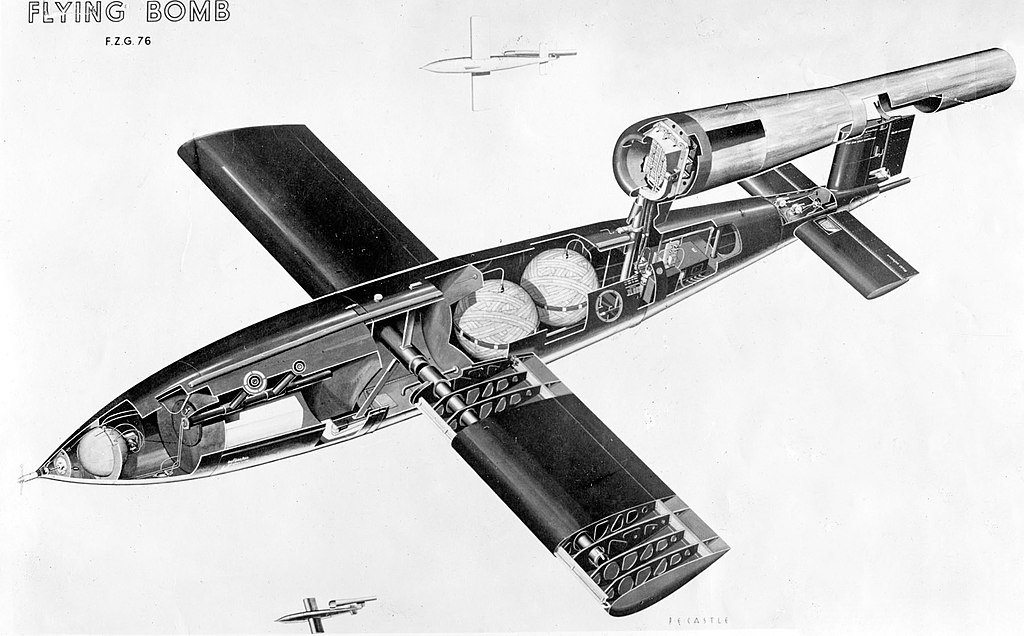
The V-1
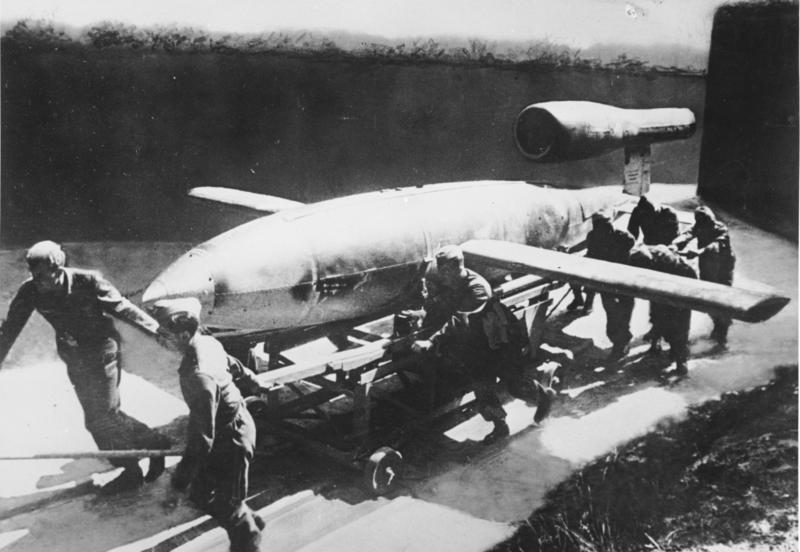 The V-1 being launched
The V-1 being launched
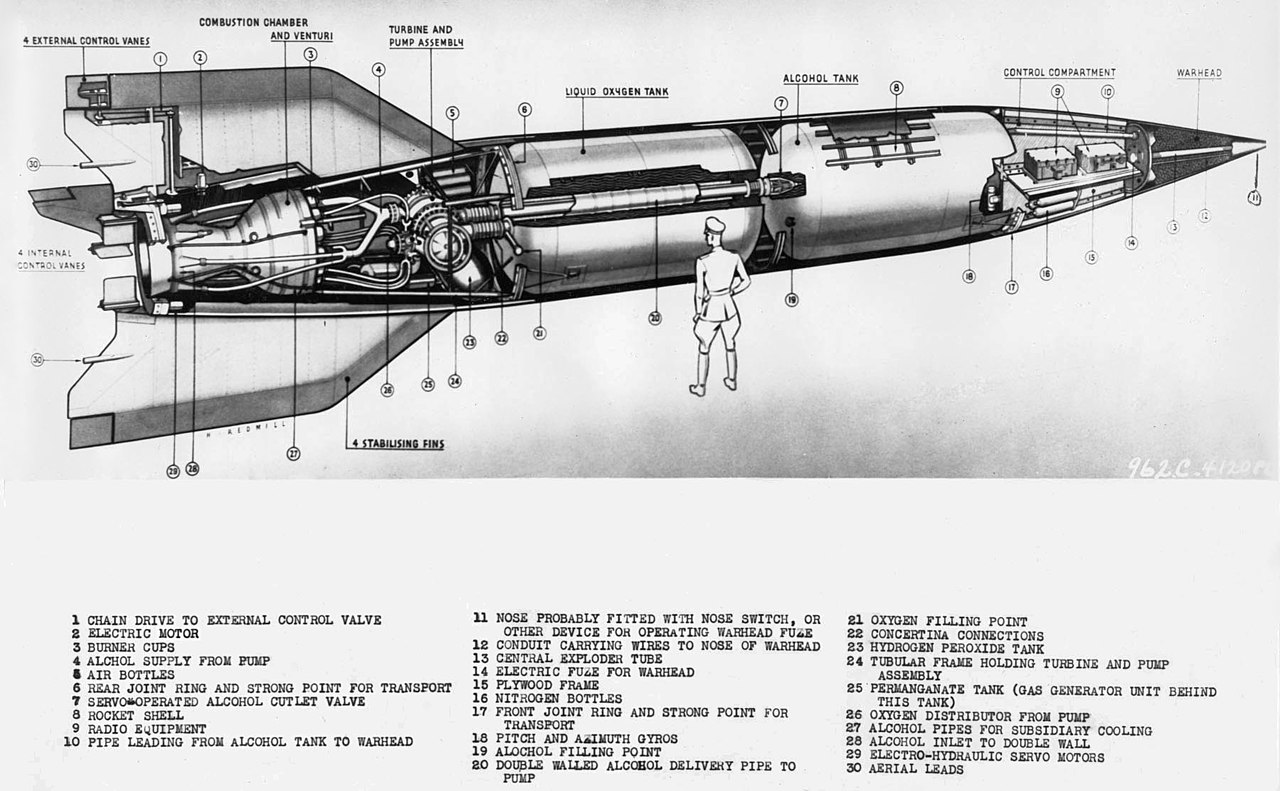 The V-2
The V-2
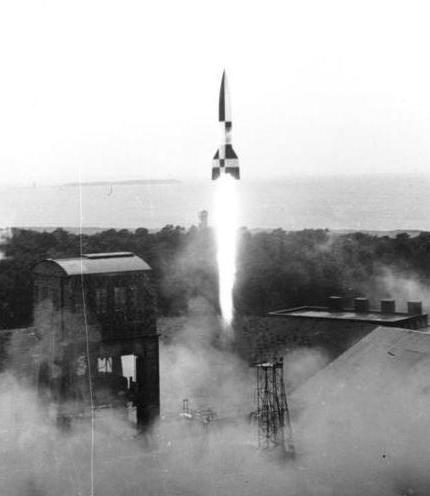 The V-2 being launched
The V-2 being launched
THE
ALLIES HEAD ACROSS FRANCE THEN SWING TO THE NORTH INTO BELGIUM AND HOLLAND – HOPING TO CROSS THE RHINE RIVER THERE AND BREAK INTO GERMANY ("OPERATION MARKET GARDEN") |
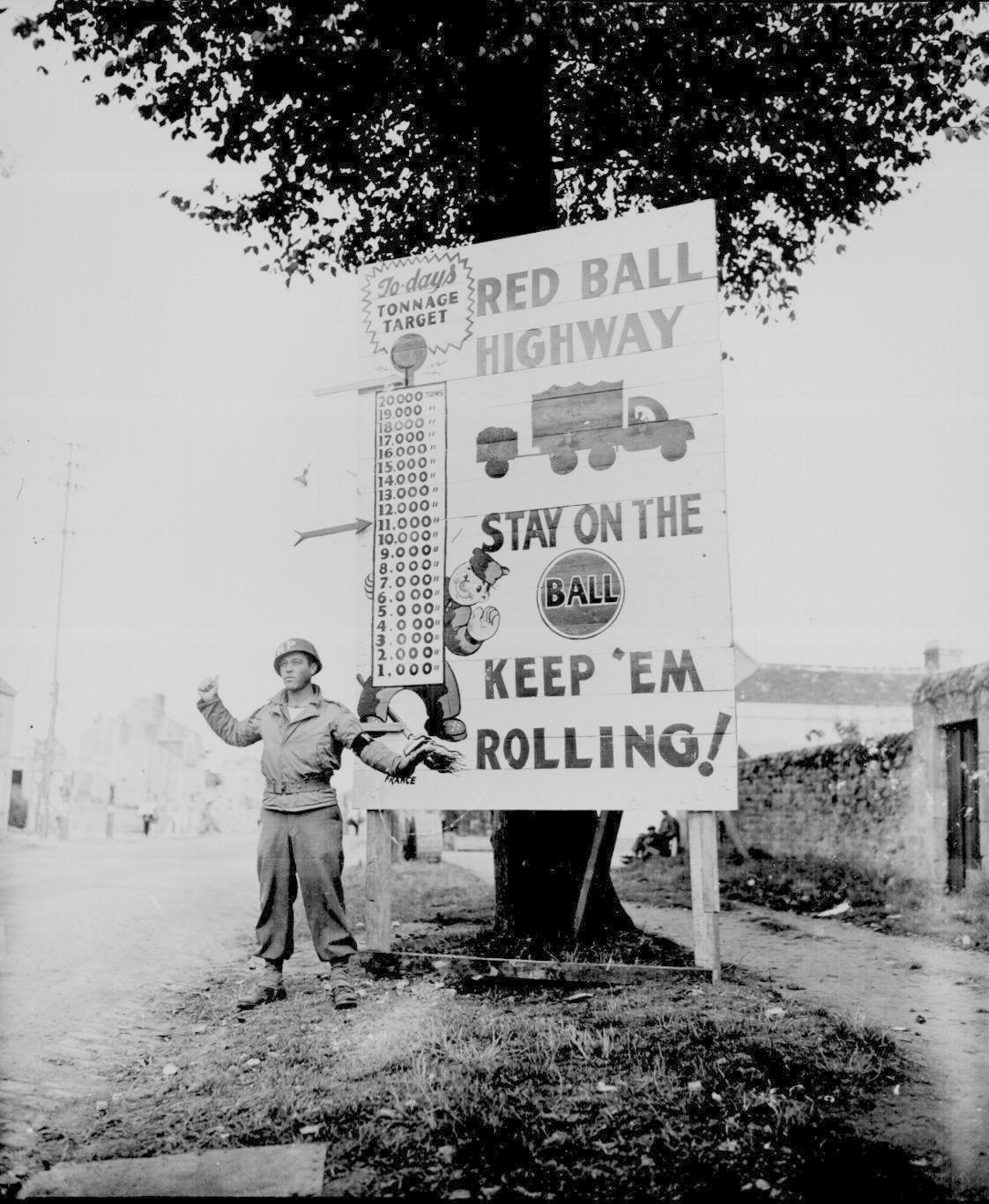
"Corporal Charles H. Johnson of the
783rd Military Police Battalion, waves on a 'Red Ball Express' motor convoy rushing priority
materiel to the forward areas, near Alenon, France." Bowen, September 5, 1944.
National Archives
111-SC-195512.
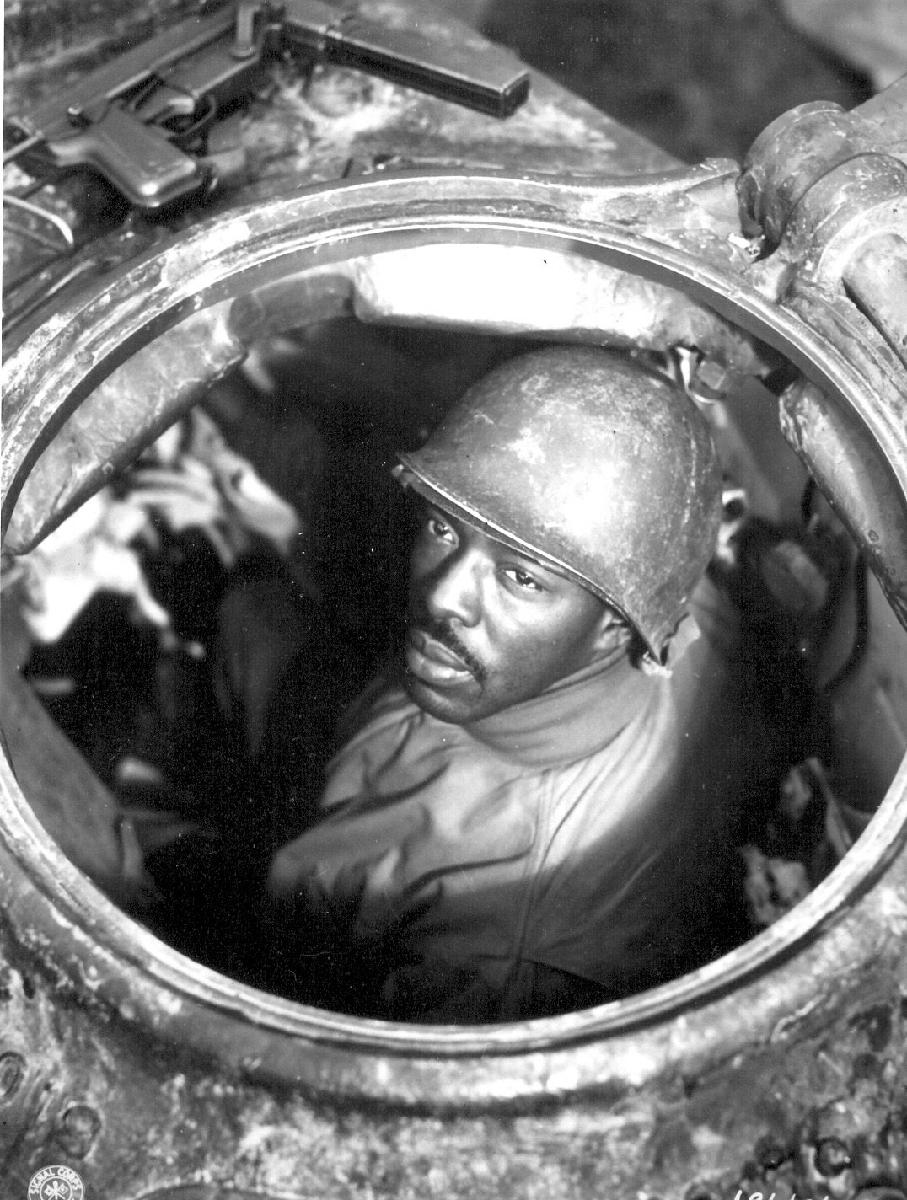
"Cpl. Carlton Chapman...is a machine-gunner
in an M-4 tank, attached to a Motor Transport unit near Nancy, France."
761st Mt. Bn. November 5, 1944. Ryan.
National Archives
111-SC-196106-S
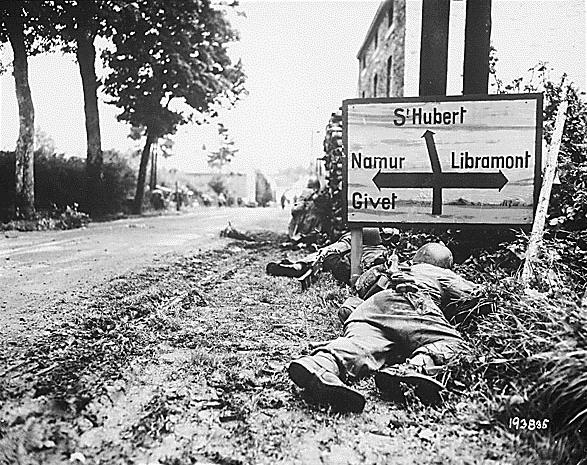
"Men of the 8th Infantry Regiment attempt
to move forward and are pinned down by German small arms from within the Belgian
town of Libin. Men seek cover behind hedges and signs to return the
fire." Gedicks, September 7, 1944.
National Archives
111-SC-193835
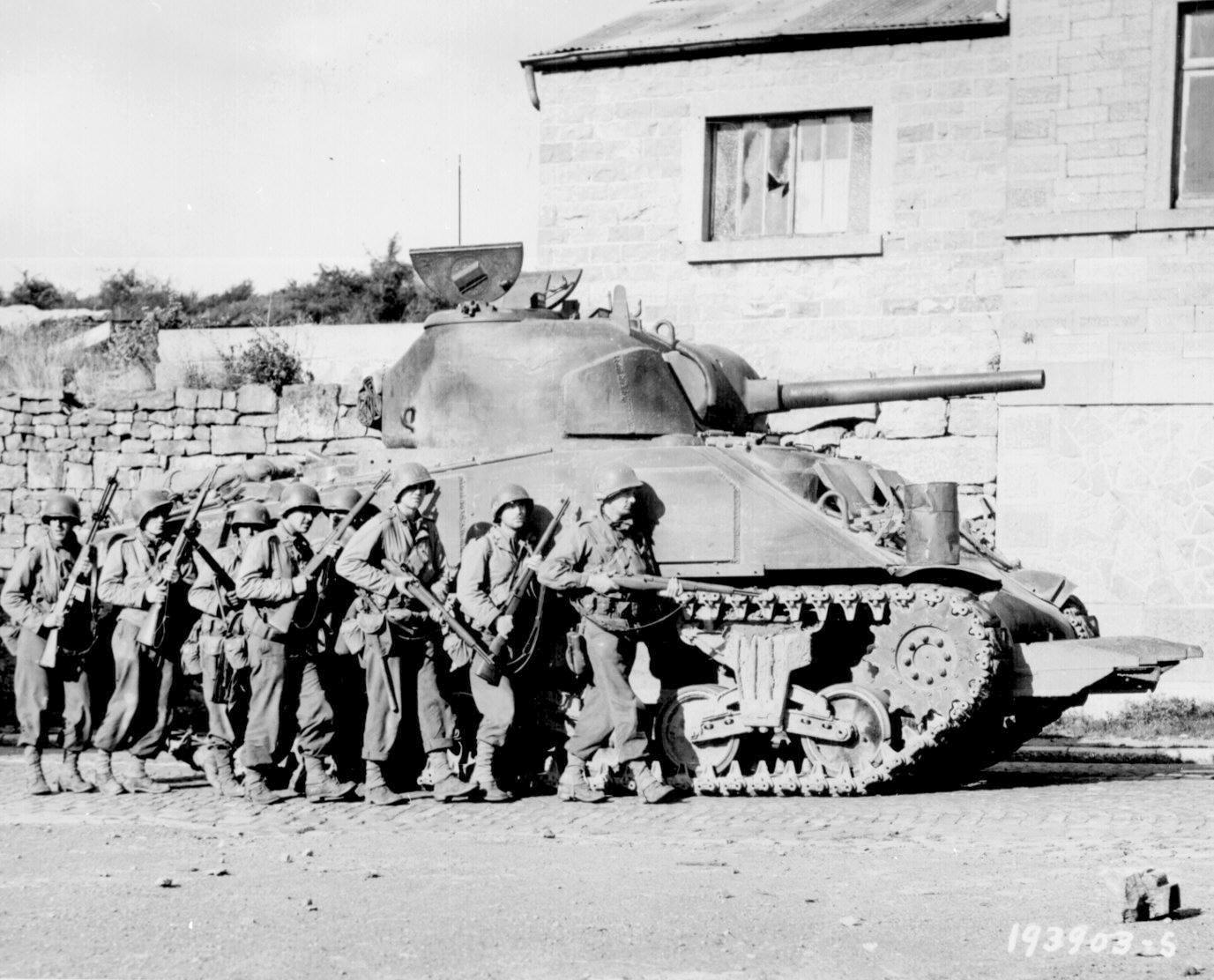
Yanks of 60th Infantry Regiment
advance into a Belgian town under the protection of a heavy tank. September 9, 1944.
National Archives
111-SC-193903
Operation Market Garden
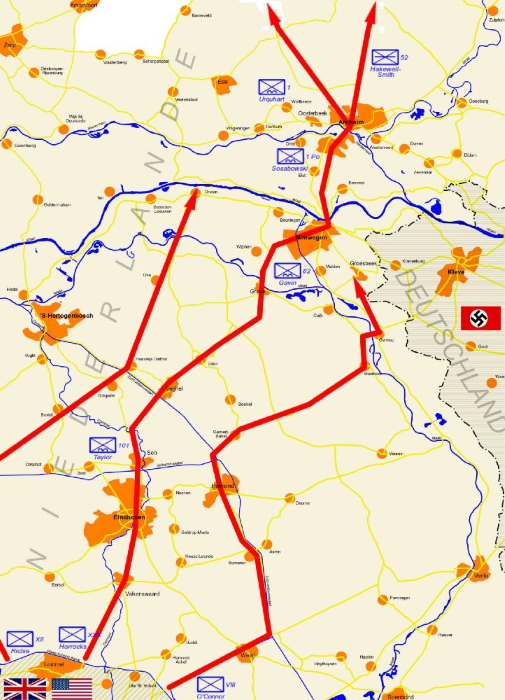
The original plan for Operation
Market Garden - September 17-25 1944
W.wolny
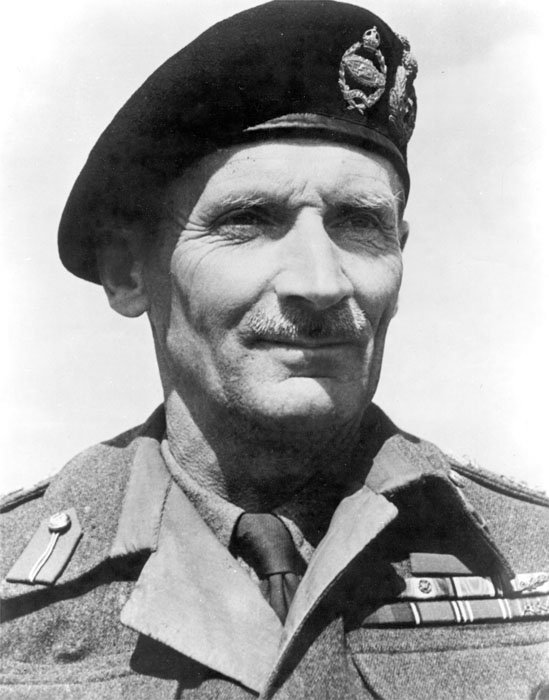 British General Bernard Law
Montgomery
British General Bernard Law
Montgomery
Maxwell Air Force Base
|
British General Montgomery, who commanded the northern flank of the Allied Army, was given the lead1 in
implementing a concentrated assault on the German defenses in the north
of Holland – the purpose being to gain a crossing of the Rhine River in
the more lightly defended Netherlands. Montgomery’s claim was that this
would allow the Allies to swing around from the North, encircle the
heart of industrial Germany and gain quick access to Berlin ... possibly bringing the war to an end before Christmas.
The idea was for the Allies to conduct their
own Blitzkrieg by dropping paratroopers at vital bridges along the path
of advance, catching the Germans by surprise ... and quickly moving up
more soldiers and heavy equipment to secure the bridges and then
beginning the rush toward a Germany caught in full retreat. But a vital
bridge at Son was blown up by the Germans before it could be seized on
the very first day of the offensive, slowing the Allied advance, and in
general the troops moved up to take full control of the bridges much
more slowly than planned. Too much partying in the crowded streets by
the Dutch, who wanted to celebrate their liberation with the Allied
troops trying to move north, slowed that movement down considerably.
Progress was so slow that again the element of surprise was lost and
the Germans were able to hold their ground, quickly moving in tanks to
hold back the Allies. Also bad weather made Allied air cover and air
resupply of overextended supply lines impossible.
The Allied offensive stalled at Nijmegen and
the paratroopers dropped further ahead at Arnhem now found themselves
trapped behind German lines. In the end the plan was clearly not
working ... and an effort now had to be made to rescue Allied
paratroopers trapped behind German lines. Of the 10,000 troops that had
been dropped at Arnhem, only a fifth of that number were rescued, the
rest either killed or captured by the Germans.
All in all, the plan failed miserably. Blame
was passed around liberally. But the fact remained, the Rhine was not
crossed ... until the following March.
1This
would infuriate American general Patton, whose tank corps was making
good headway against the Germans as it advanced toward Germany itself.
For this meant not only diverting important supplies (especially fuel
for his tanks) to his nemesis Montgomery but also the loss to Patton of
the glory that both men sought on the battlefield!
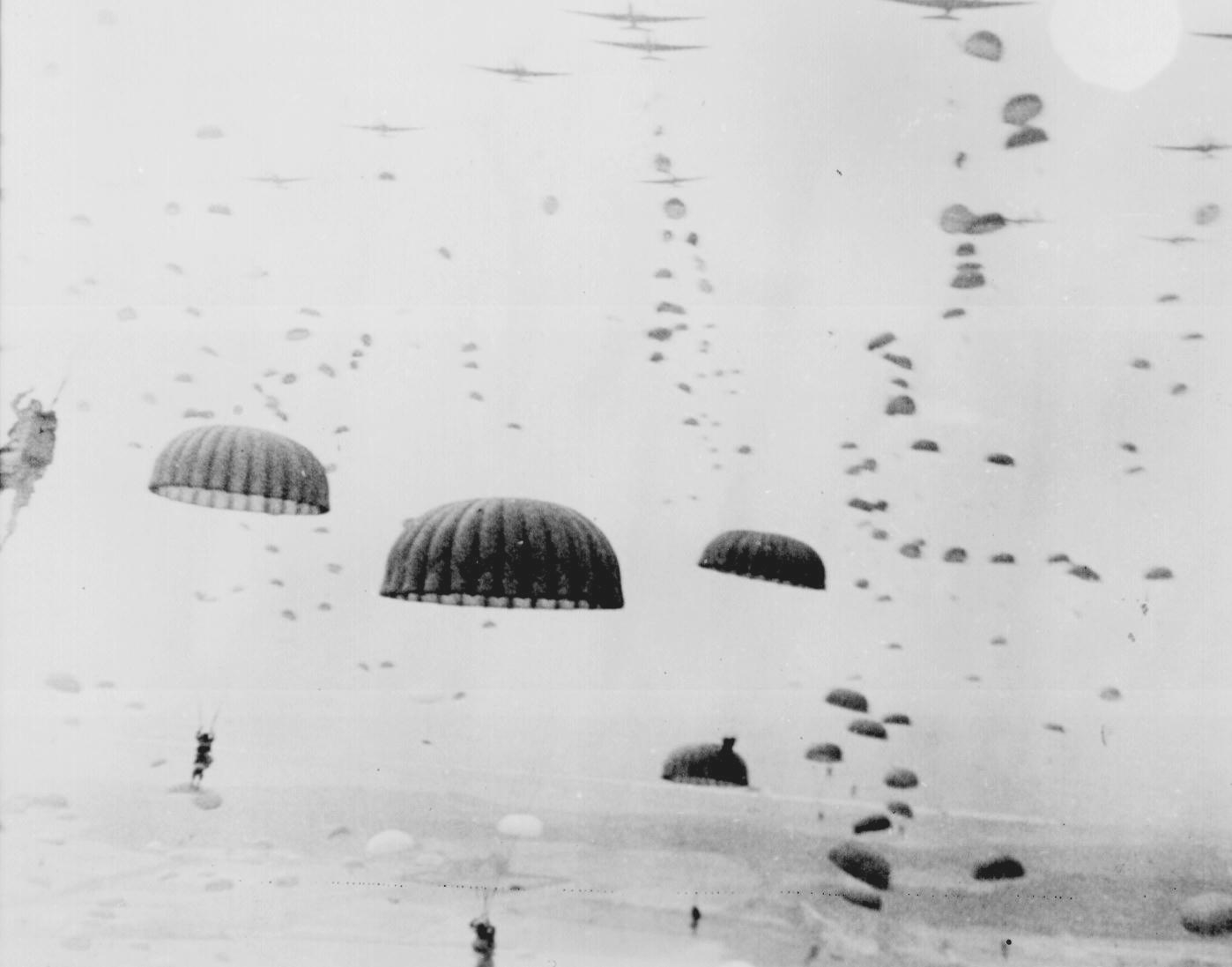
Parachutes open overhead
as waves of paratroops land in Holland during operations by the 1st Allied Airborne
Army. September 1944.
National Archives
111-SC-354702
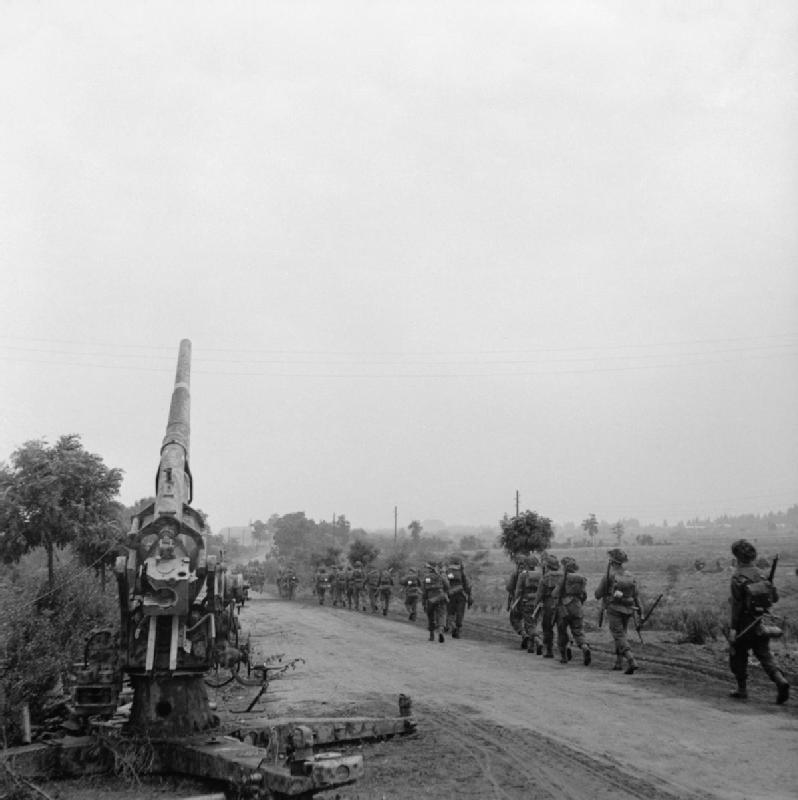
Infantry of 50th (Northumbrian)
Division moving up past a knocked-out German 88mm gun near 'Joe's Bridge' over
the Meuse-Escaut Canal in Belgium -16 September 1944
Imperial War Museum
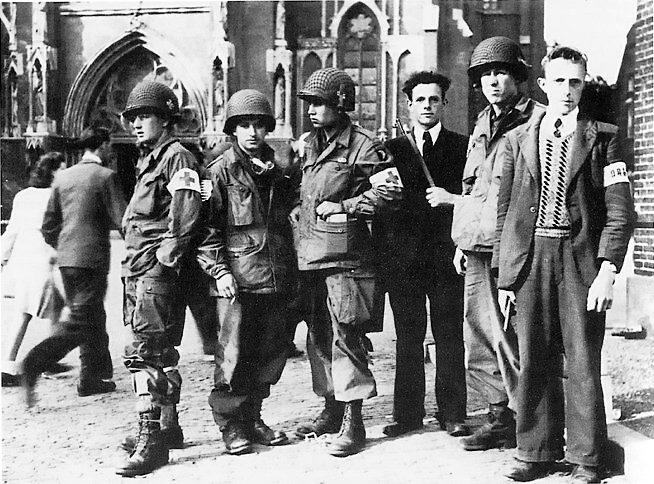 The 101st Airborne with members
of the Dutch Resistance in front of the Eindhoven cathedral.
The 101st Airborne with members
of the Dutch Resistance in front of the Eindhoven cathedral.
CIA
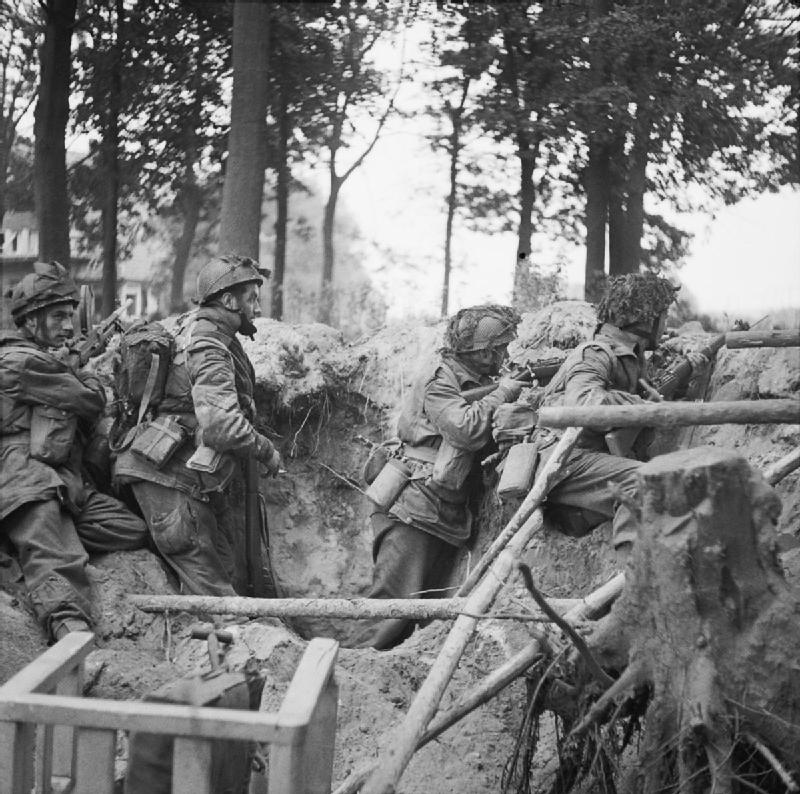
Four men of the 1st Paratroop
Battalion, 1st (British) Airborne Division, take cover in a shell hole
outside Arnhem. 17 September 1944.
Imperial War Museum
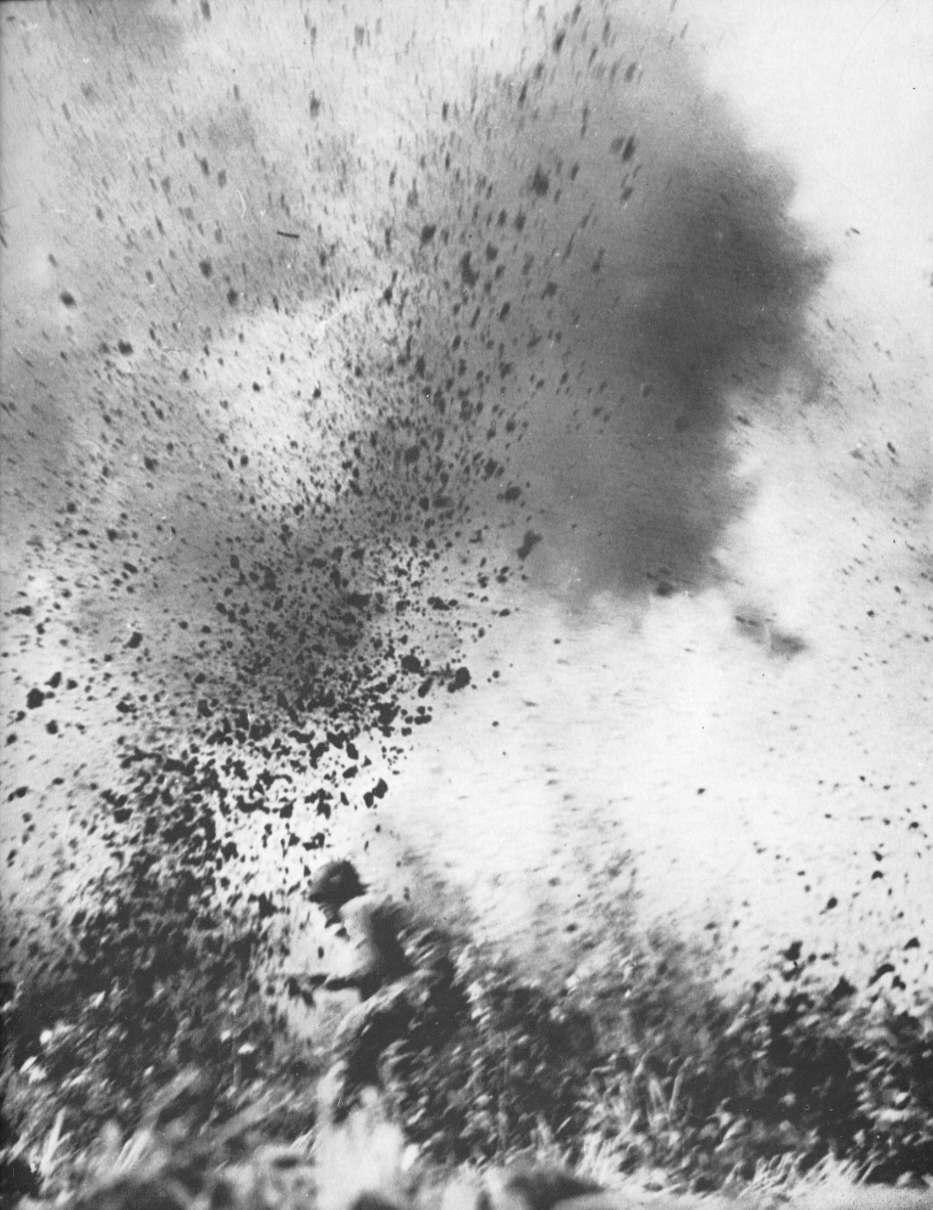
A paratrooper in Holland
under fire
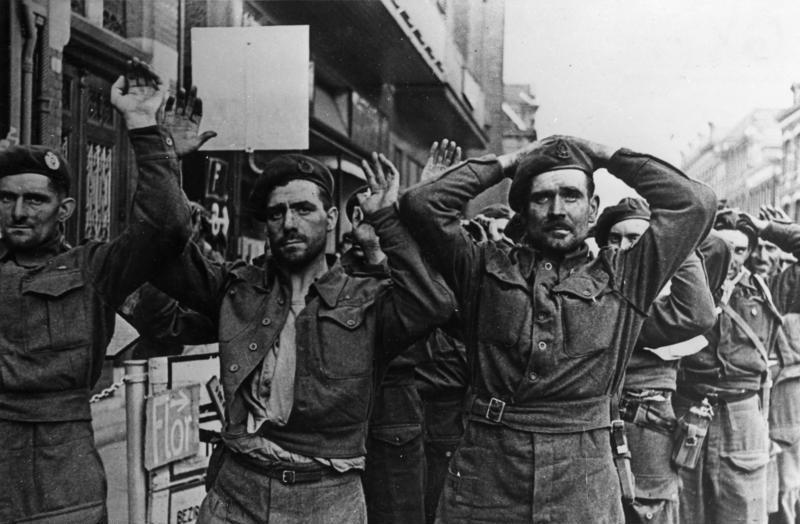 British prisoners taken at
Arnhem by the Germans
British prisoners taken at
Arnhem by the Germans
Deutsches Bundesarchiv

"A U.S. Infantry anti-tank
crew fires on Nazis who machine- gunned their vehicle, somewhere in Holland." W.
F. Stickle, November 4, 1944.
National Archives
111-SC-197367
Meanwhile, elsewhere the
advance against the Germans continues
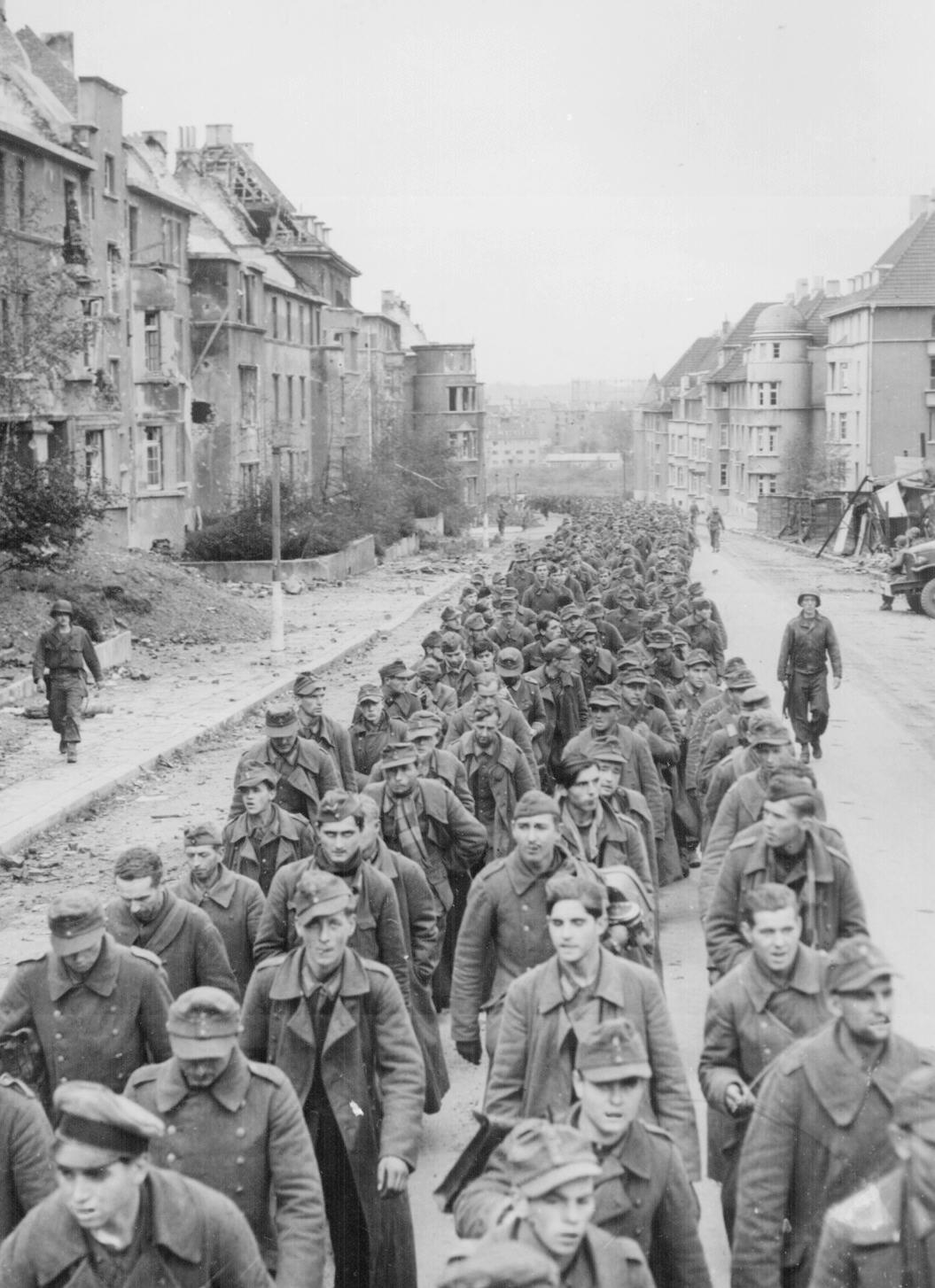
"The endless
procession of German prisoners captured with the fall of Aachen marching through the ruined city streets
to captivity." Germany, October 1944.
National Archives
260-MGG-1061-1
Back in the States ... Roosevelt in his fourth run
for the White House is up against a very
highly respected
Republican candidate, New York Governor Thomas Dewey. But Americans
generally feel that
this is no time to be "changing horses" in the mid-stream of the War
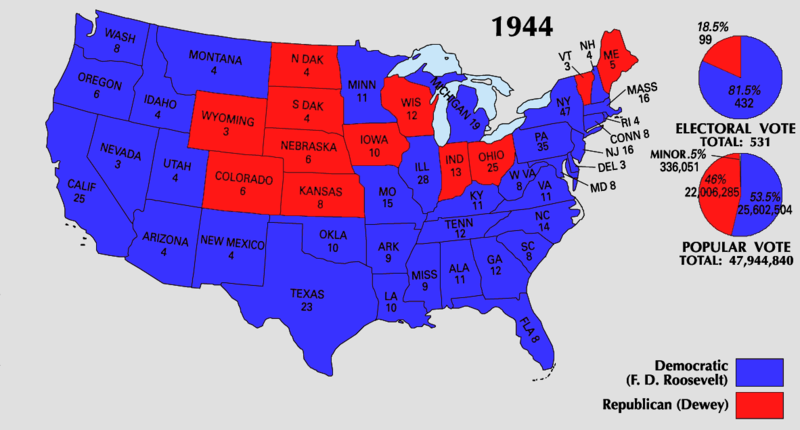 Thus ... Roosevelt is elected to his
fourth term as President.
Thus ... Roosevelt is elected to his
fourth term as President.
Department of the Interior
However ... Roosevelt is
a very sick man - and will not be able to
live out more than a few months of his fourth term in office
THE
BATTLE OF THE BULGE – DECEMBER 1944 |
Then without warning, the Germans, in
an effort to reach and seize the Allied supplies at the
Port of Antwerp, massed a huge counter-blow
in the Ardennes Forest of Eastern Belgium
in mid December – just when and where the
Allies were least expecting any German action
|
In the middle of December 1944, the Germans
totally surprised the Allies with a well-prepared attack on the densely
wooded section of the Ardennes Forest in Belgium, catching the Allies
off guard. ... and thus thrusting deep into Allied lines, thus
creating a
deep bulge in the Allied line of advance. The "Battle of the Bulge" was
thus underway. A dense cloud cover had prevented the Allies from
detecting a huge buildup of German forces at this point in the line
where there had been thus far almost no action ... and thus where the
Allies were spread out very thinly.
The surprise was so complete that in a matter
of a few days German tanks, trucks and infantry had pushed deeply into
the Forest. The German goal was to reach the key port of Antwerp,
shut down the Allies' vital operations there, and seize Allied supply
bases (supplies greatly needed by an impoverished German army) along
the way.
Hitler's generals tried to reason with
Hitler concerning all of the dangers involved in such a move. But
Hitler's mental state at this point was such that he thought himself
totally brilliant as a military strategist and ignored the
warnings. In the end, his advisors proved right. It turned out to
be a grand
disaster for the Germans.
Americans refused to give up the key
crossroads town of Bastogne, despite being fully surrounded by German
troops The Germans knew that they had to take the town or
else their position in the Ardennes was very vulnerable to
counterattack by the Americans.
In quick response to the German action, American paratroops were dropped in the area surrounding the
town ... and ground troops were rushed in from Montgomery’s forces in the
north and Patton’s forces in the south.
At the same time the German forces that
had pushed on beyonmd Bastogne found themselves running out of fuel
(they had failed to sieze the American fuel depots ... or did so only
to find that they had been torched to prevent them falling into German
hands). Thus the German push ground to a halt.
Then on Christmas
Eve the skies cleared ... and Allied planes could begin ruinous attacks
on the German position. The Germans were thus forced to retreat back into Germany ...
now as crippled in the West as they were in the East.
This would be the last grand
attempt of the Germans to hold off the advance of the Western Allies
into Germany. Nonetheless the Germans would continue to fight fiercely
for every piece of ground now that the Allies were entering Germany.
|
The German offensive, 16-26
December 1944
The U.S. Army in World
War II – The Ardennes: The Battle of the Bulge.
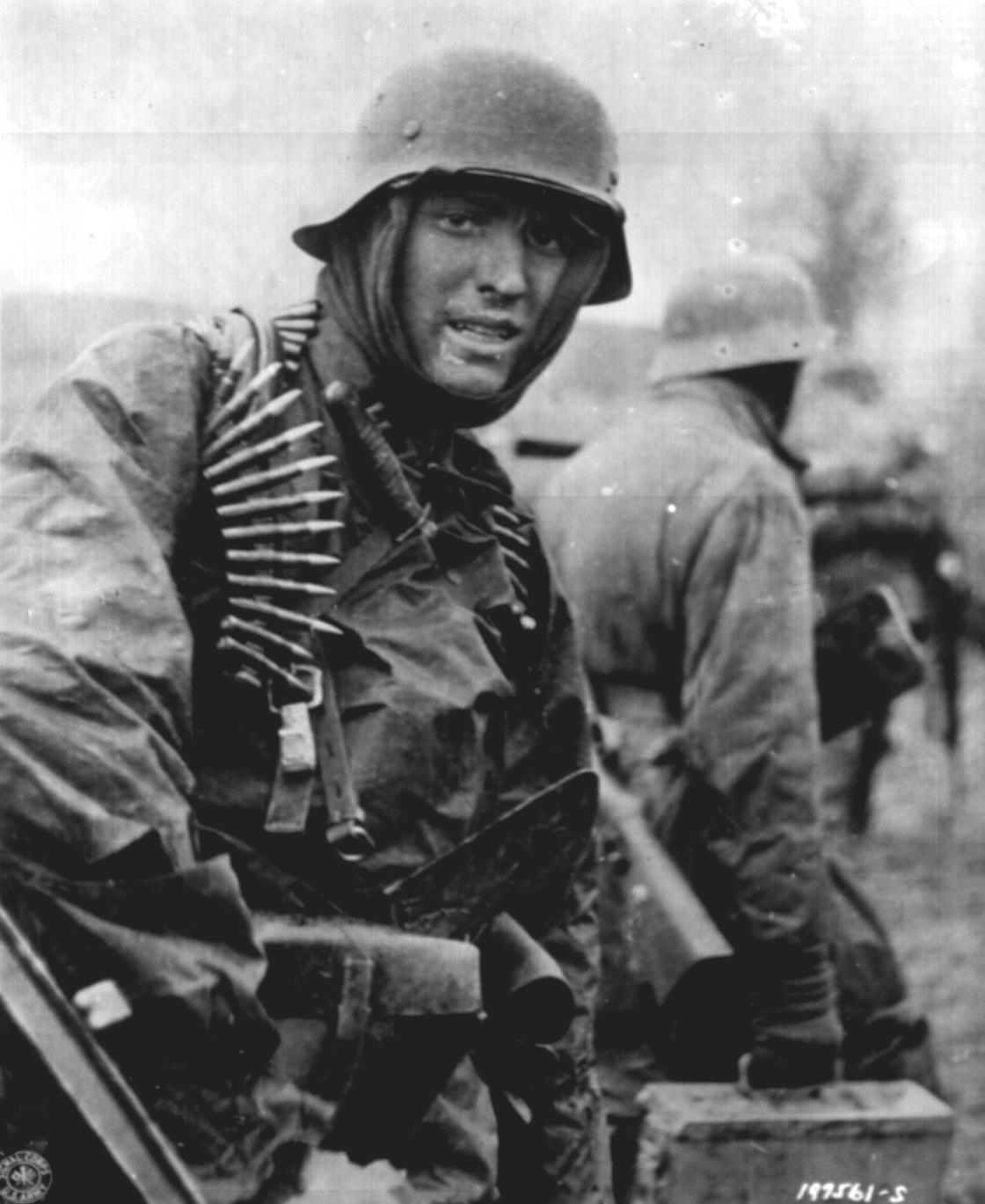
"A Nazi soldier, heavily armed,
carries ammunition boxes forward with companion in territory taken by
their counter-offensive in this scene from captured German film."
Belgium, December 1944.
National Archives
111-SC-197561
American soldiers were caught
completely by surprise
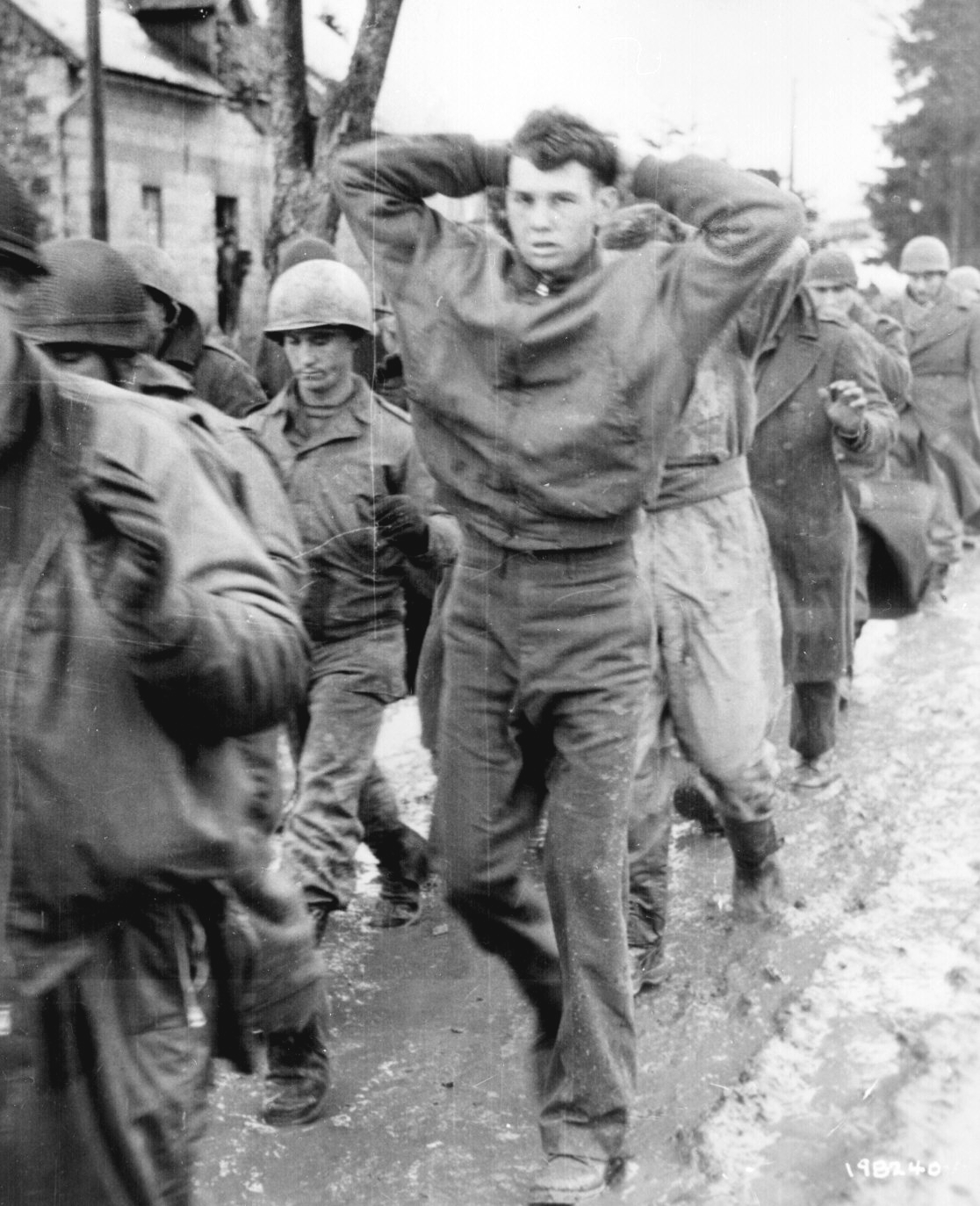
"A lanky GI, with hands clasped behind
his head, leads a file of American prisoners
marching along a road somewhere on the western
front. Germans captured these
American soldiers during the surprise enemy drive into
Allied positions." Captured
German photograph, December 1944.
National Archives
111-SC-198240
Some of the Germans were
now playing by new rules of war
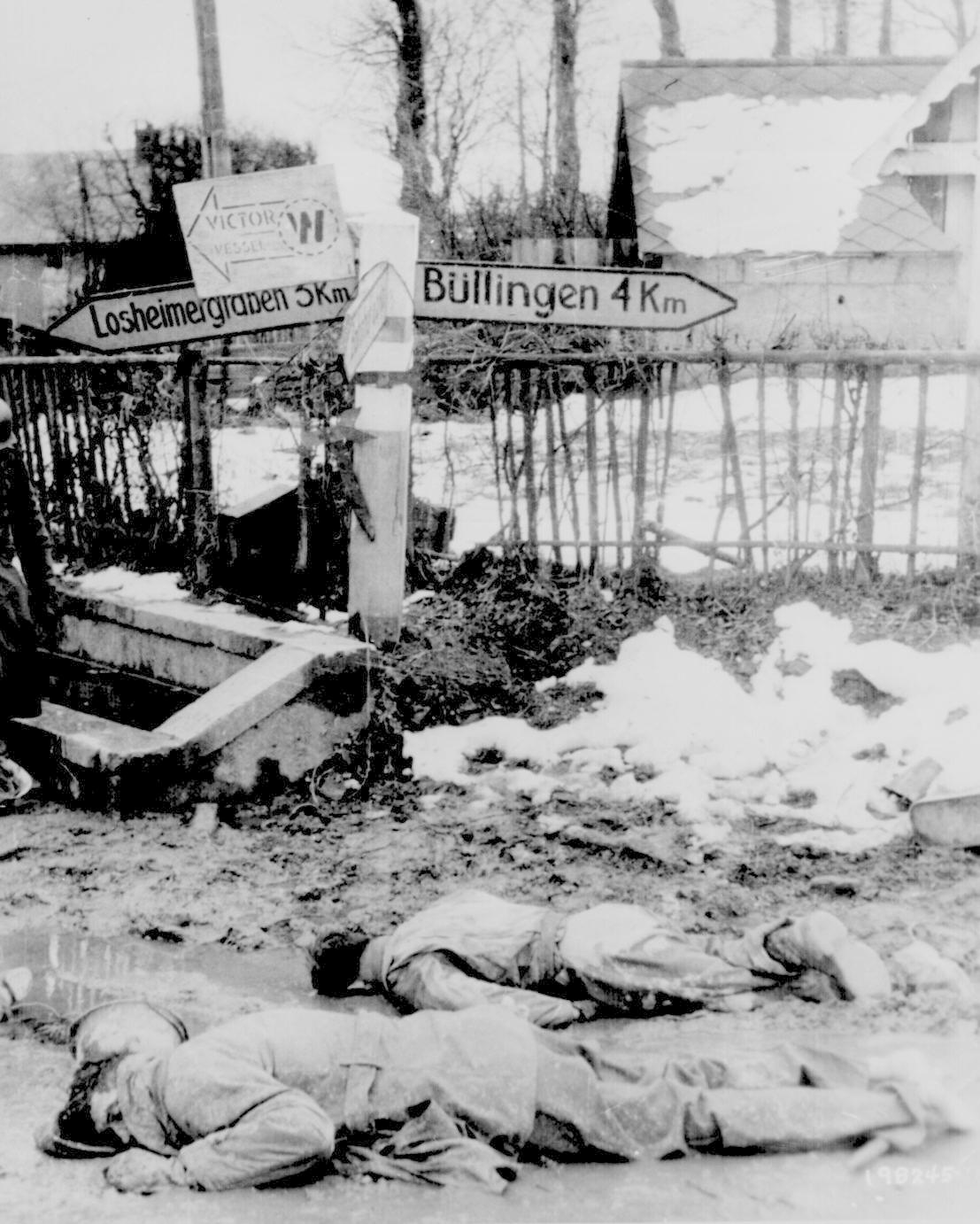
"American soldiers, stripped of all
equipment, lie dead, face down in the slush of a crossroads somewhere on the western front." Captured
German photograph. Belgium, ca. December 1944.
National Archives
111-SC-198245
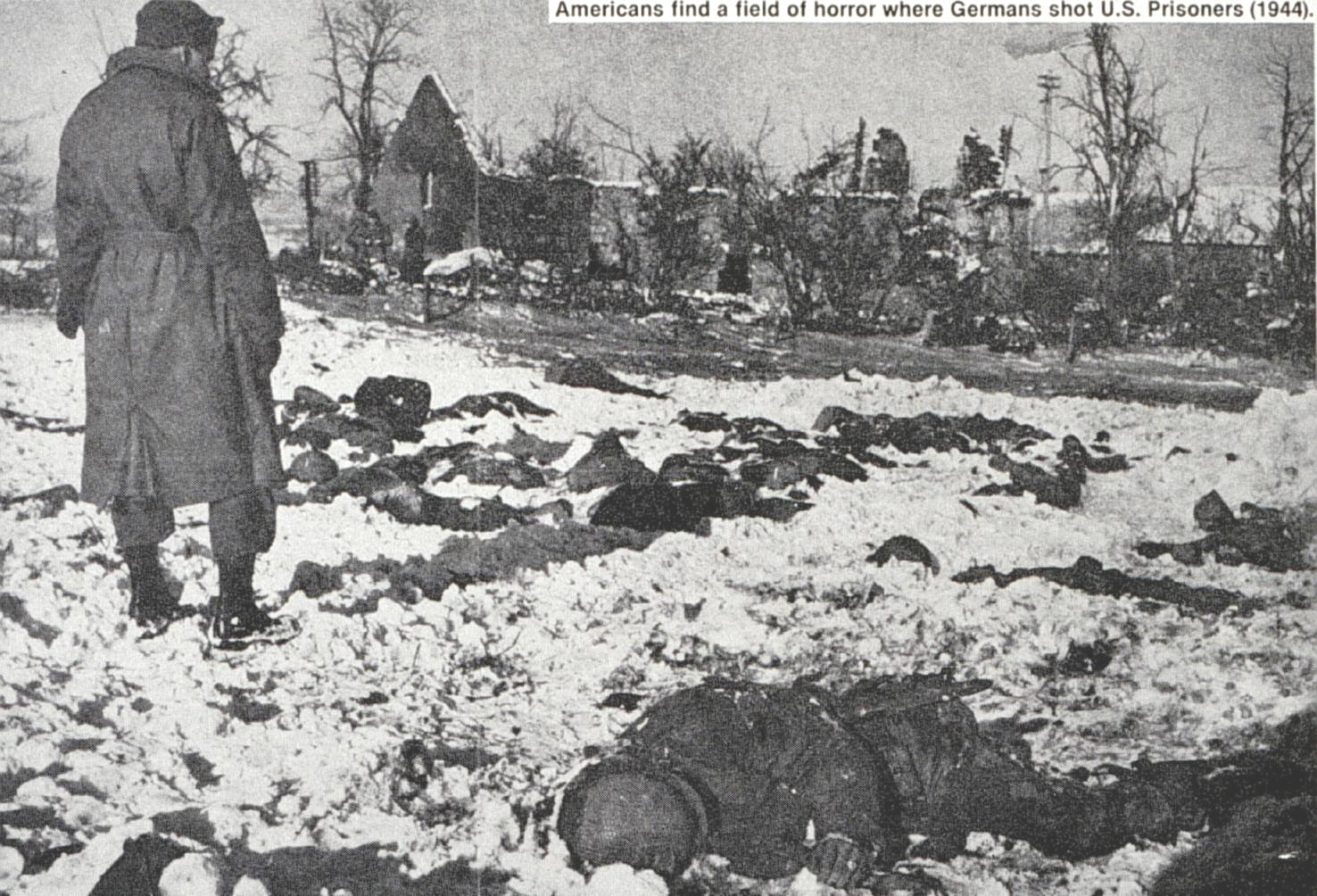
Malmedy massacre - 84 American
soldiers were killed after their capture by SS troops
NOAA's Historic Coast &
Geodetic Survey (C&GS) Collection
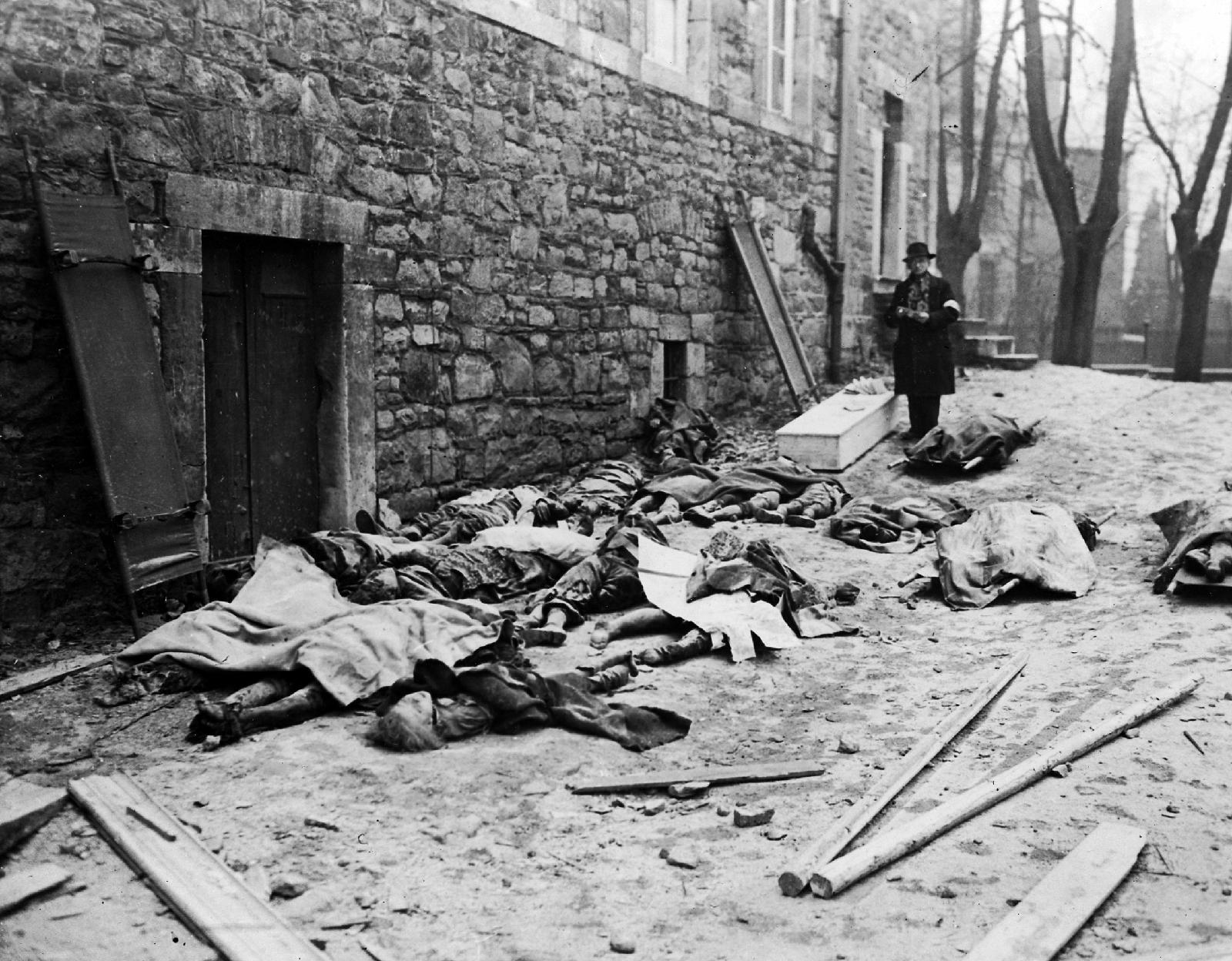
The bodies of Belgian men,
women, and children, killed by the German military during their counter-offensive
into Luxembourg and Belgium, await identification before burial
National Archives
But the American line holds
- notably at the town of Bastogne
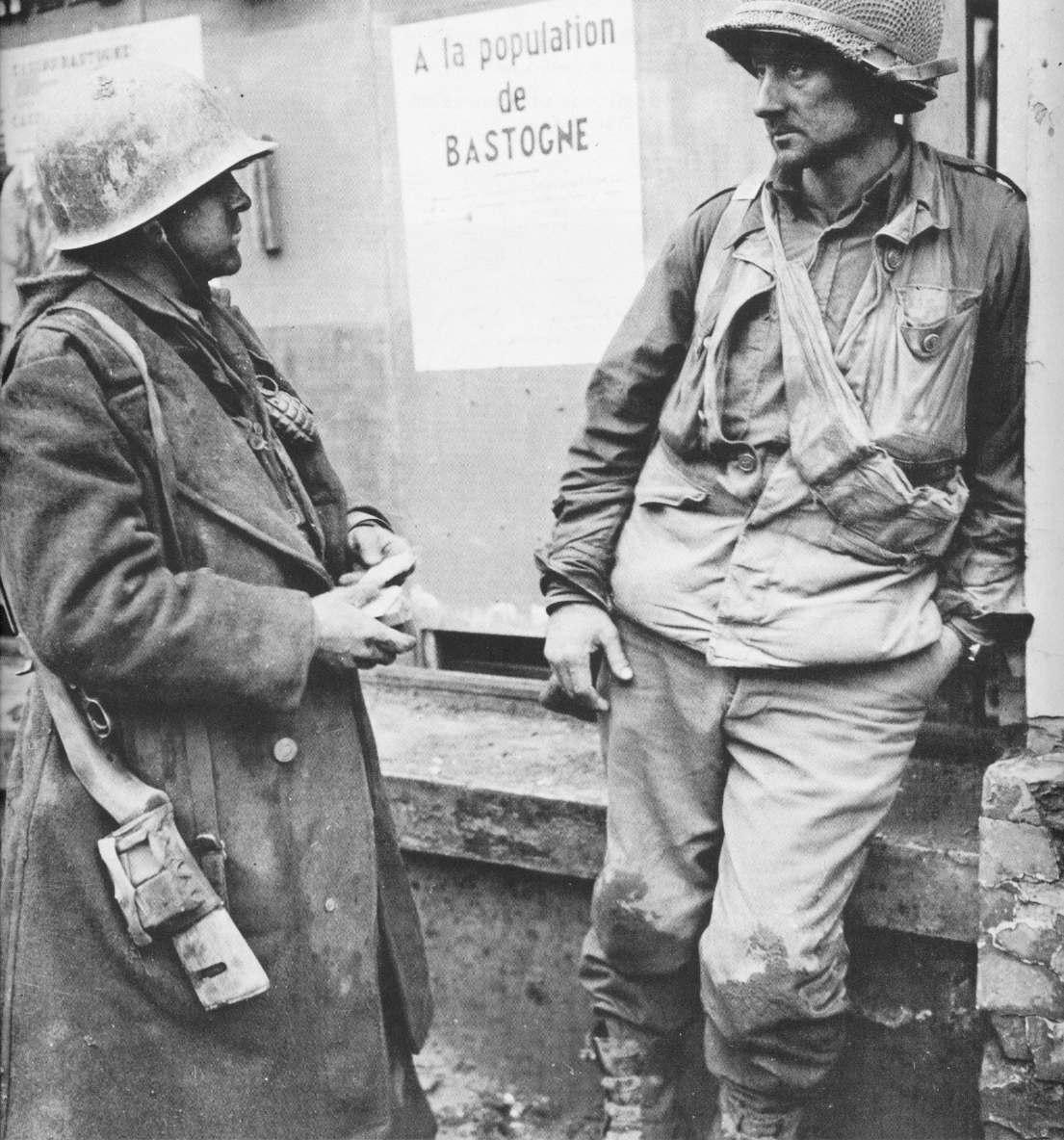
Wearied GIs trapped inside
the Belgian town of Bastogne during the Battle of the Bulge
United States Army
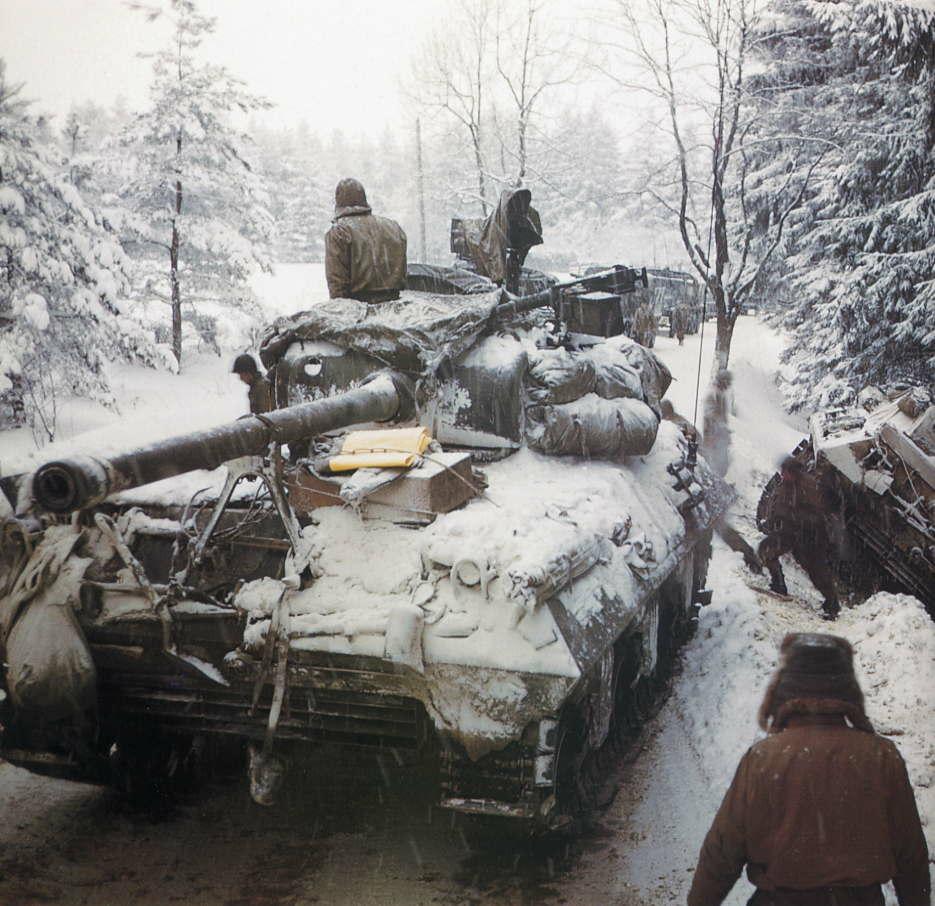
U.S. tanks moving cautiously
through the Ardennes - December 1944
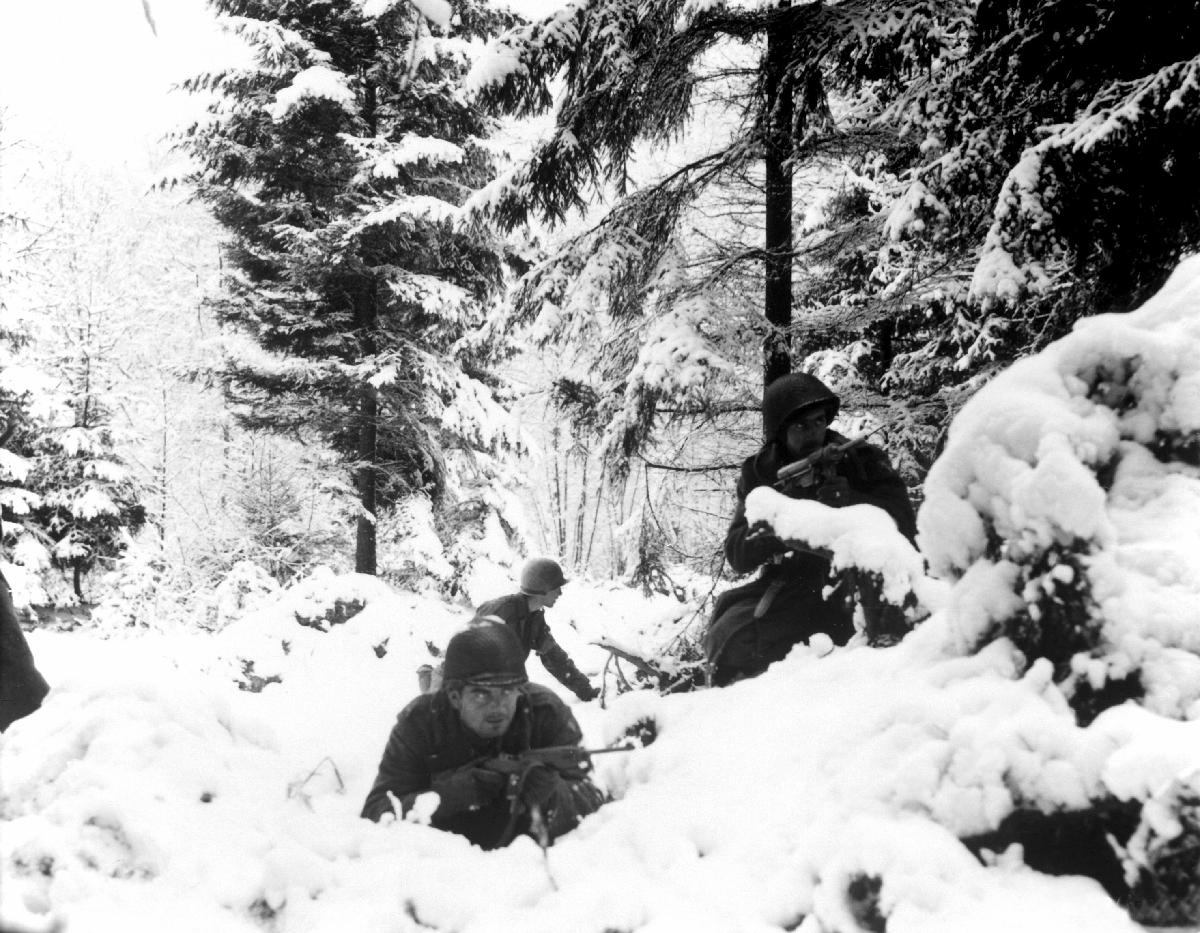
American soldiers taking
up defensive positions in the Ardennes during the Battle of the Bulge
National Archives
 U.S. troops pinned
down in the Ardennes by German troops - December 1944
U.S. troops pinned
down in the Ardennes by German troops - December 1944
U.S. Army
 U.S. 82nd Airborne
helping to relieve US troops caught in the Battle of the Bulge - December
1944
U.S. 82nd Airborne
helping to relieve US troops caught in the Battle of the Bulge - December
1944
U.S. Army
 Miles
H. Hodges Miles
H. Hodges
| | |


 A Western front opened in Normandy,
A Western front opened in Normandy, The Allies liberate Paris at the end of
The Allies liberate Paris at the end of The German V-1 and V-2 missiles
The German V-1 and V-2 missiles
 The Allies swing north into Belgium and
The Allies swing north into Belgium and Then the Germans strike back –
Then the Germans strike back –



















































































